- ~ Home
- ~ Vía de la Plata (The Silver Way)
- Salamanca to Urbanización El Chinarral, Day One
Jump to Vía de la Plata Stages
Vía de la Plata, Salamanca to Urbanizatión El Chinarral, Day One, 22.7 Kilometers (14.11 Miles)
Disclosure: the PilgrimageTraveler.com is an associate of Booking.com, Roamless, and Amazon. As associates of these merchants, we earn from qualifying purchases from our links.
Our first day on the Via de la Plata, from Salamanca to Urbanizatión El Chinarral was charged with energy and excitement, despite the relatively boring landscape as we walked out of the city and into the countryside.
“What drains your spirit drains your body. What fuels your spirit fuels your body.” ~ Caroline Myss, Author, Intuitive and Spiritual Teacher
If you are looking for accommodation in Salamanca, click here. There are many, many choices of places to stay, including the municipal Albergue de Peregrinos, Casa la Calera, which is immediately south of where the route for the day officially begins. We stayed at the Apartamentos Gran Vía, which was very economical for our party of four.
We chose to make this first day an easier one, from the standard 36.5 kilometer stage to El Cubo de Tierra del Vino. In fact the first two standard stages from Salamanca to Zamora total 68 kilometers. Our group's plan, with two Camino newbies, was to take three days for this distance.
🙋♀️ Why Trust Us at the Pilgrimage Traveler?
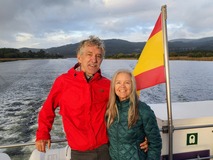
We’re not a travel agency ~ we’re fellow pilgrims! (See About Us)
We've trekked Pilgrimage Routes Across Europe since 2014!
💬 We’ve:
- Gotten lost so you don’t have to. 😉
- Followed waymarks in the glowing sunlight, the pouring rain and by moonlight. ☀️🌧️🌙
- Slept in albergues, hostels & casa rurals. Ate and drank in cafés along the way. 🛌 😴
- Created comprehensive and downloadable GPS maps and eBook Guides, full of must-have information based on real pilgrimage travels. 🧭 🗺️
- Shared our complete journeys, step by step to help YOU plan your ultimate pilgrimage and walk with your own Heart and Soul. 💙✨
Every detail is from our own experiences. Just fellow pilgrims sharing the Way. We have added a touch of spirituality, heartfelt insights and practical guidance from the road ~ offering a genuine connection to the spirit of pilgrimage. Tap into the wisdom of seasoned pilgrims!
Ultreia and Safe Pilgrimage Travels, Caminante! 💫 💚 🤍
Maps and Stats of Day One on the Vía de la Plata, Salamanca to Urbanizatión El Chinarral
Here is a Google interactive map for the day, created from my GPS tracks. I have placed essential services on the map for your planning. There are plenty of services in each town as you can see, but no inexpensive accommodations until Calzada de Valdunciel, about 16 kilometers into the stage. However, it is always advisable to carry water in this hot, dry region, as well as snacks.
Please note that the private Albergue Casa Saso is currently closed, and the only place to stay at the end of this stage is now the expensive Castillo del Buen Amor, a few kilometers onward.
However, I have kept this stage the same for two reasons. This is such a great place for a break in the very long stage from Salamanca to El Cubo de Tierra del Vino and I am hoping the Albergue Casa Saso reopens again in the near future!
One can easily shorten or lengthen this stage to find suitable accommodation without having to walk the 37 kilometers all the way to El Cubo!
The elevation profile for the day is shown below, and it looks like some ups and downs, but the change in elevation is less than 100 meters (328 feet), so looks are deceiving. The entire stage feels almost entirely flat. It is an easy walk, and if this is not your first stage, most likely, you could easily go farther. The remaining 14 kilometers to El Cubo de Tierra del Vino to complete the standard stage (see day two) is also essentially flat.
👣 Camino Sanabrés EBook:
Offline Guide with Bonus Route
~ Includes 4-5 additional days on the Vía de la Plata from Salamanca!
Walk smarter with our ad-free, beautifully formatted Camino Sanabrés eBook Guide, perfect for offline use ~ important in the mountainous and remote areas. Includes daily stage details, stunning photos, historical background and a BONUS digital guide on the Vía de la Plata from Salamanca, called the Camino Fonseca. This allows you the opportunity to add 4-5 more days to your Camino in the beginning.
Don't carry a hard copy guide book to increase your pack weight. Use our frequently updated digital guide on your next Camino instead!
📲 Instant download. 💸 Money-back guarantee. 🔄 Free updates for 1 year.
👉 Click here for more info or BUY NOW!
Jump to Vía de la Plata Stages
Photo-Rich Travelogue of Day One on the Vía de la Plata, Salamanca to Urbanizatión El Chinarral
We got an early start, at daybreak, which in Spain in October is not until 8:00 in the morning. The start is at the cathedral of Salamanca and here is a photo of it from the night before. It was not lit in the morning we were there. The municipal Albergue Casa la Calera is just behind the cathedral to the southeast (check the interactive map), if this is where you are starting your day.
From the Plaza de Anaya, on the north side of the cathedral, walk northward on the pedestrian street of the same name (Plaza de Anaya). After about 125 meters, you will see the distinctive House of Shells, the Casa de las Conchas. By the entrance to this house is the lit, large Camino shell sculpture that I referenced in the introduction. I am calling this the "official" start of the Camino Fonseca, that is the historic route of Don Alonso de Fonseca y Acevedo III, a 16th century Archbishop of Santiago de Compostela (see intro for this as well). This Camino Fonseca goes between Salamanca and Santiago. Below is a photo of Rich and I at the shell.
Returning to the Plaza de Anaya street, we walked through the lit and silent streets about another 200 meters, now along the Calle Mayor, until reaching the Iglesia de San Martín de Tours at a T-intersection, not pictured. The Way is not well-marked here, but essentially, you go straight onward towards a small plaza and to the left side of the church.
You then walk through the small Plaza de Corrillo, lined with restaurants. Follow the street around the side of the church and see the archway ahead leading you into the Main Plaza, the Plaza Mayor, an enclosed 18th century Baroque marvel.
Walk northward across the main plaza, shown next. The plaza is not quite 1/2 kilometer from the cathedral. The Way goes through this pictured archway, on the north and central end of the plaza. There is a scallop shell on the pavement as it points to the Calle Zamora (Street to Zamora), the pedestrian street you will be walking on next.
The shell waymarks on the pavement are sparse in the center of town, which is why I am giving you a detailed description of the route through the city.
Once you pass the Plaza Mayor, just outside of the center, tourist area, there are many, many open cafe bars for breakfast if you need. We had a full, cooked breakfast in our Apartamento Gran Vía so we did not need to stop.
Walk along the Calle Zamora for another 1/2 kilometer and past the backside of this landmark church, the Iglesia de San Marcos.
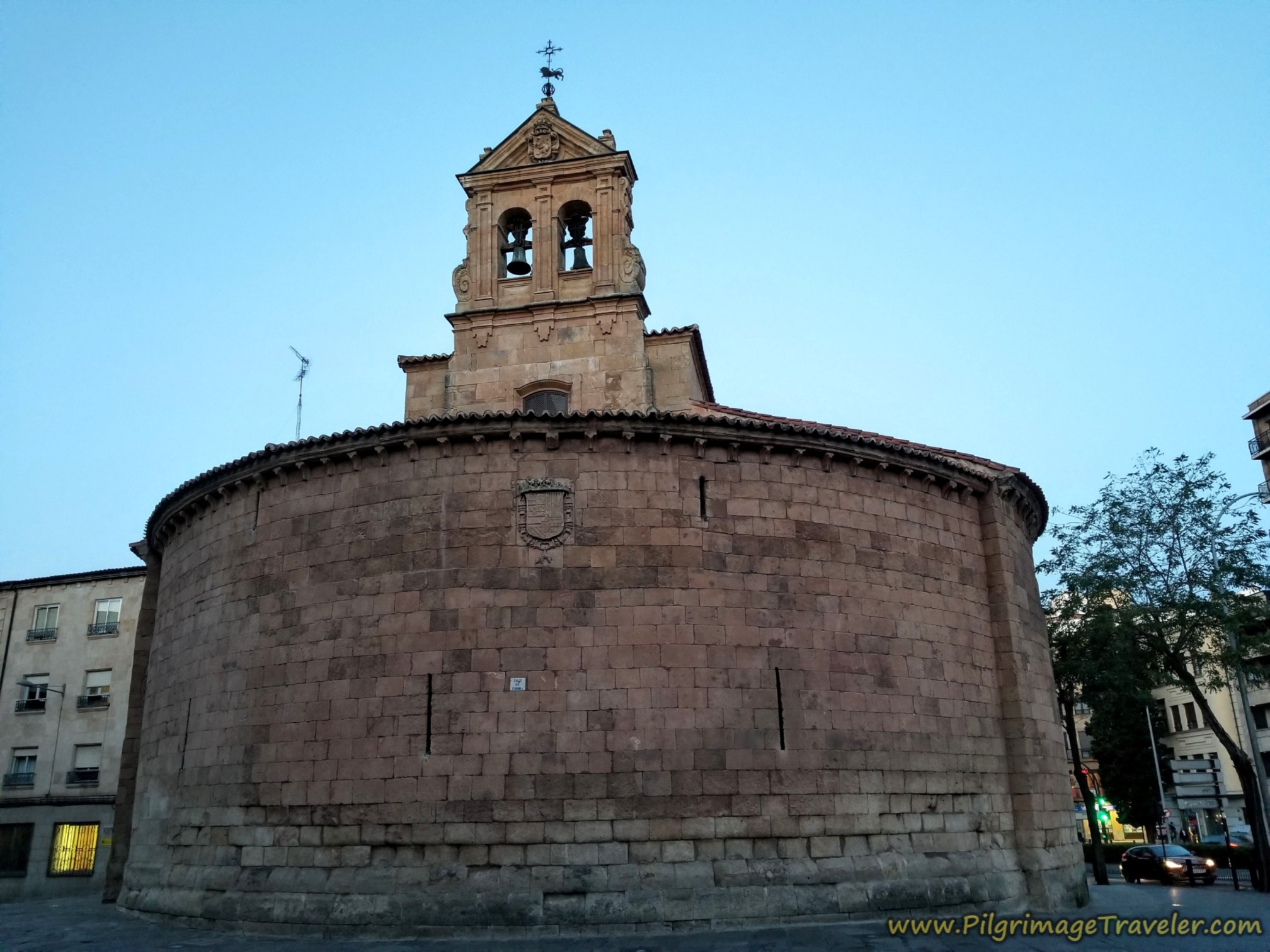 Landmark Iglesia de San Marcos
Landmark Iglesia de San MarcosBy the church is your first large roundabout, where Zamora Street ends as well as the pedestrian walkway and you join the N-630. It is essentially a straight shot northward through the rest of Salamanca from here.
It is the easiest to circumnavigate the roundabout to the right (east) side.
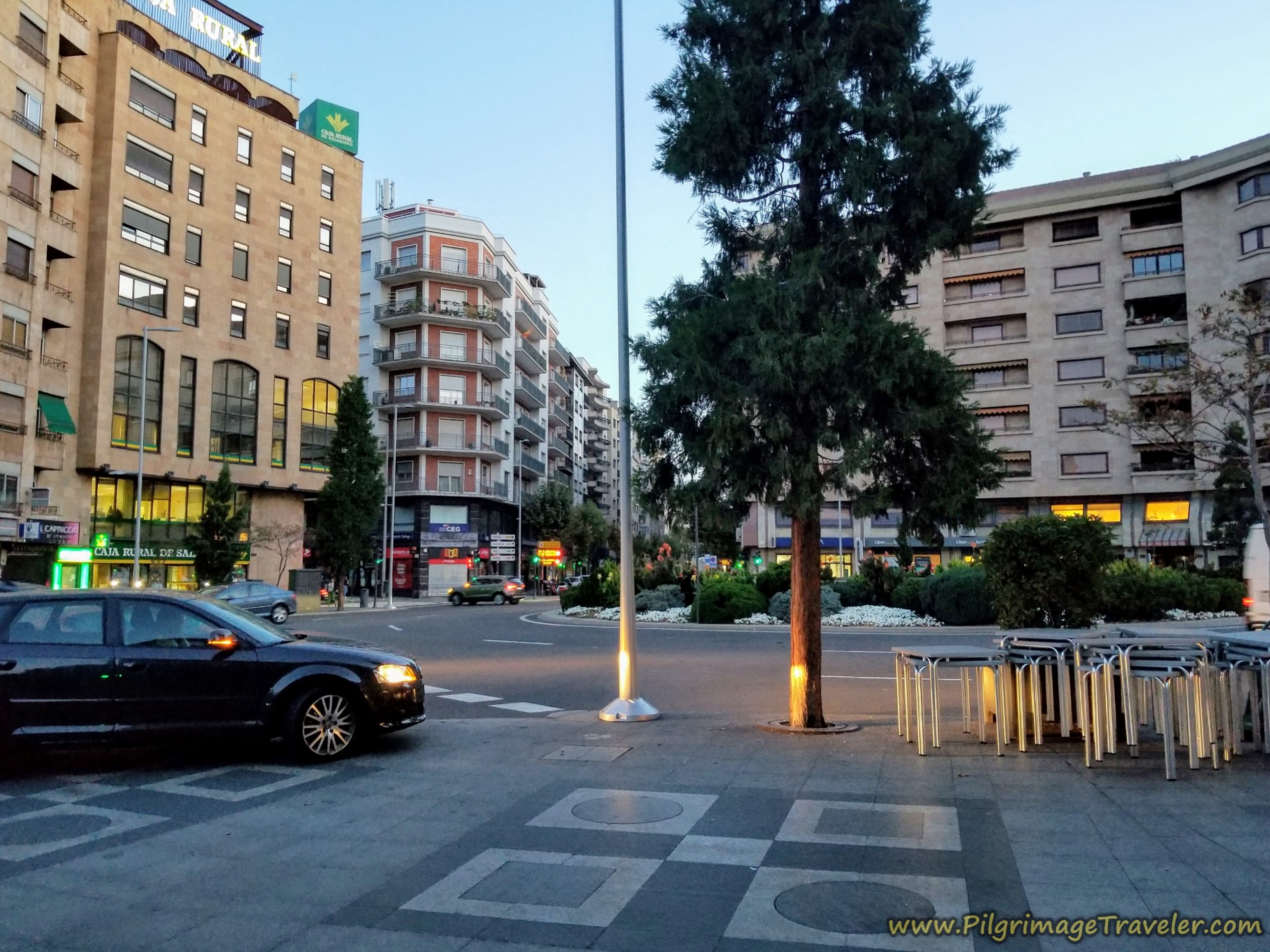 First Roundabout
First RoundaboutContinue northward along the N-630 for another 1/4 kilometer to the next, smaller roundabout with a white, spherical metal sculpture. Pass again on the east side.
Continuing along the highway is not so bad here, as there is a wide pedestrian way to the far right of the street, just discernible in the photo below, on the far right side. This sort of pedestrian frontage way shelters you nicely from the busy street.
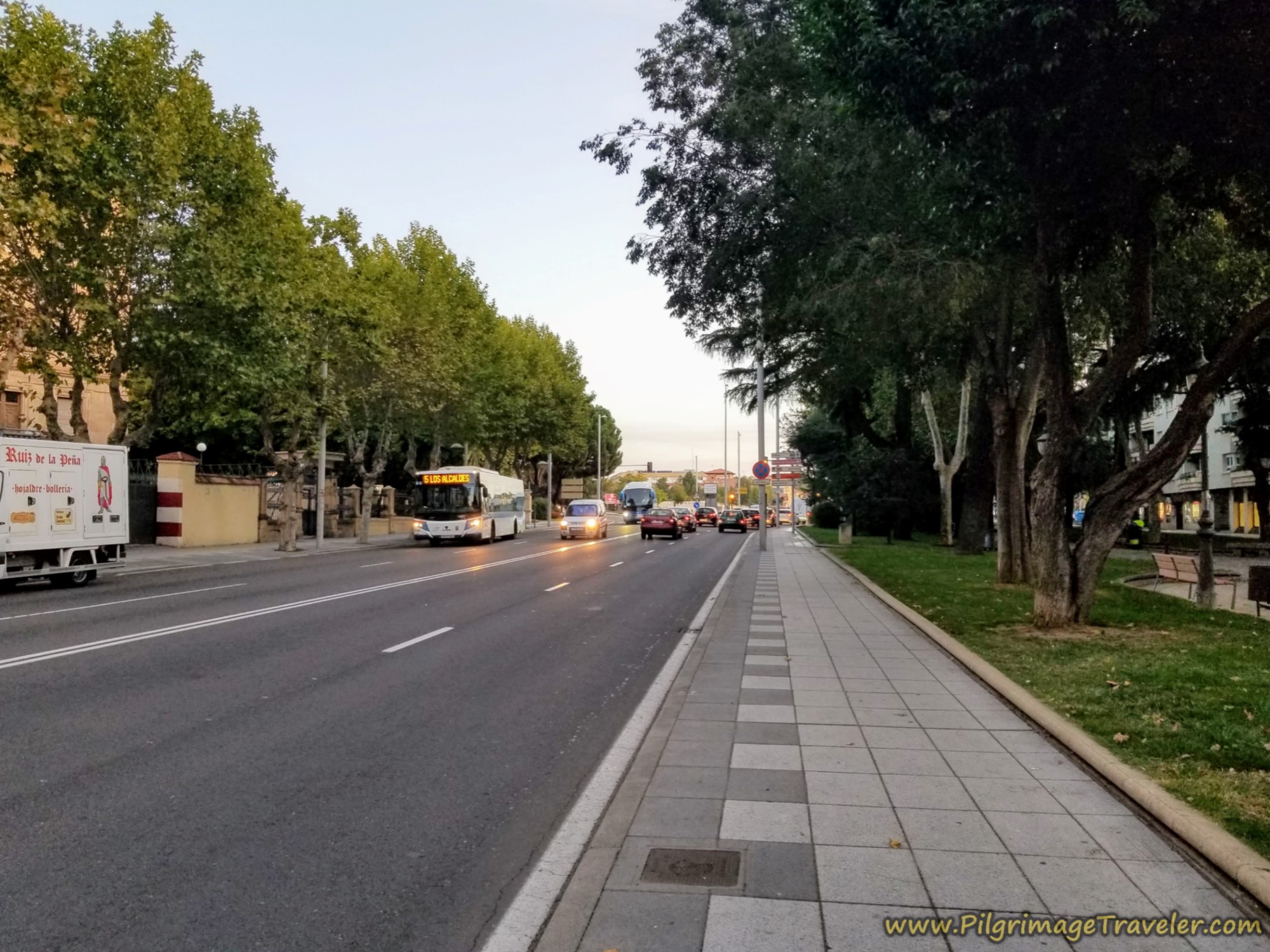 Along the N-630 Through Salamanca
Along the N-630 Through SalamancaPay attention in the next 1/4 kilometer, as there will be a Y-intersection coming up with another large roundabout with a bull sculpture in the center, shown below. It is at this roundabout where you must walk left to stay on the N-630, following the signs to Zamora. I did not see any Camino waymarks before the intersection.
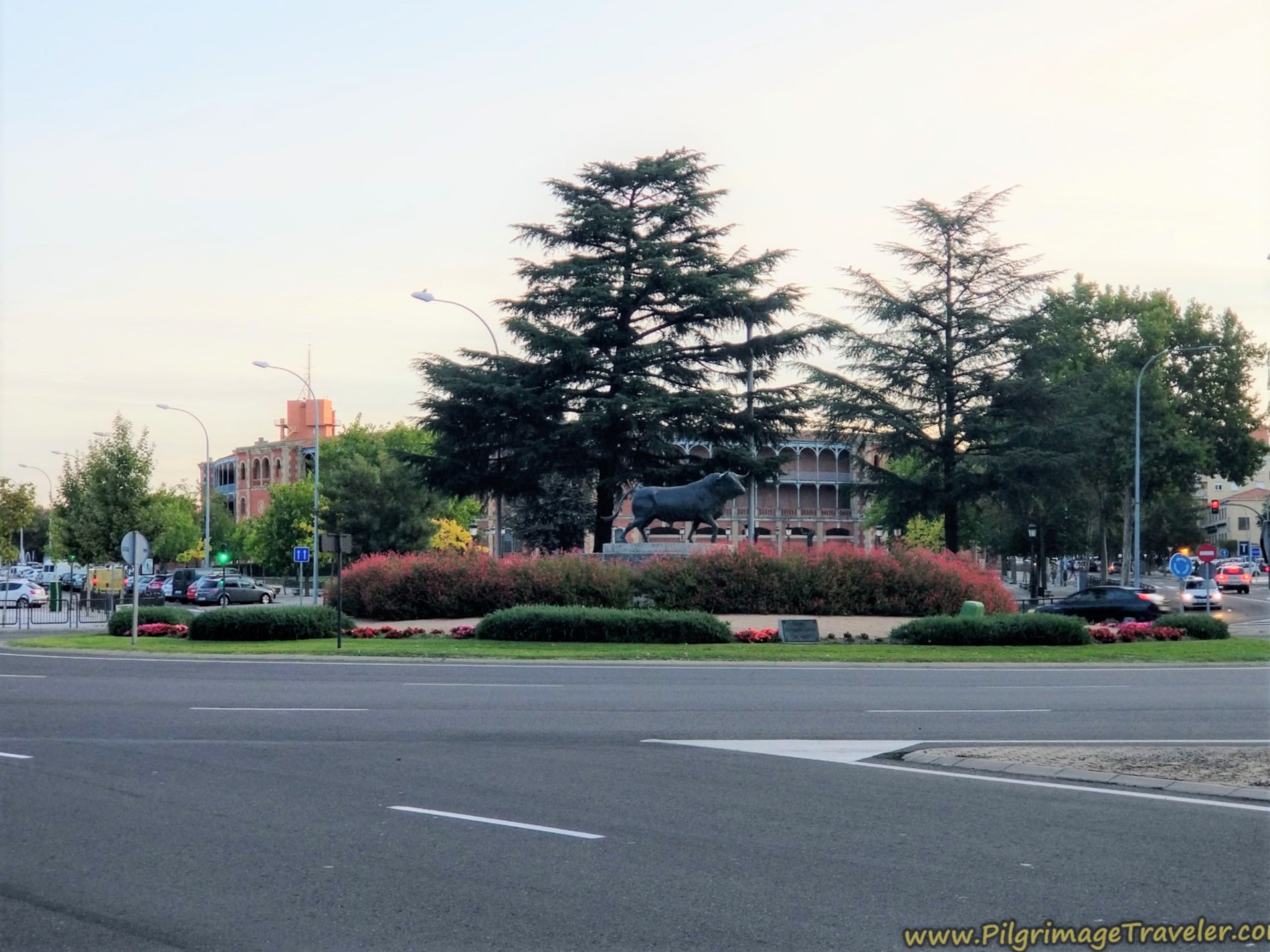 Bull Sculpture in Roundabout
Bull Sculpture in RoundaboutThere is a shell here on the pavement, but only after you turn left at the roundabout. The shell now confirms the turn, but you must anticipate it.
Follow the N-630 for another 300 meters or so after the bull sculpture until you see a large Repsol gas station just before yet another big roundabout.
It is in front of this Repsol station that you will first see a green bike path crossing in front of you, traveling east-west.
Make sure you cross over to the gas station if you are not already there, because the bikeway you need to follow will branch off to the left, along the east side of the roundabout and continue northward from there. After the roundabout, you will pass the first large Camino de Santiago sign to assure you that you are on the correct path. The signage will now be more frequent from here.
When the sidewalk ends after the roundabout, there is a lovely accompanying paved walking path by the bikeway.
There is a large Carrefour supermarket just ahead a few meters on the left (west) side, if you haven't yet stocked up your pack for the day, or you need a few last minute items. It should be open by 9:00 a.m.
Within about 600 meters more, you see the sign below, letting you know that you have now left the city proper. At this juncture, we had logged about 3.0 kilometers into our day on the Vía de la Plata from Salamanca to Urbanizatión El Chinarral. The road is wide open from here.
Jump to Vía de la Plata Stages
Continue along the N-630 northward for another 2.5 kilometers, walking through many roundabouts along the way, the first of which we spied our first yellow arrow painted on a post! One of the roundabouts is through the large interchange with the A-62. It is always easiest to pass through these roundabouts on the right (east) side. On the way, walk through industrial areas and finally the buildings and the sidewalks end.
After the sidewalk ends you can walk safely on the left shoulder of the road, until you come to this intersection, below. Here you are directed with a yellow arrow to turn left onto the dirt road. You have walked about 5.5 kilometers into your day at this intersection.
In a few meters, after cresting a small hill, you can see the next town of Aldeaseca de la Armuña ahead.
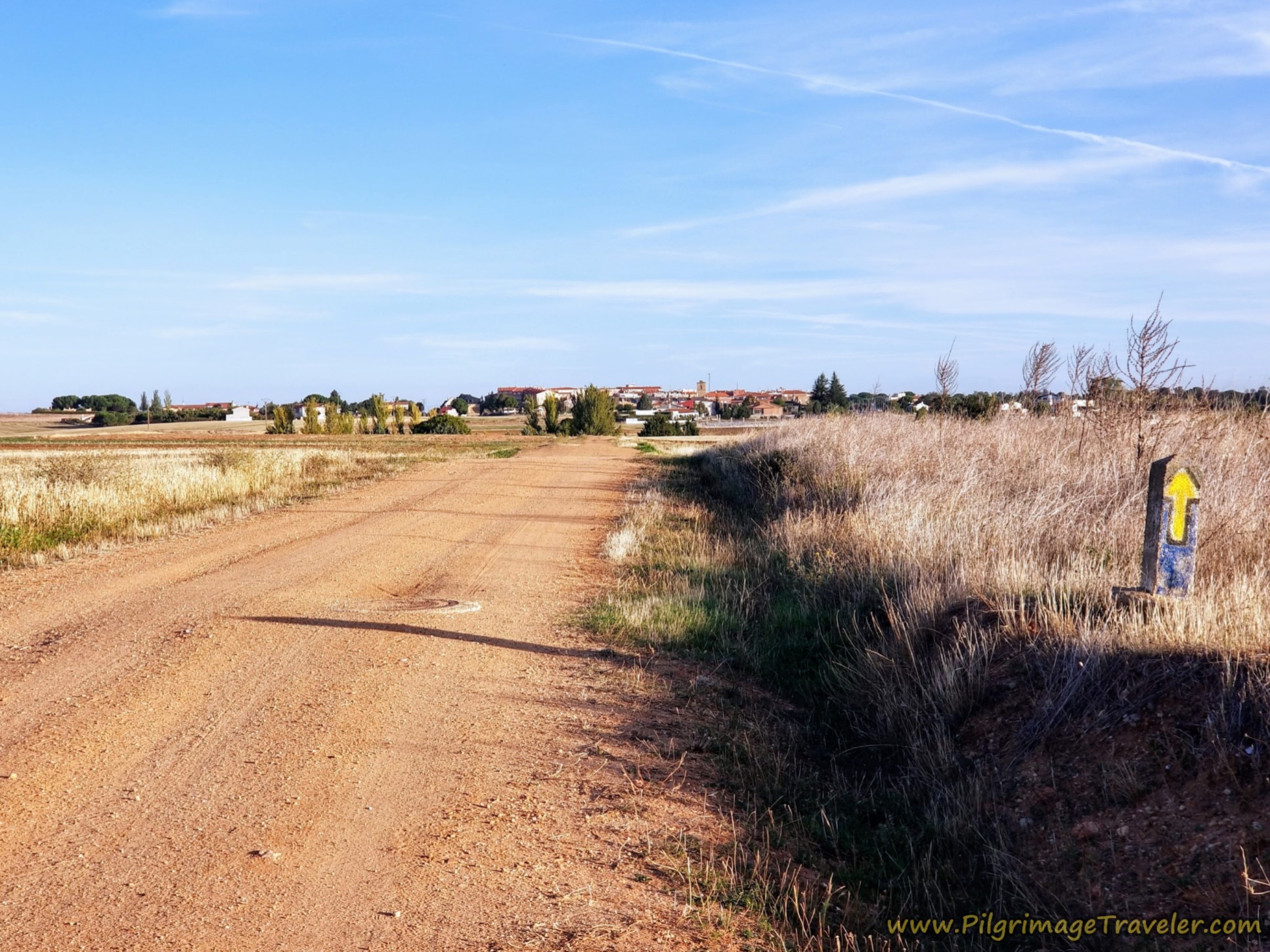 Aldeaseca de la Armuña Ahead
Aldeaseca de la Armuña AheadEnter the town after about one kilometer from the turn-off. First pass by the park, then enter into the center. Keep heading straight until you can see the church on your left, the dominant feature in the town's landscape. Head left toward this church, by turning left onto the Calle Campillo. At the church, the Iglesia Parroquial de Santa Cruz, you are about 6.9 kilometers from Salamanca.
After the church, a few meters off Camino, there is a bar. It should be open after 9:00 a.m., but after only about seven kilometers into the day, we were not interested in stopping quite yet.
Continuing past the church on the north side along the Calle Iglesia, take it a few hundred meters westward and out of town. You will encounter a yellow arrow telling you to turn right onto a secondary paved road.
Take this road onward and through the overpass of the A-66, 1/2 kilometer later, shown below.
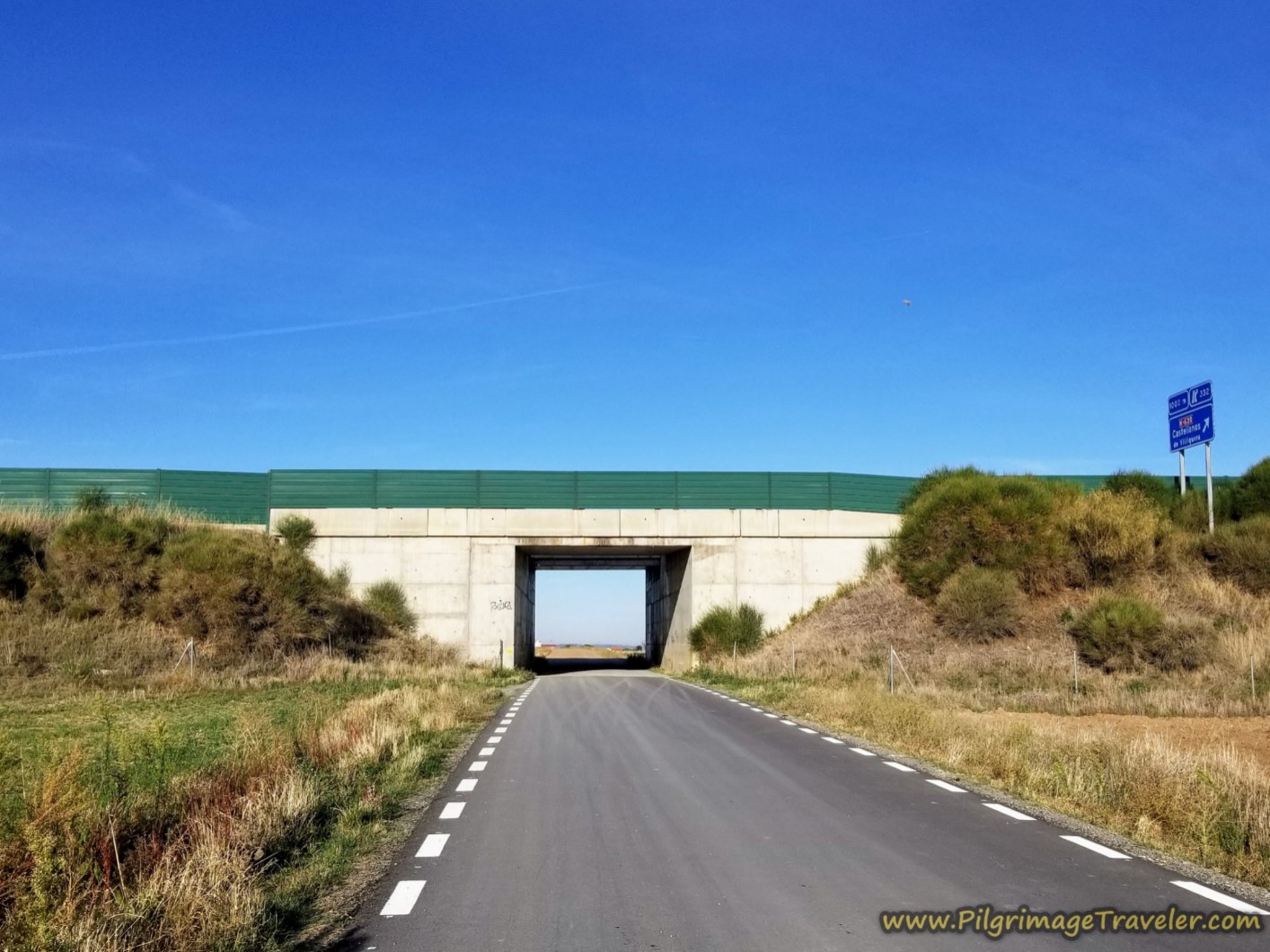 Overpass of the A-66
Overpass of the A-66The road turns to dirt after the bridge and is wide open as it travels westward. If you look over your right shoulder to the north, you can see your next destination, the town of Castellanos de Villiquera, and its church and water towers rising prominently, three kilometers away.
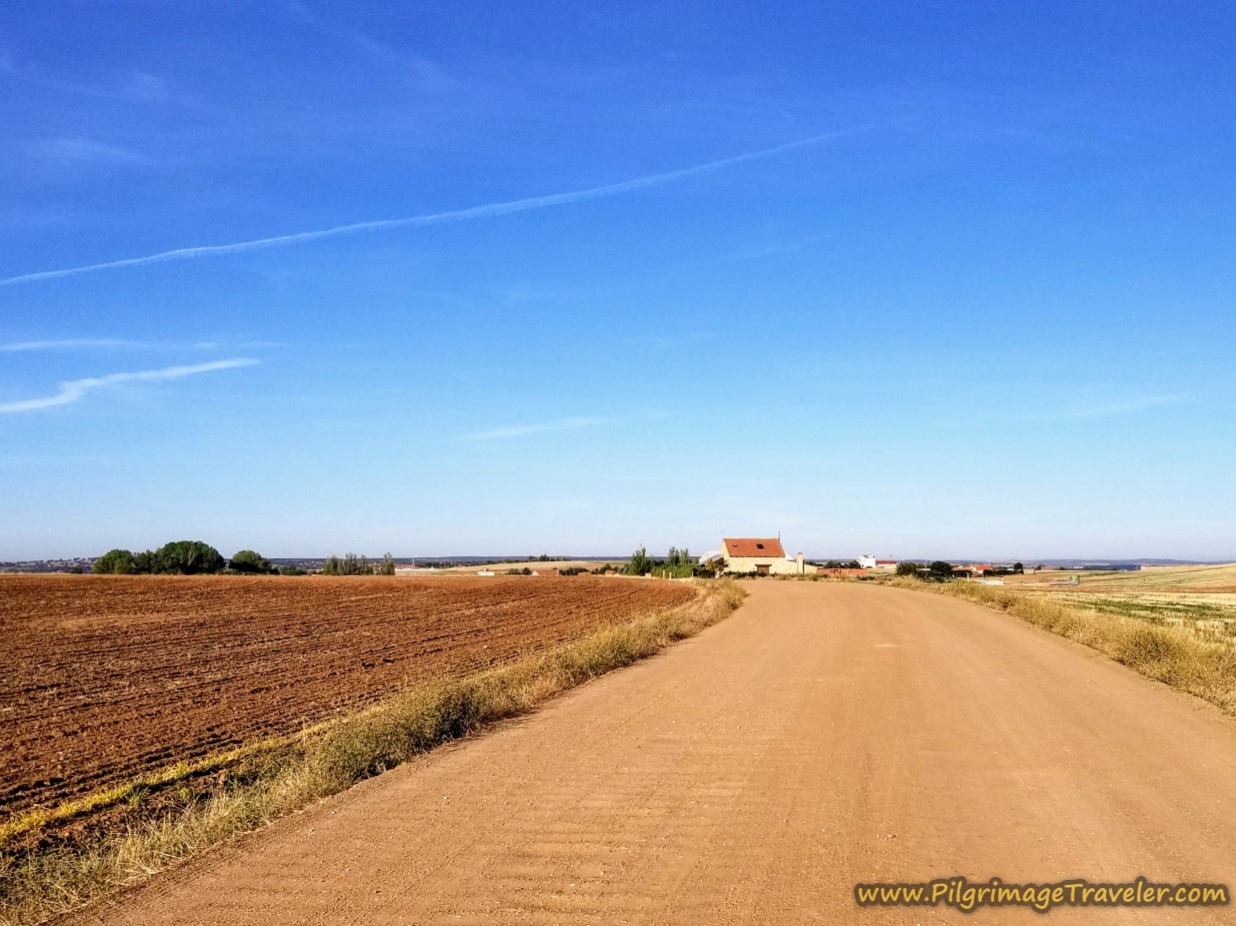 Open Dirt Road Westward
Open Dirt Road WestwardIn yet about another 3/4 kilometer, at this 5-point intersection, take a hard right, following the yellow arrow onto the Camino de Castellanos.
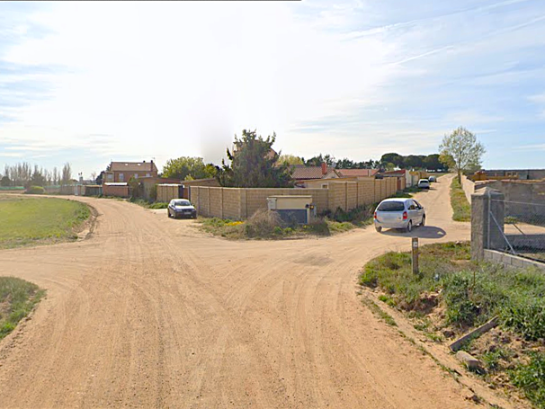 Right Turn at 5-Points
Right Turn at 5-PointsThe road from Aldeaseca de la Armuña to the next town of Castellanos de Villiquera, has some undulating hills. With light hearts and feet, here is our friend Norm and my husband Rich negotiating the first rise.
And on the other side, here I am negotiating the downslope toward one of the few stands of trees we would pass on the first day of the Vía de la Plata from Salamanca to Urbanizatión El Chinarral.
These trees designate a crossing of a drainage.
At the next rise, we could clearly see Castellanos de Villiquera in the distance. I validated to myself that indeed we could see the bell tower of the church and the water tower rising prominently, almost since leaving Aldeaseca de la Armuña.
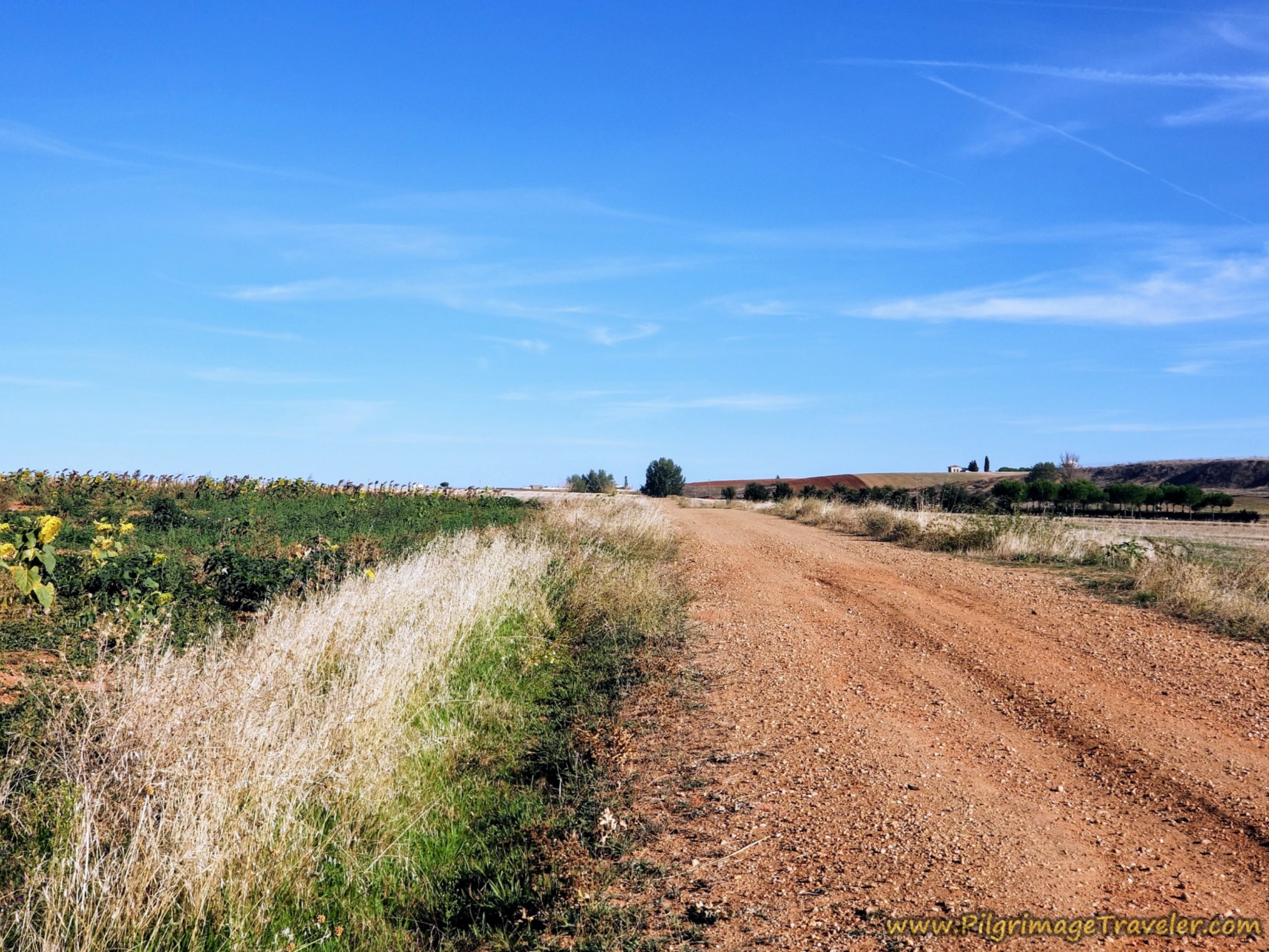 Castellanos de Villiquera in the Distance
Castellanos de Villiquera in the DistanceSomeone left this smiley face for us pilgrims, as we passed by a sunflower field. It also fueled our spirits!
After about 3.0 kilometers on the lonely Camino de Castellanos, you come to an athletic field, at the left side of the road. The road now turns to pavement, and you take a left turn towards town.
Next comes a basketball court that you will pass by.
At the southern tip of town, about 1/2 kilometer after the basketball court, the building that is just below the large, open, covered shed shown below, is painted brightly, depicting women washing clothes in the traditional way, in the town fountain. I love these types of artwork along the Way. More fuel for the spirit!
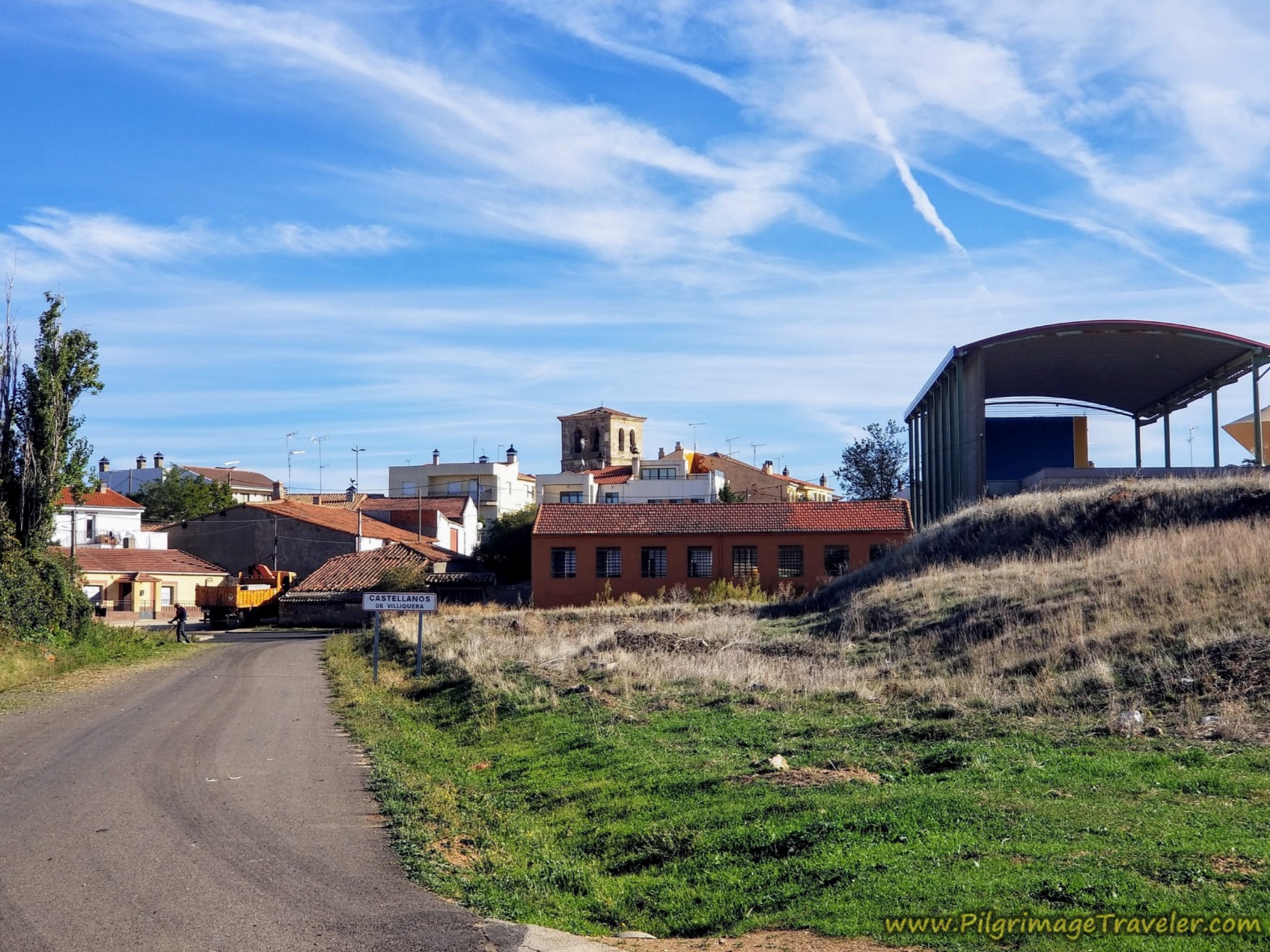 Entering Castellanos de Villiquera
Entering Castellanos de VilliqueraThe Camino turns to the left at the painted building, shown below. The building above it is now painted as well, and there is a water fountain beside it.
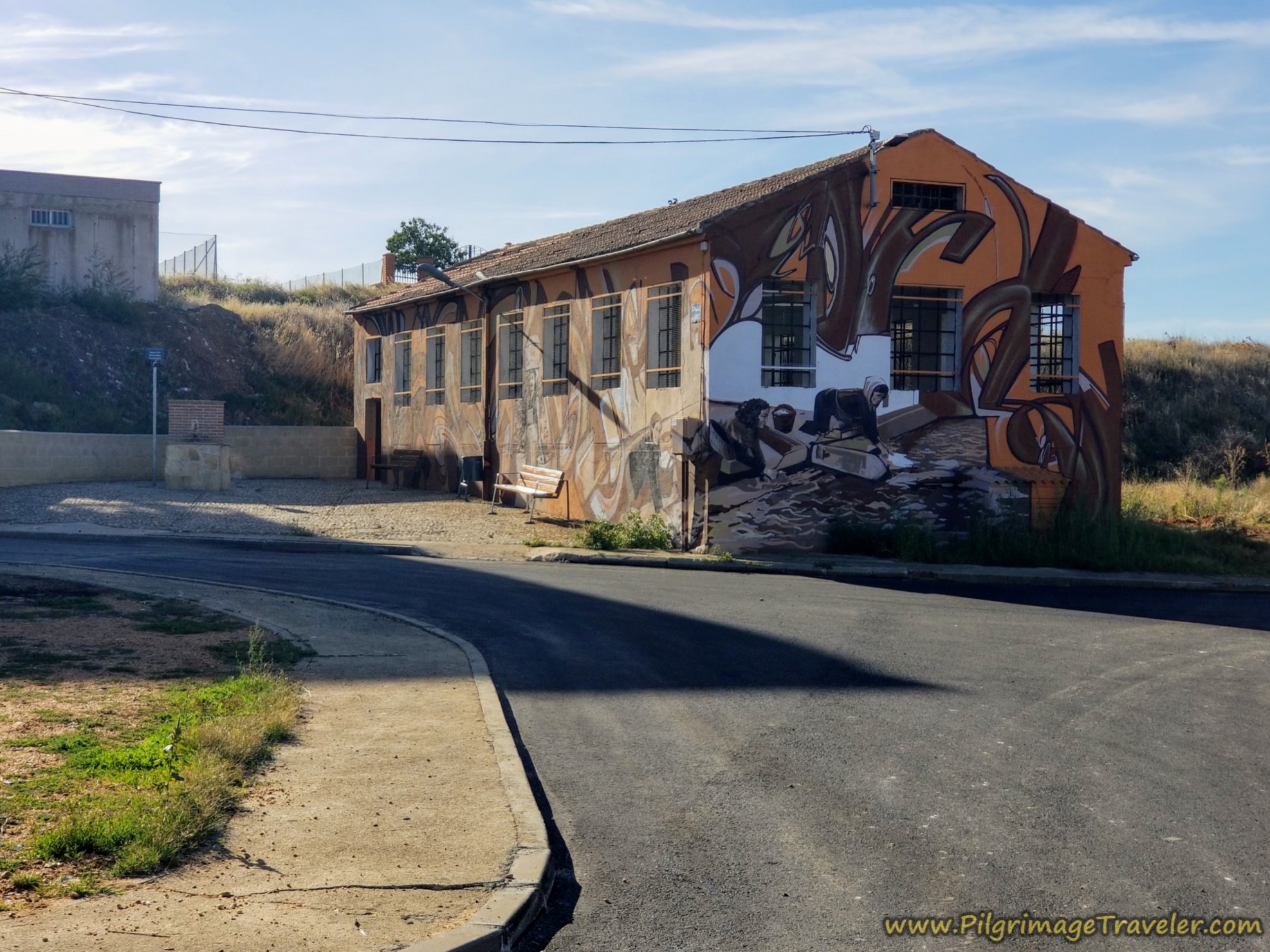 Painting of Women Washing in a Fountain
Painting of Women Washing in a FountainThe center of Castellanos de Villiquera, is about 12 kilometers from Salamanca towards Urbanizatión El Chinarral on the Vía de la Plata.
We were ready for a break and were looking for a café bar. When I inquired of a townsperson, I was told there was none in town, only one another four kilometers down the road in the next town of Calzada de Valdunciel.
There is an accommodation, the Vinarius, Posada Rural (+34 658 86 45 19), just north of the town square if your day should end here. Also near town, ½ km off-Camino is La Casona de Sergio, (+34 649 83 45 46). They are both expensive and most likely outside a pilgrim’s budget.
We thought we'd head to the town church to sit and have a break. The church, it appeared, was no longer being used as a church. But we sat down on the curb to pull out snacks from our packs.
Lo, and behold, as we sat there, I spied a little tienda, just across the street from the church, the Alimentación Victoria! We went in to have a look and found cold, bottled lattes! Wonderful! Almost as good as fresh cafés con leche! I placed this tienda on my interactive map above, so you can locate it if needed!
On the east side of town, there is now a café bar called the Bar Capricho, only about 300 meters off-Camino from the painted murals. Check the interactive map above to see it.
Returning to the Camino from the church, the signage is good through town, and we followed it once again to the hot open terrain. You will see these waymarks, below, for multiple trail systems, including the "Ruta Vía de la Plata," from Salamanca to Urbanizatión El Chinarral.
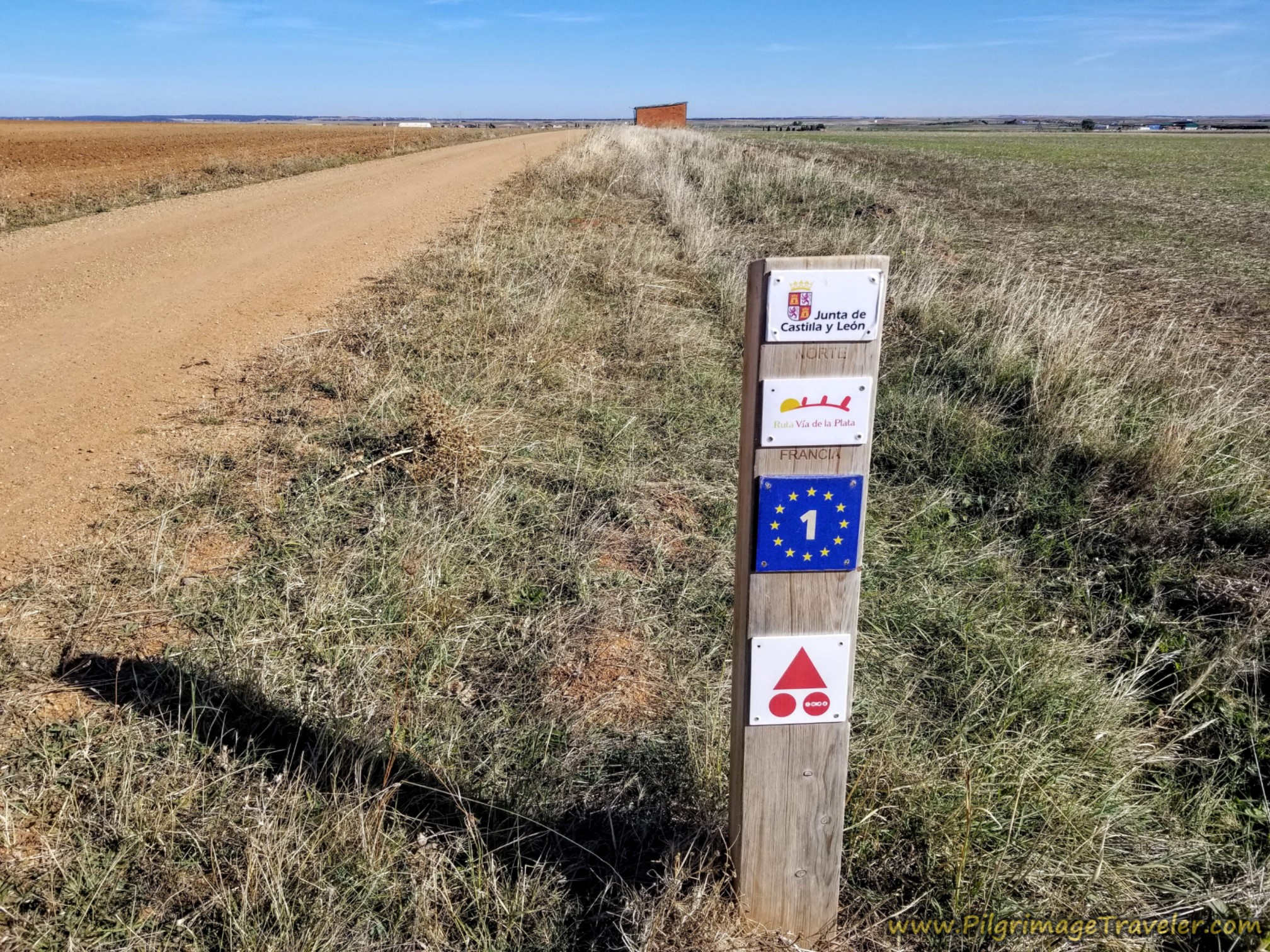 Signage for Multiple Trail Systems
Signage for Multiple Trail SystemsJump to Vía de la Plata Stages
A common sight along this high meseta, was the tractors. The farmer waved to us as we shared the road!
Once again, the next town's church tower, of Calzada de Valdunciel, is visible long before the town itself. But from the vantage point in this photo below, more buildings were in sight.
By a bit less than 16 kilometers, we arrived at the outskirts of town, after crossing over the DSA-510 paved road, shown below. (You can figure the center of town to be about 16 kilometers).
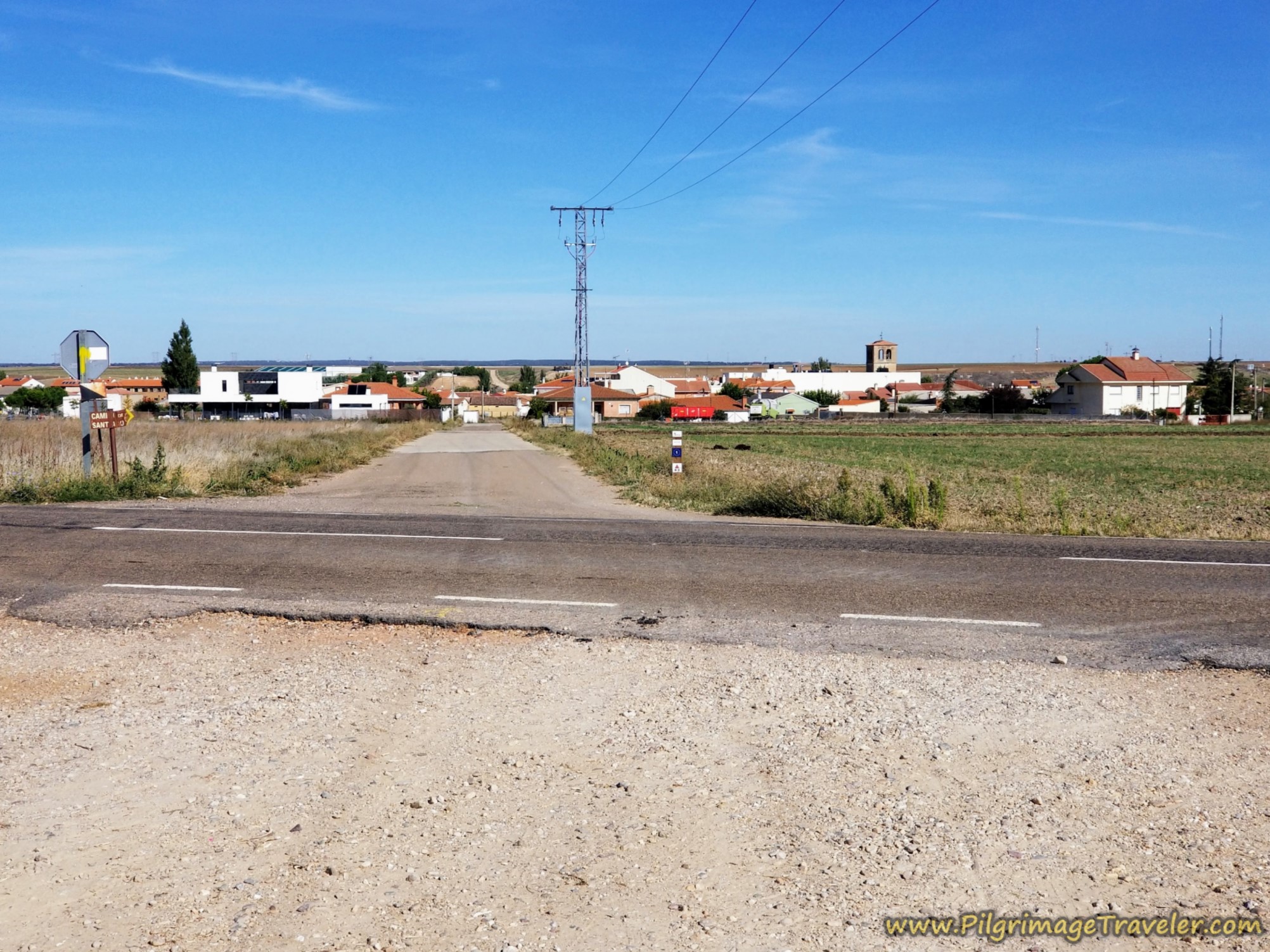 Entering Calzada de Valdunciel
Entering Calzada de ValduncielThere are several accommodations in Calzada de Valdunciel. As we walked through the main street, we passed the town hall. A few meters later we passed the Casa Rural, La Casa del Molinero, (+34 689 00 85 62), below. This place gets very good reviews on Google and it looked lovely as we peered into the courtyard.
The town is not very big, so very shortly we arrived at the north end and realized that we had not seen a bar. I checked the map, and there was a restaurant, the Hostal Restaurante El Pozo, about 1/2 kilometer off Camino, back toward the town hall. This place also provides reasonably priced accommodation.
No one wanted to go back. Instead, the Plaza de los Miliarios, with the historic Roman milestones, was a nice place for a picnic. These stones were later used as stepping stones and were pulled out of the Vega Arroyo, just to the north among the trees in the photo!
Immediately to the right of the Plaza de los Miliarios, down the street a few meters to the east, is the municipal Albergue de Peregrinos de Calzada de Valdunciel. Contact the hospitalero for the keys at +34 717 70 66 37. This would be a reasonable place to stop, at about 16.3 kilometers for the day.
Jump to Vía de la Plata Stages
We all chose to carry on 6.0 kilometers more to Urbanizatión El Chinarral. I called the private Albergue Casa Saso (+34 697 37 95 26) there to ensure that we would have accommodations. After securing our places, we walked on. (This albergue is closed temporarily and I have no information regarding a re-opening. Unless you call and they have reopened, do not plan on staying here!)
A few meters north of town, we noticed this lovely look-out of sort, below. Rich decided to hike up there, a few meters off-road. It turned out to be a wildlife preserve, with a viewing platform for birding. Just beyond this mirador, or look-out is a small lake that had very little water in it when we passed by.
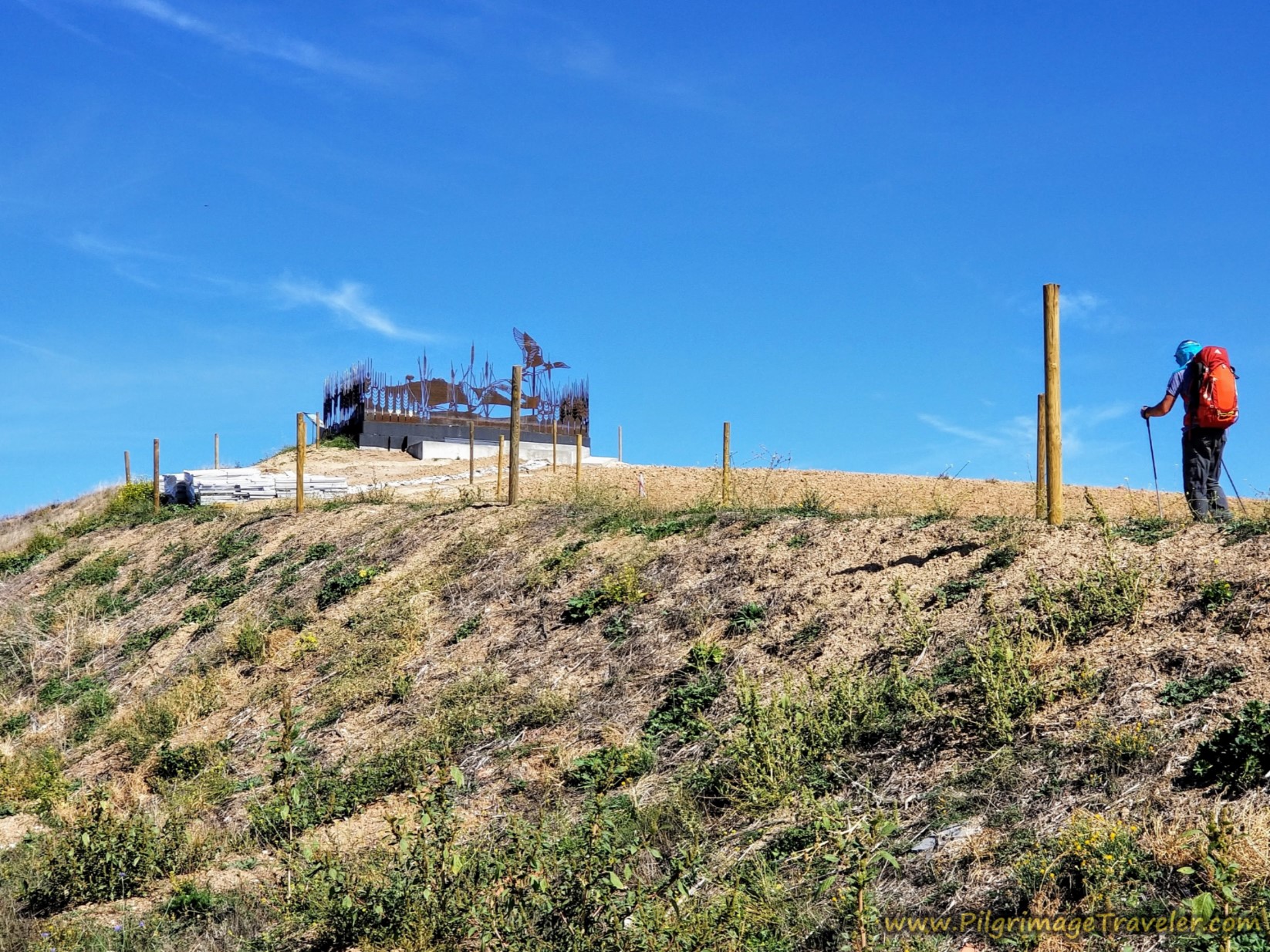 Mirador Ornitológico Vía de la Plata, Salamanca to Urbanizatión El Chinarral
Mirador Ornitológico Vía de la Plata, Salamanca to Urbanizatión El ChinarralIt was a long, boring, open and hot road onward after Calzada de Valdunciel. About 1.1 kilometers from town the Camino turns to the right at this Y-intersection, shown below, with Nadine, Norm and Rich plodding along.
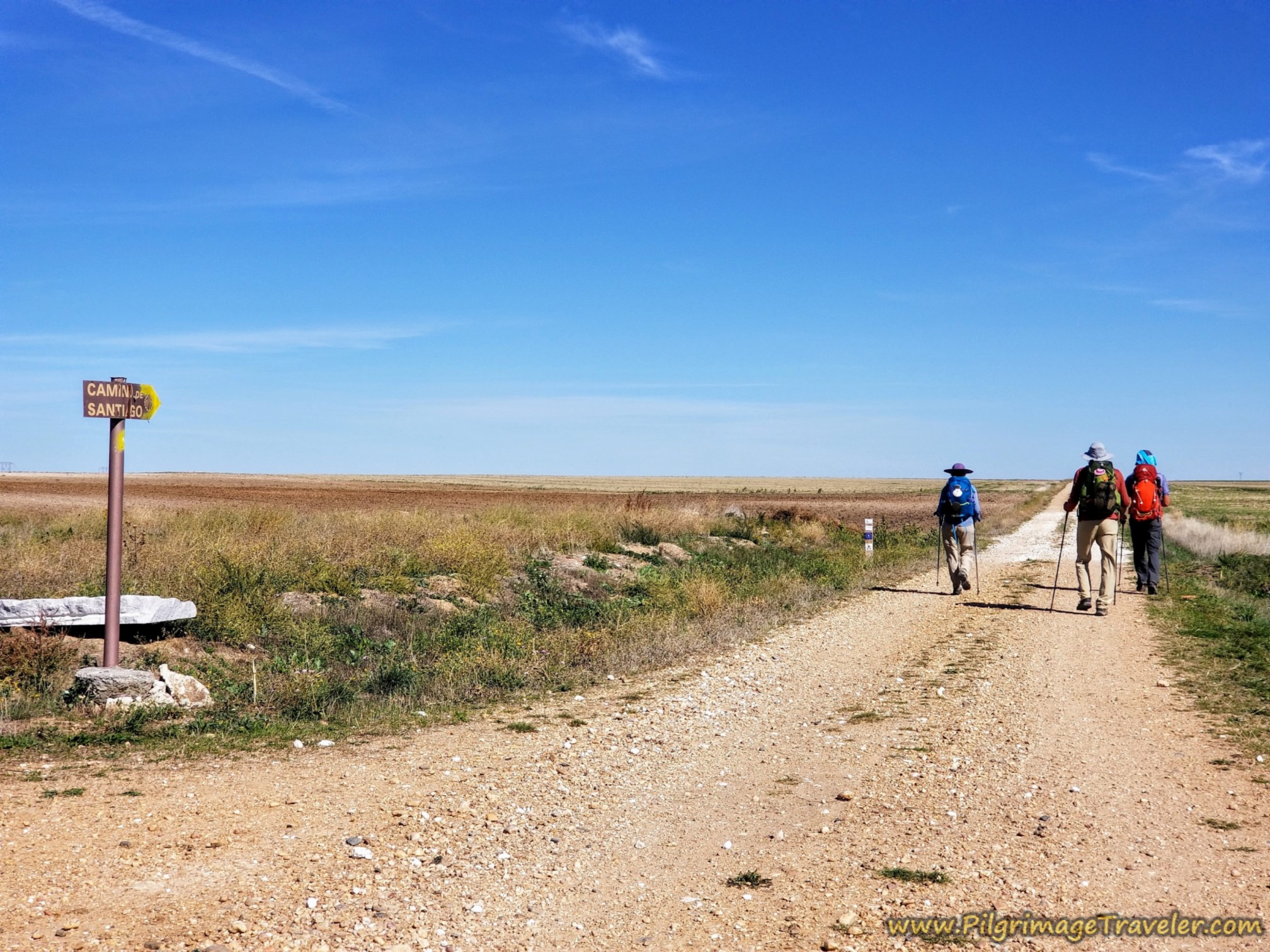 On the Road to the Albergue
On the Road to the AlbergueI put my head down and did double time. I got ahead of the group.
By 1.6 kilometers later, the farm road became a tractor lane. The tractor lane then dwindled down to a path as it came to a big bend with the fence line, after about 19.0 kilometers. I looked back at the group, shown left, plodding along.
Continuing along the fenceline after the path bends to the east and towards the highway, pictured below, it meets the A-66 highway about 100 meters later.
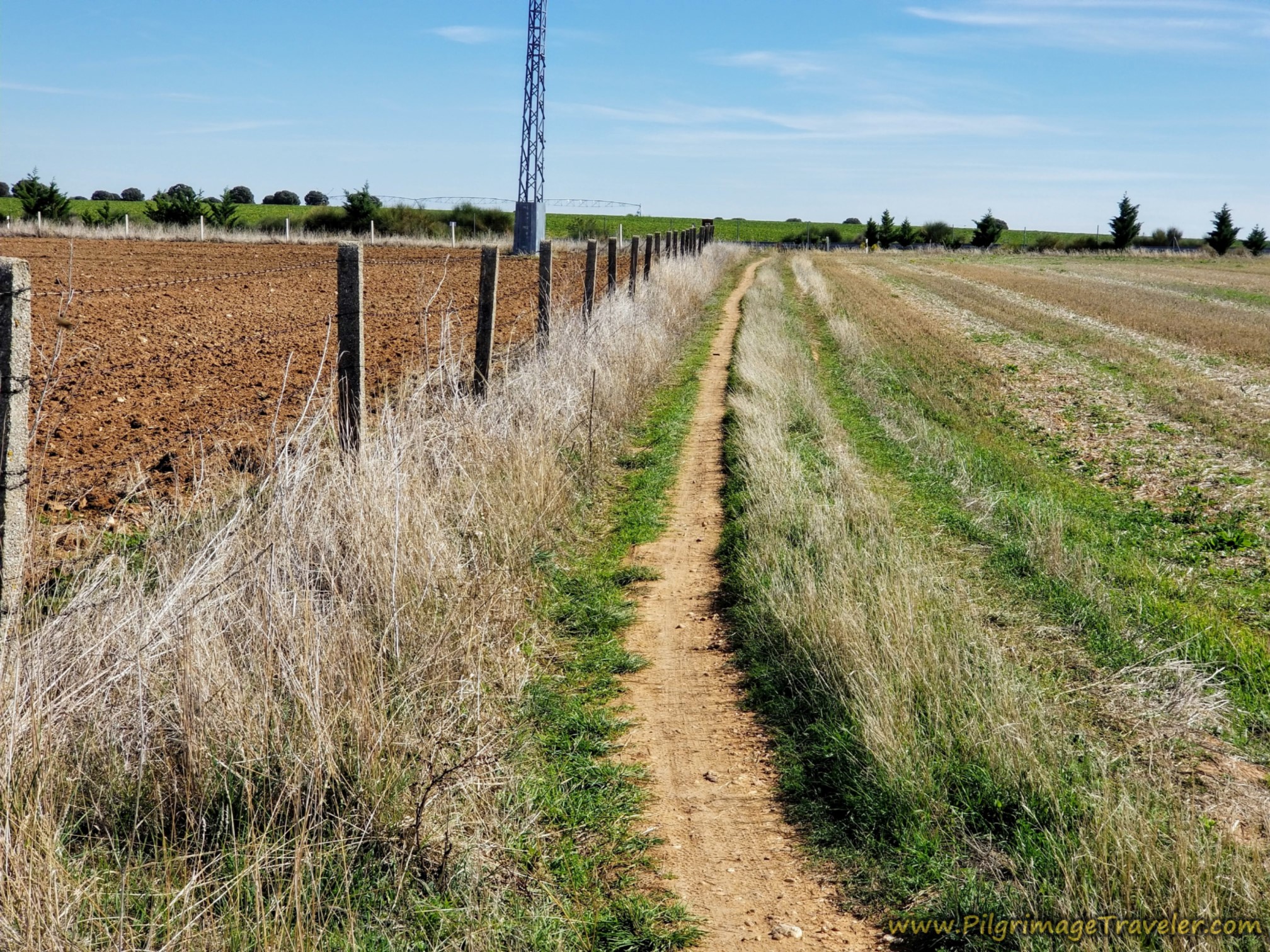 The Path Ahead Following the Fenceline
The Path Ahead Following the FencelineThe Vía de la Plata then picks up another tractor lane northward as it parallels the highway, shown below.
The Camino continues to follow the tractor lane paralleling the highway and through a large interchange for 2.3 kilometers, until it comes to this overpass. You are at about kilometer 21.4 into the day.
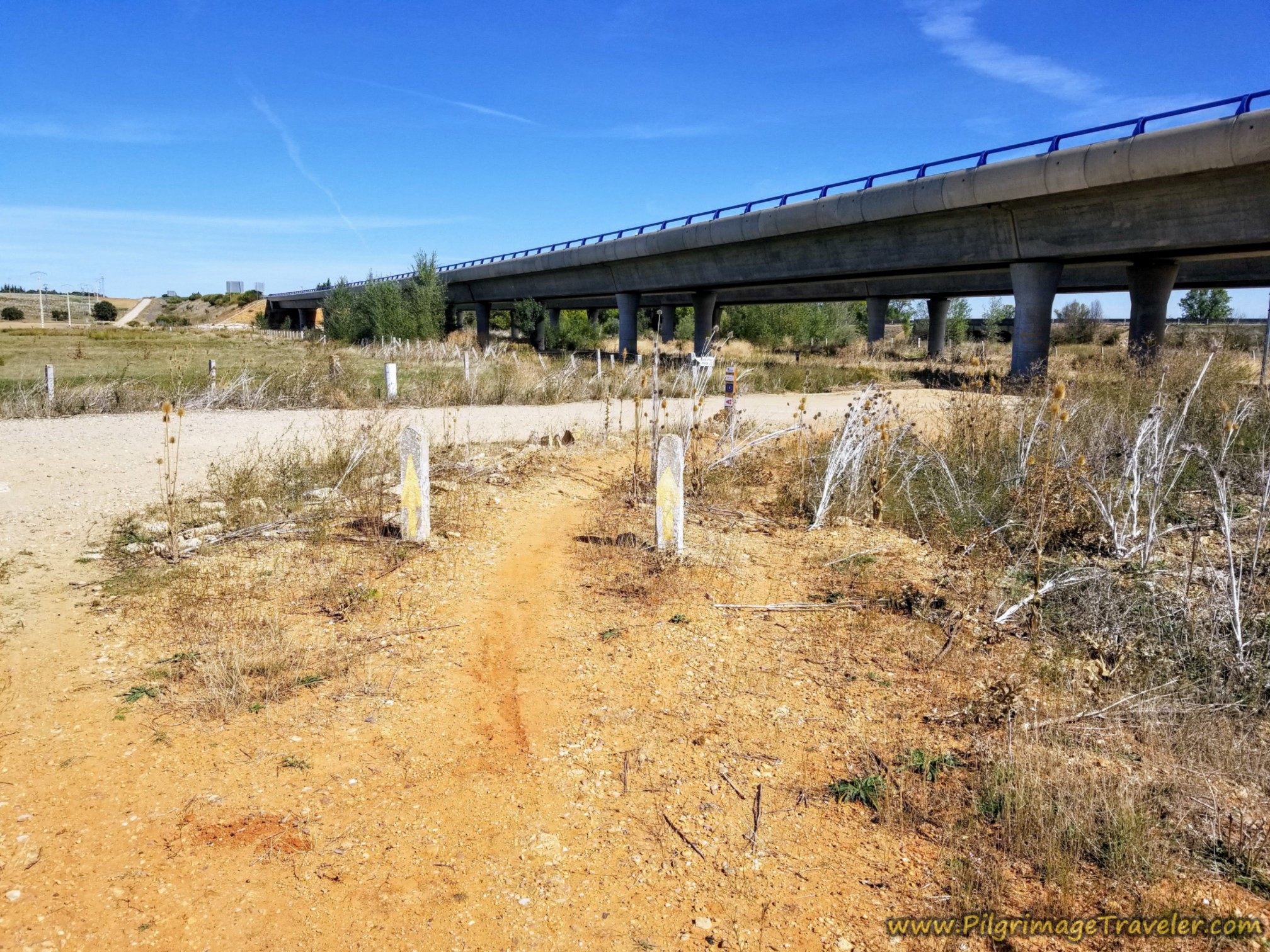 A-66 Overpass
A-66 OverpassThe path takes you underneath the A-66 and once there, you will see this most interesting direction on the bridge pylon. It says, "Sin Agua, Without Water," and an arrow to the left. "Con Agua, With Water," and an arrow to the right!
Essentially what this means, is that if there is high water under the bridge, and you will be able to figure that out, you must go to the right, double back to pick up the N-630, turn left (northward) until you reach the bridge crossing the River Cañedino, then pick up the dirt road on the other side to double back under the bridge on the other side. Please see the interactive map above for details of this detour shown in red.
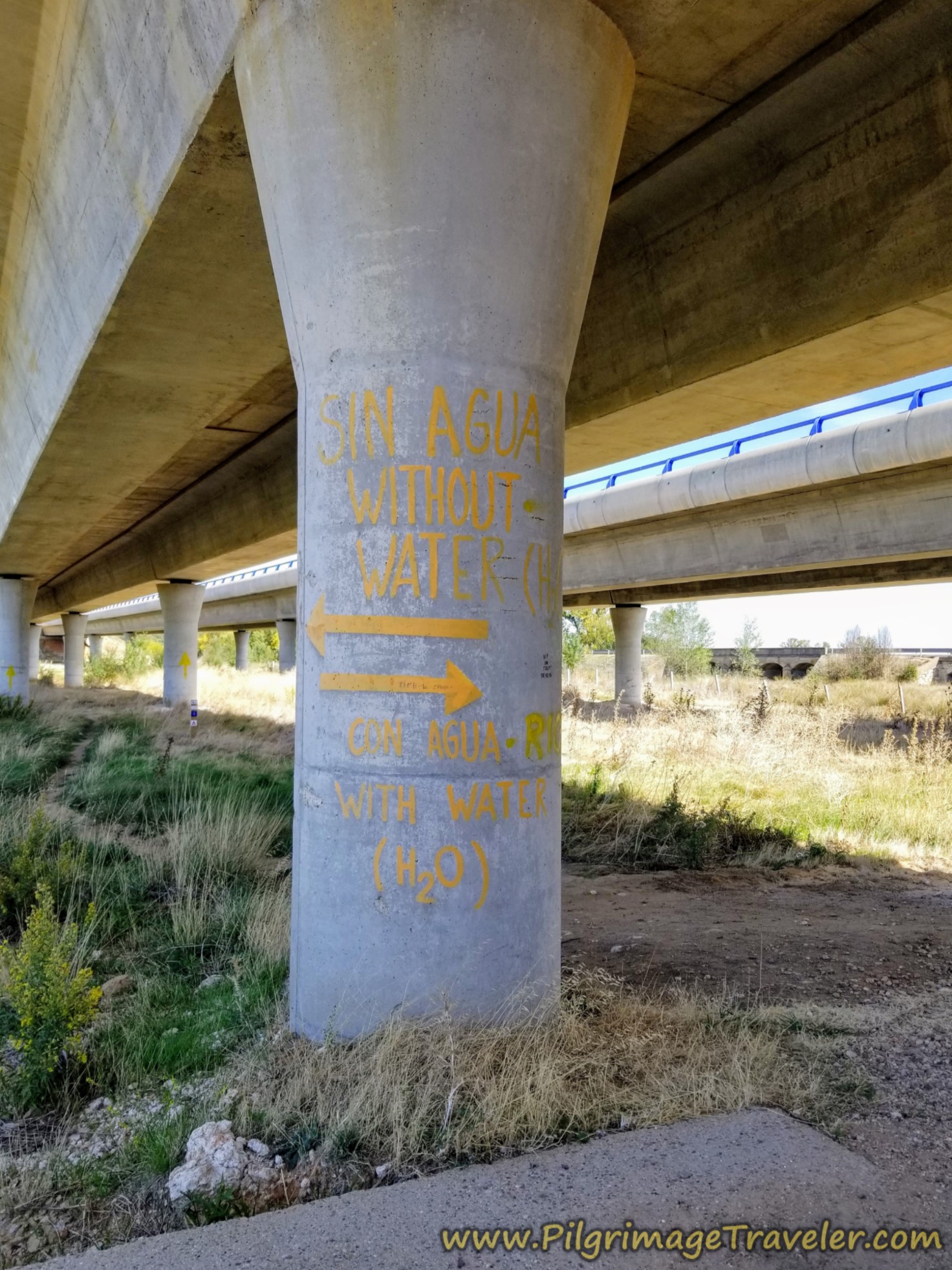 To Detour or Not?
To Detour or Not?We were lucky as there were only a few puddles under the bridge and we were able to pass straight through. The detour will add over 1/2 kilometer to your day, if you need to take it.
The good news is even though you might have to take the detour, this is the Rivera de Cañedino, the Cañedino River, just before Urbanizatión El Chinarral. The end is near! Below is the final one-kilometer home stretch after the river crossing.
And here is Norm, Rich and Nadine, posing for me at the turn-off, where I turned off my GPS at 22.7 kilometers into the day. The private Albergue Casa Saso is only a few meters off-Camino from here. Just remember that the albergue is currently closed.
And about 2.0 kilometers farther along the Camino and well-signed at the turn by the first overpass (see day two) and another 2.2 kilometers off-Camino is the Castillo del Buen Amor. This is a 1000 year old and fantastically renovated castle where you can stay the night, for around 120 Euros for a double. If I had known about it, I may have made the choice to stay here! Where else could you stay in a castle for this price??
I hesitate to keep this next information on the Casa Saso because it is now closed, but here it is anyway:
Alberto and Carmen at the Albergue Casa Saso were kind, accommodating and extremely helpful. The surrounding gardens are lovely, with a pool when in season. The whole place is set-up like pods. There is a pod with two double rooms and one shared bathroom, a pod for the albergue, a pod for the dining area and a pod for the showers/bathrooms. Pilgrims have full range of the extensive grounds.
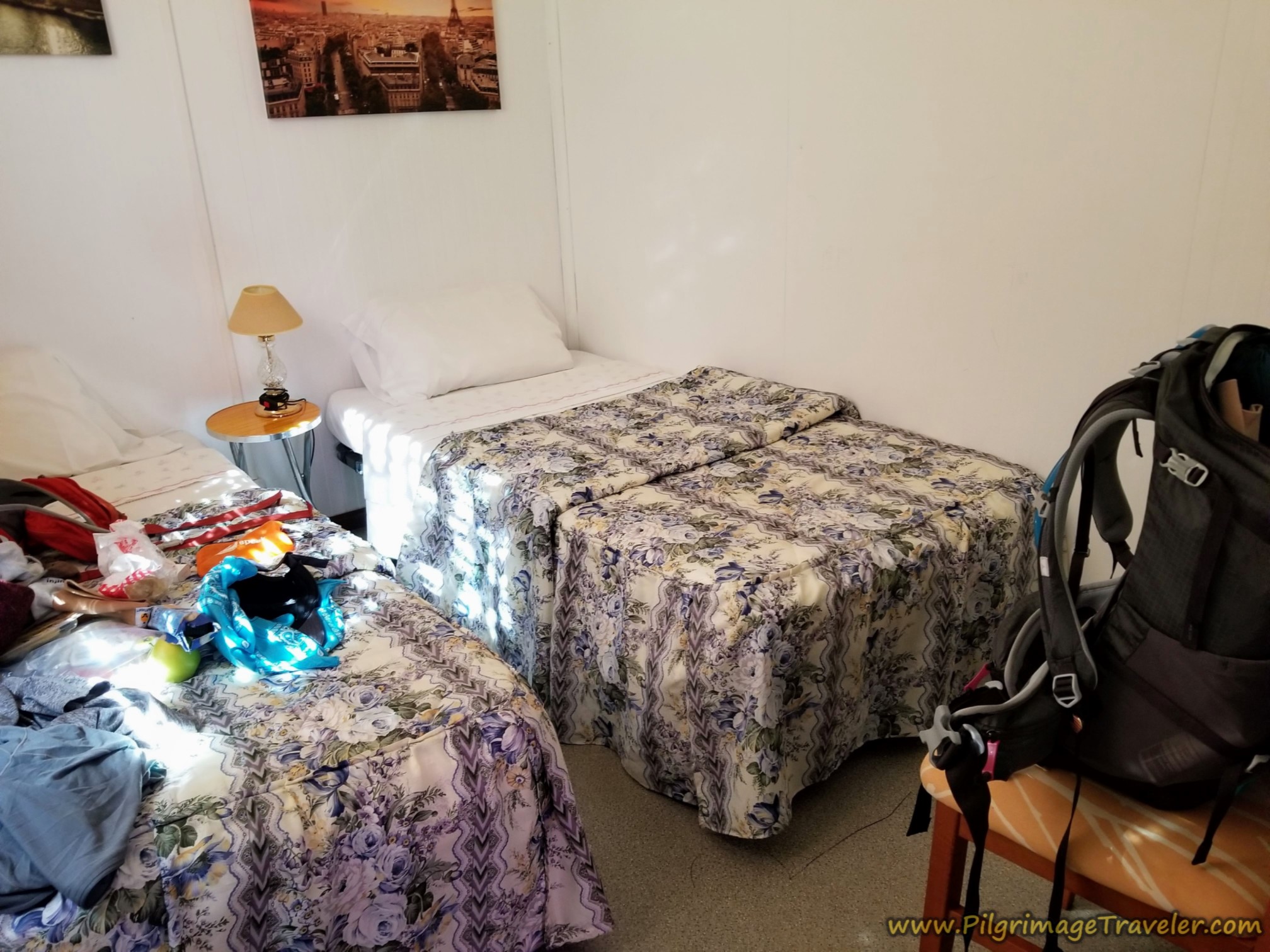 Our Individual Room at the Albergue Casa Saso
Our Individual Room at the Albergue Casa Saso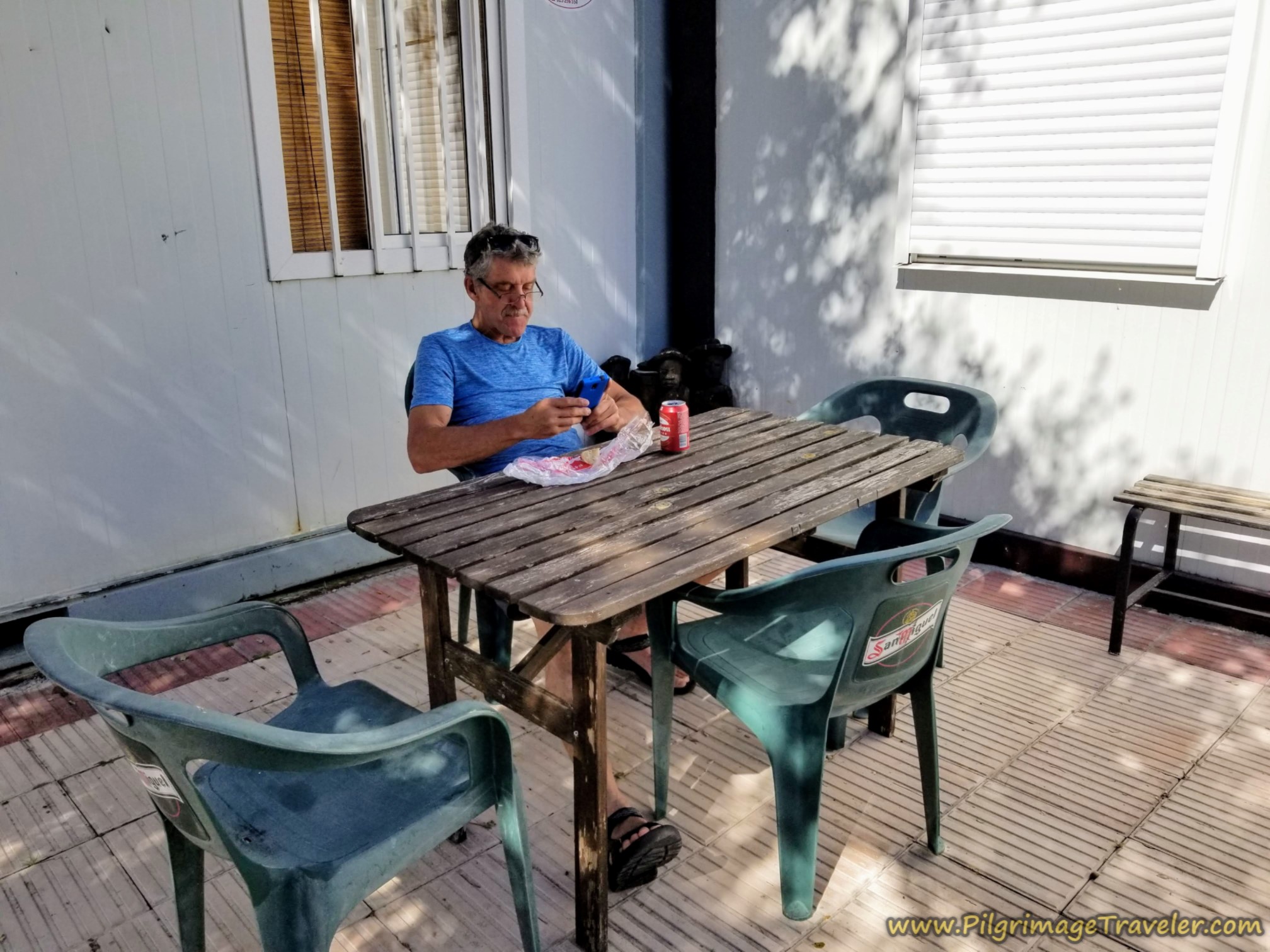 Albergue Casa Saso Patio Area
Albergue Casa Saso Patio Area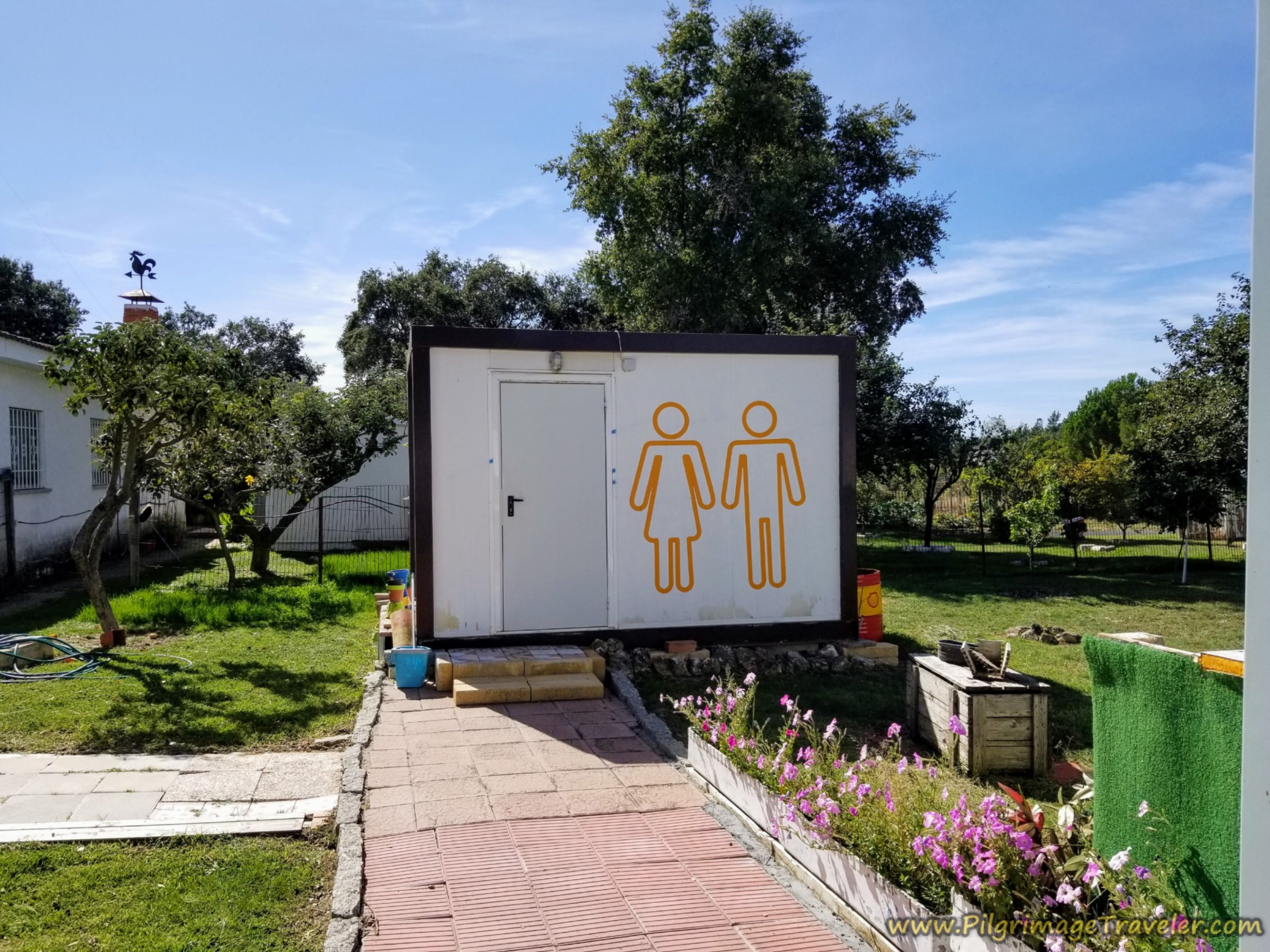 Albergue Casa Saso Shower Pod
Albergue Casa Saso Shower PodWe finished our day with celebrations of beers, delicious showers and a lovely full-course and inexpensive dinner, provided by our hosts. I am so sad this place is closed!
Reflections of Day One on the Vía de la Plata, Salamanca to Urbanizatión El Chinarral
All-in-all this day went without a glitch. Our winged spirits carried us onward with wings on our feet. Indeed, when the spirit is high, the body follows. We had no reason to complain. We were ready to go the distance.
Salutation
May your own Vía de la Plata from Salamanca to Urbanizatión El Chinarral find your spirits fueled and your body fueled, so that your heart has wings! Ultreia!
Camino Fonseca Stages
~ Vía de la Plata Stages from Salamanca
~ Camino Sanabrés Stages
Please Consider Showing Your Support
Many readers contact me, Elle, to thank me for all the time and care that I have spent creating this informative website. If you have been truly blessed by my efforts, have not purchased an eBook, yet wish to contribute, I am exeedingly grateful. Thank you!
Search This Website:
🙋♀️ Why Trust Us at the Pilgrimage Traveler?

We’re not a travel agency ~ we’re fellow pilgrims! (See About Us)
We've trekked Pilgrimage Routes Across Europe since 2014!
💬 We’ve:
- Gotten lost so you don’t have to. 😉
- Followed waymarks in the glowing sunlight, the pouring rain and by moonlight. ☀️🌧️🌙
- Slept in albergues, hostels & casa rurals. Ate and drank in cafés along the way. 🛌 😴
- Created comprehensive and downloadable GPS maps and eBook Guides, full of must-have information based on real pilgrimage travels. 🧭 🗺️
- Shared our complete journeys, step by step to help YOU plan your ultimate pilgrimage and walk with your own Heart and Soul. 💙✨
Every detail is from our own experiences. Just fellow pilgrims sharing the Way. We have added a touch of spirituality, heartfelt insights and practical guidance from the road ~ offering a genuine connection to the spirit of pilgrimage. Tap into the wisdom of seasoned pilgrims!
Ultreia and Safe Pilgrimage Travels, Caminante! 💫 💚 🤍
Follow Me on Pinterest:
Find the Pilgrimage Traveler on Facebook:
Like / Share this page on Facebook:
***All Banners, Amazon, Roamless and Booking.com links on this website are affiliate links. As an Amazon associate and a Booking.com associate, the Pilgrimage Traveler website will earn from qualifying purchases when you click on these links, at no cost to you. We sincerely thank you as this is a pilgrim-supported website***
PS: Our eBook Guide books are of our own creation and we appreciate your purchase of those too!!
Shroud Yourself in Mystery, along the Via de Francesco!
Walk in the Footsteps of St. Francis, and Connect Deeply with the Saint and to Nature in the Marvelous Italian Countryside!
Need suggestions on what to pack for your next pilgrimage? Click Here or on the photo below!
Find the Best Hotel Deals Using This Tool!
Carbon Trekking Poles ~ My Favorites!
Carbon fiber construction (not aluminum) in a trekking pole makes them ultra lightweight. We like the Z-Pole style from Black Diamond so we can hide our poles in our pack from potential thieves before getting to our albergue! There are many to choose from! (See more of our gear recommendations! )
Gregory BackPack ~ My Favorite Brand
Do not forget your quick-dry microfiber towel!

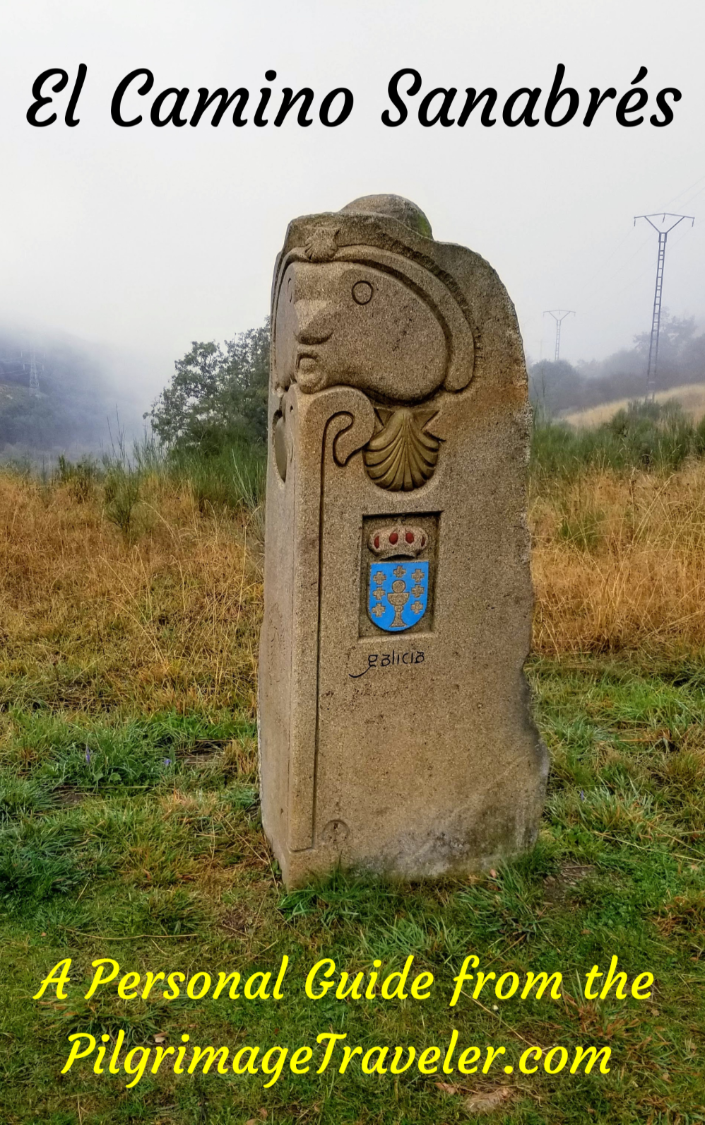
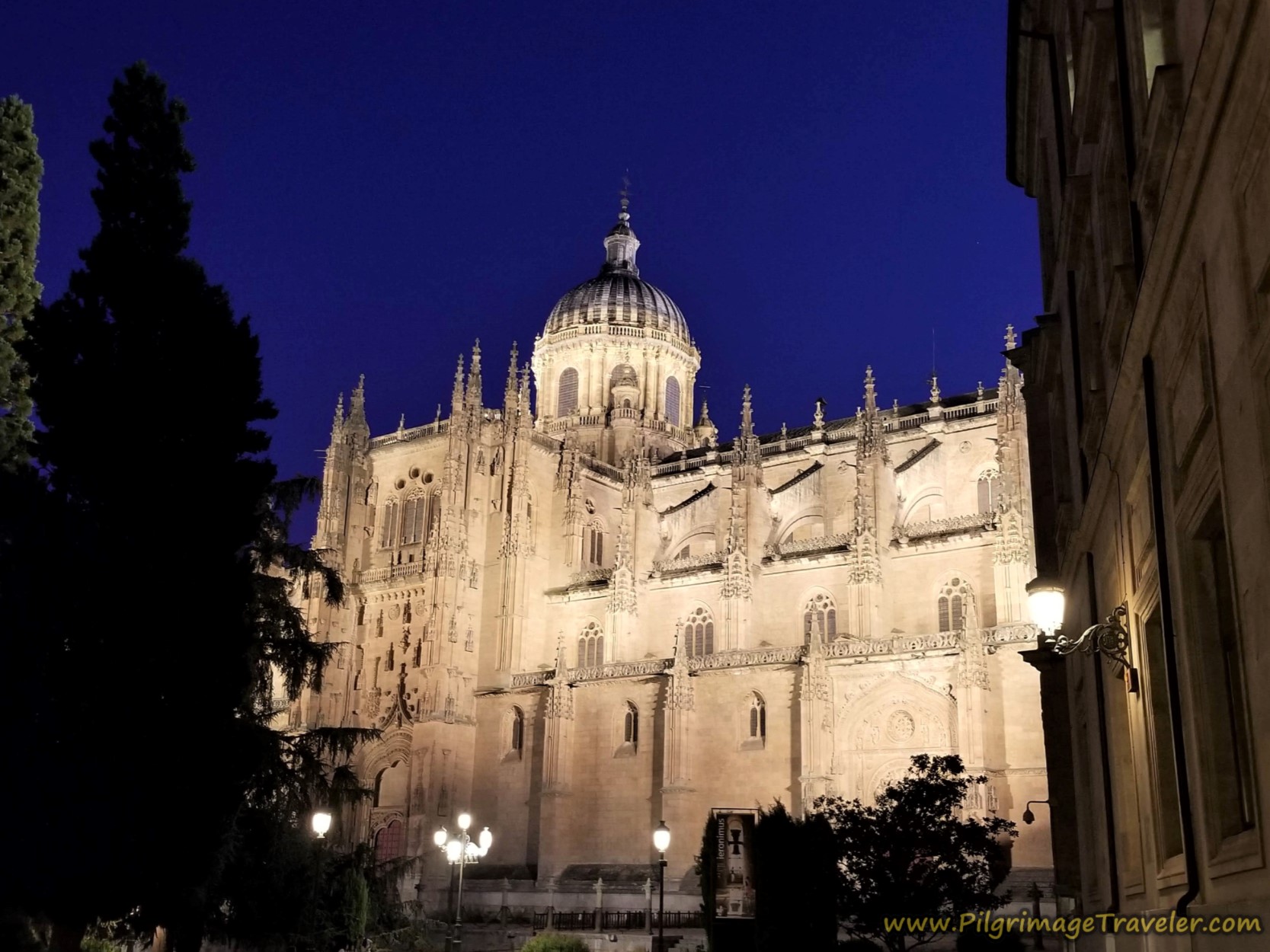
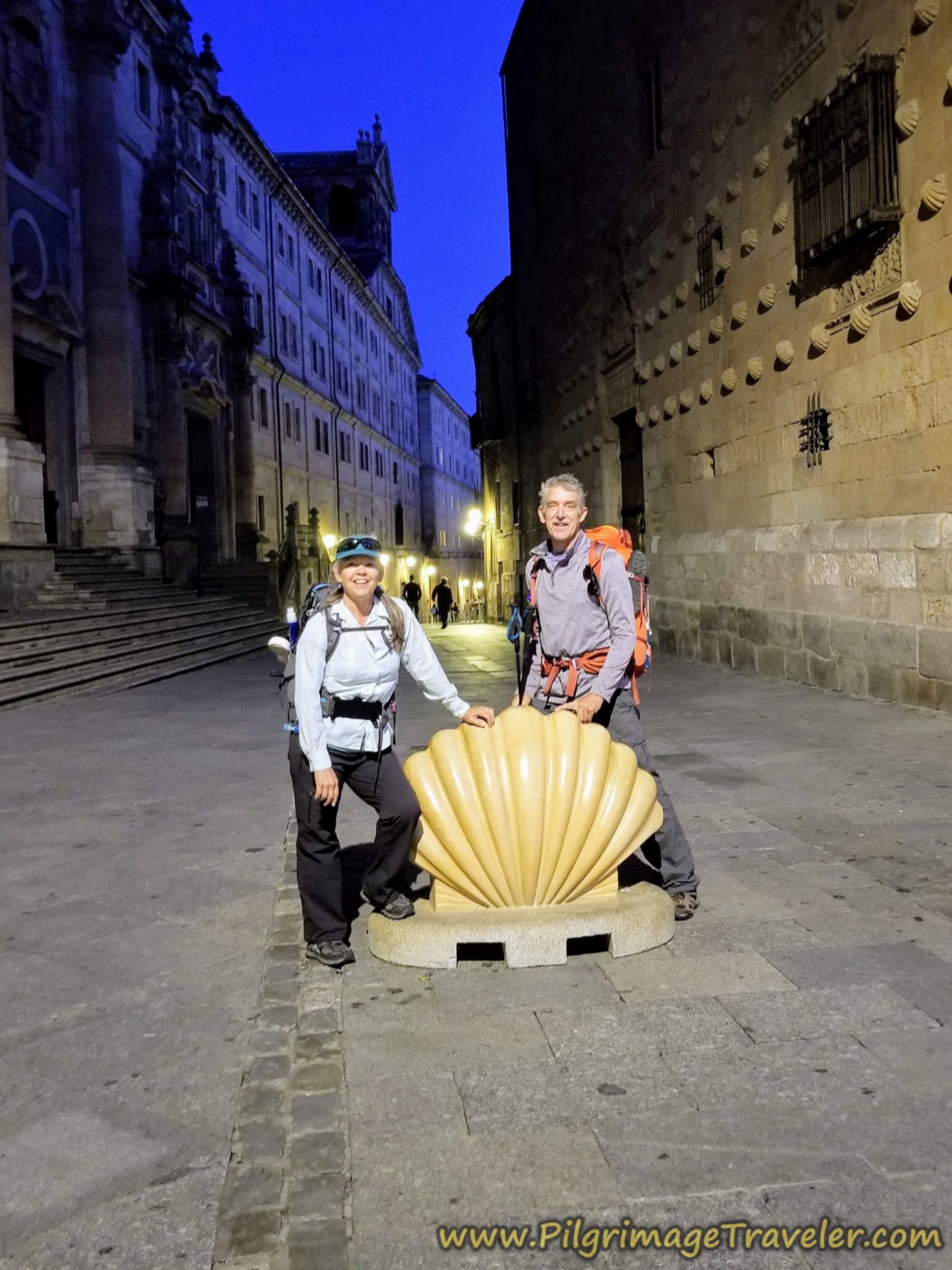
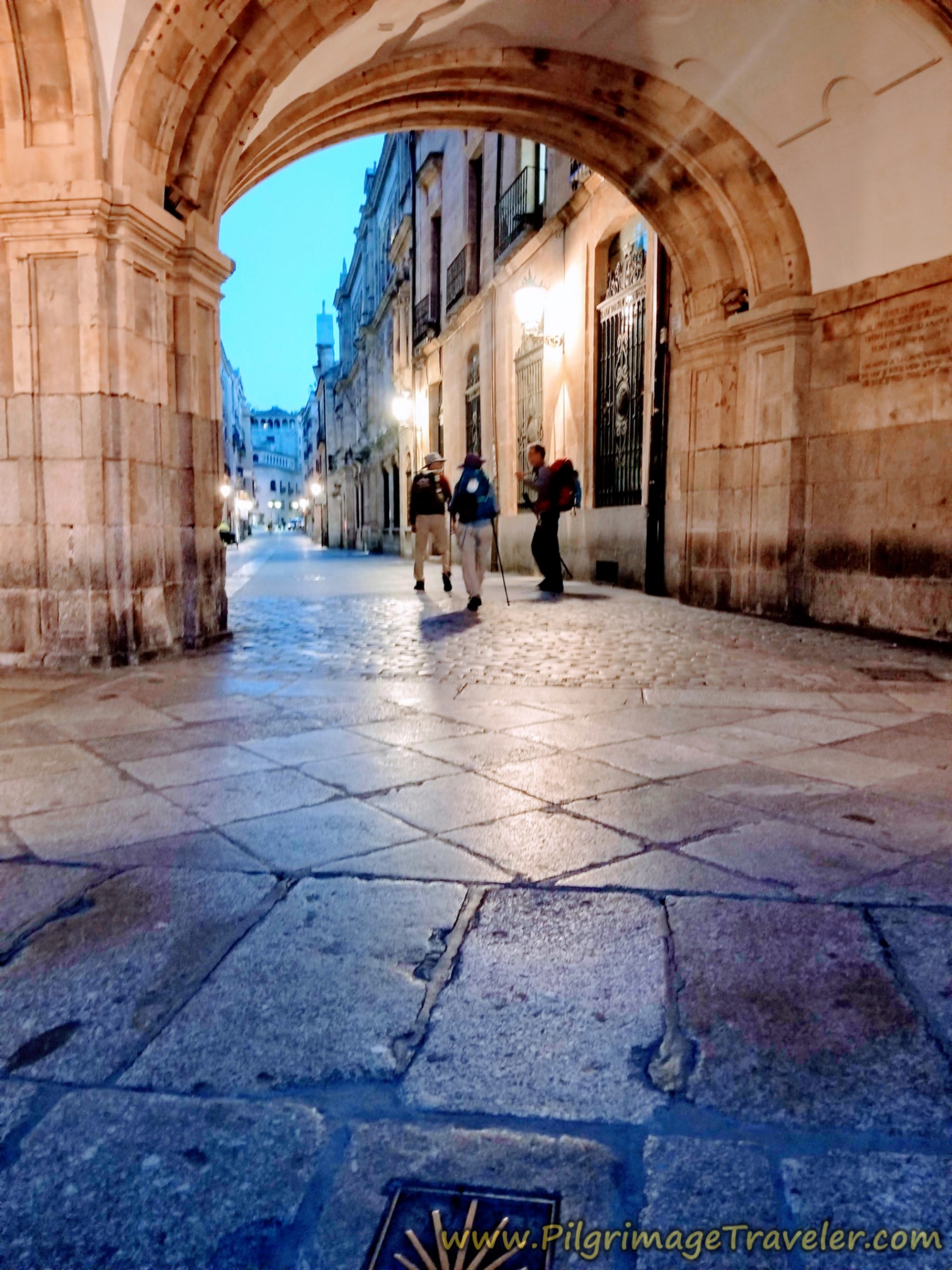
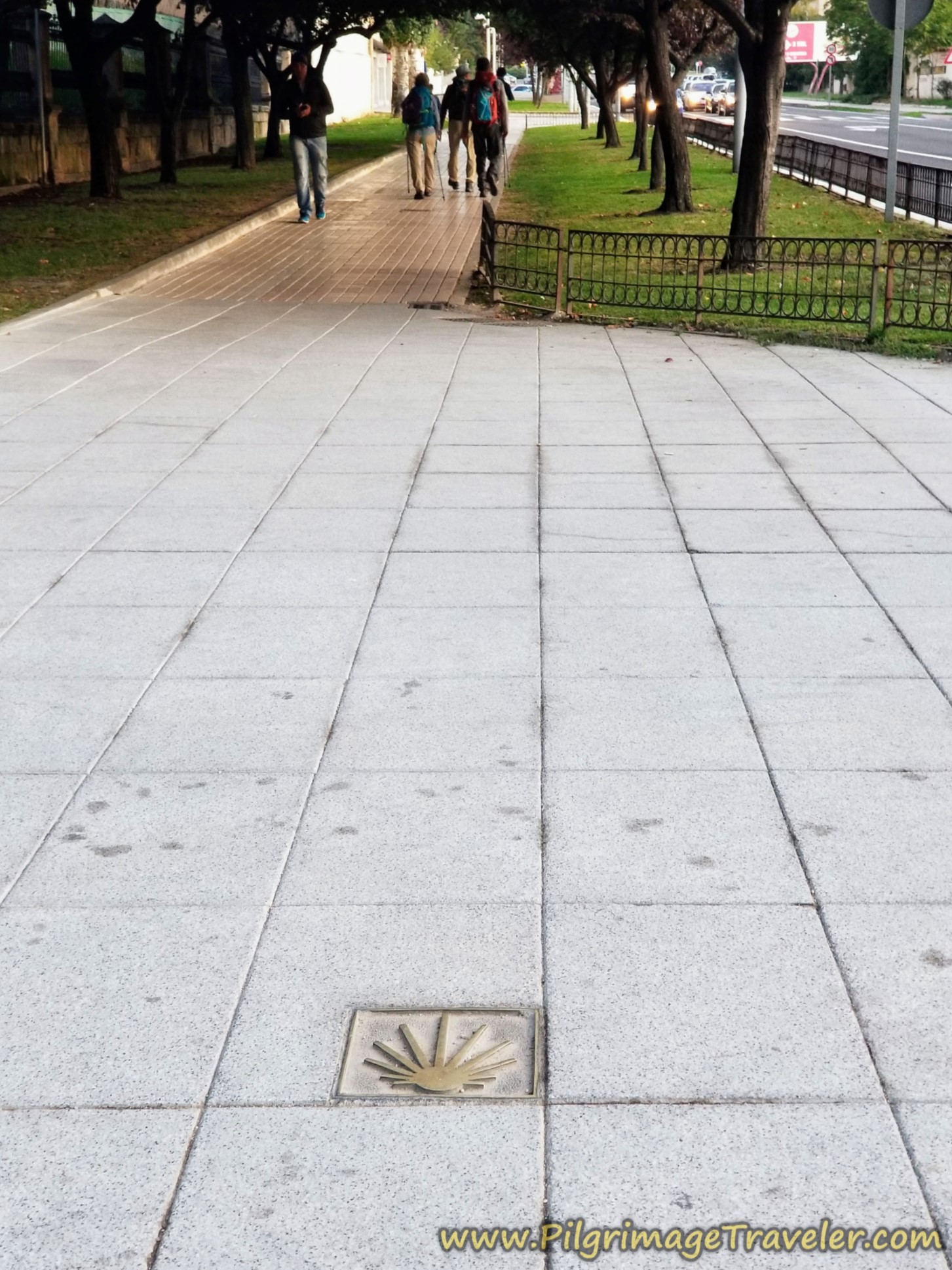
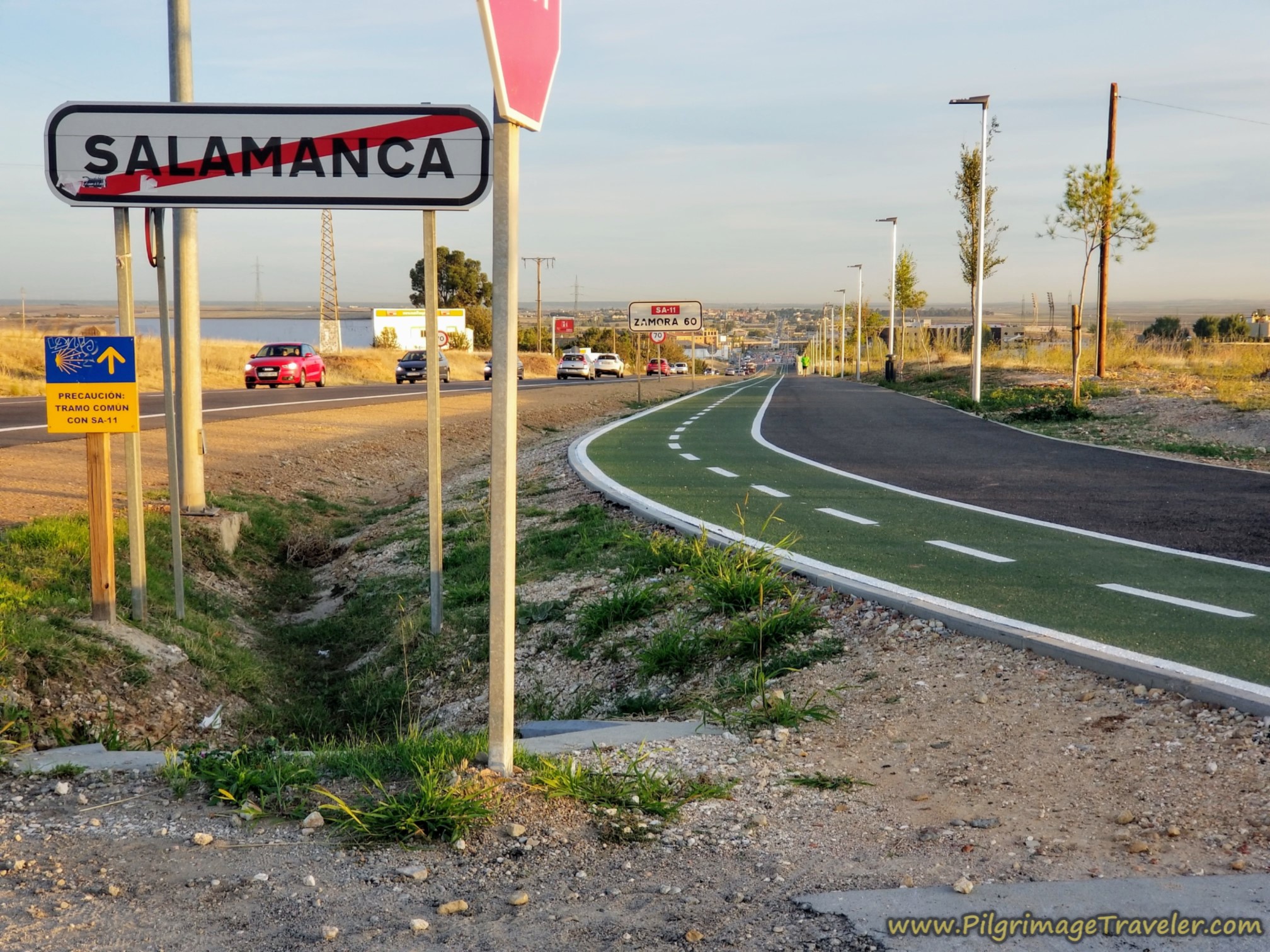
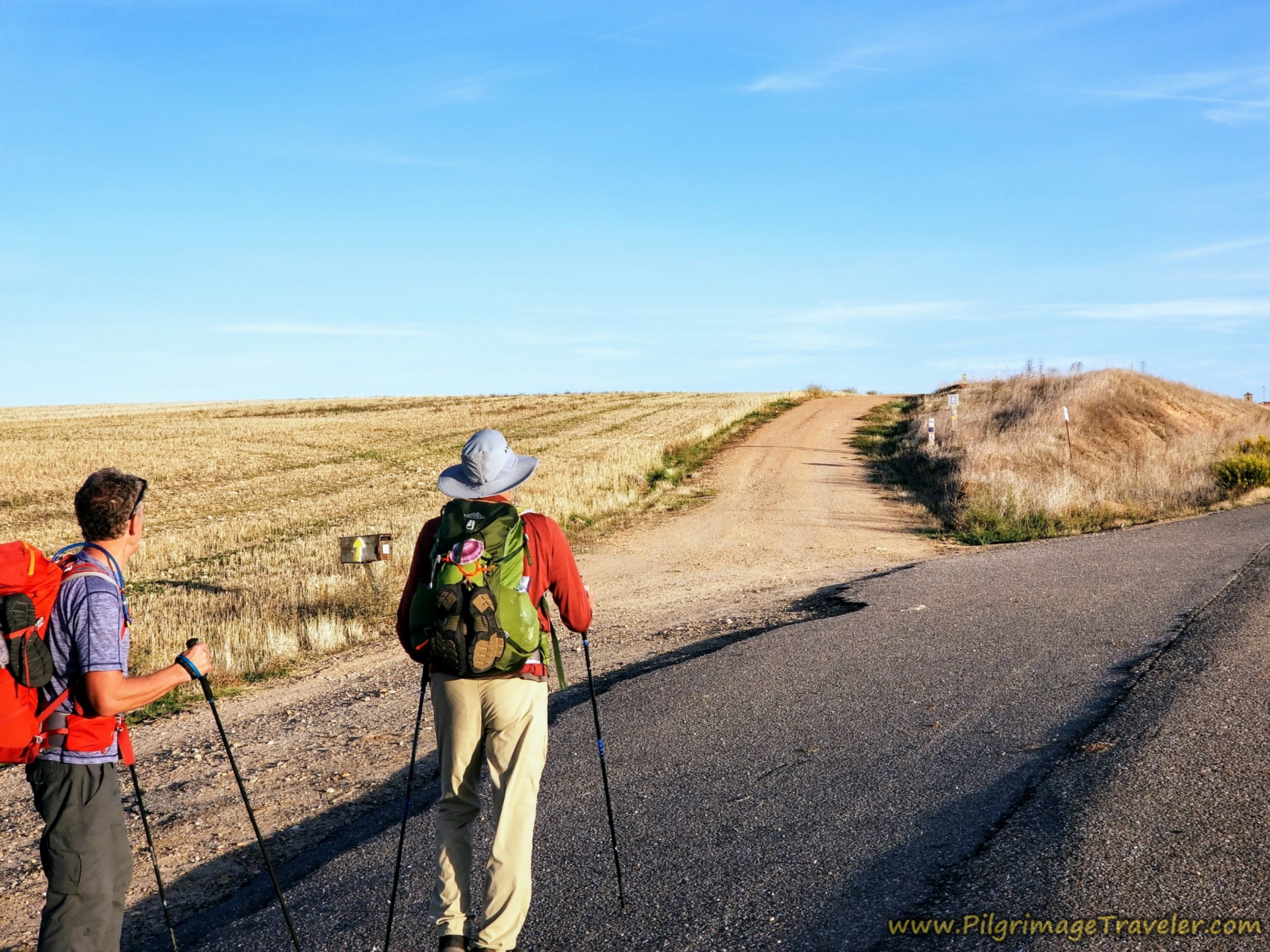
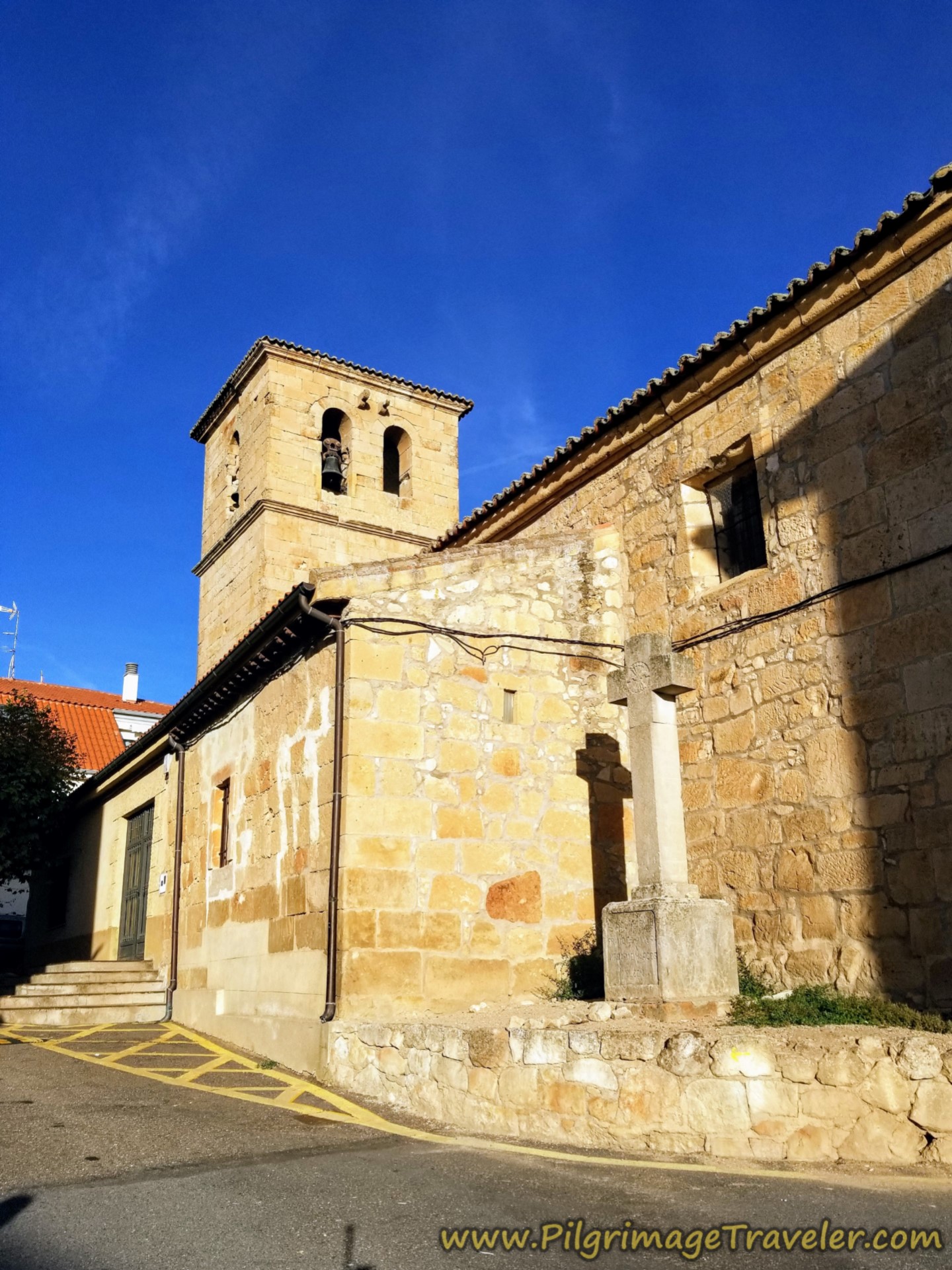
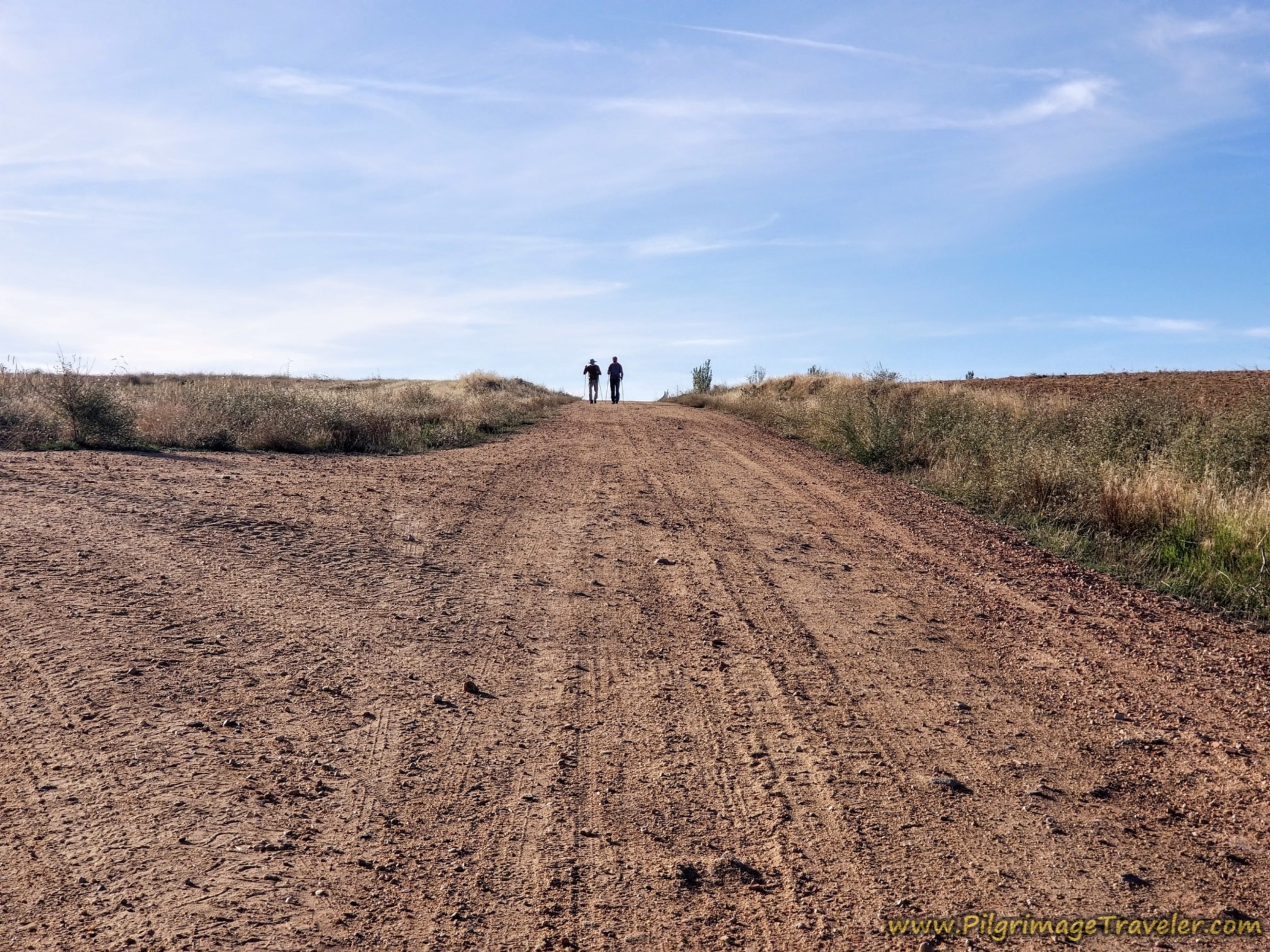
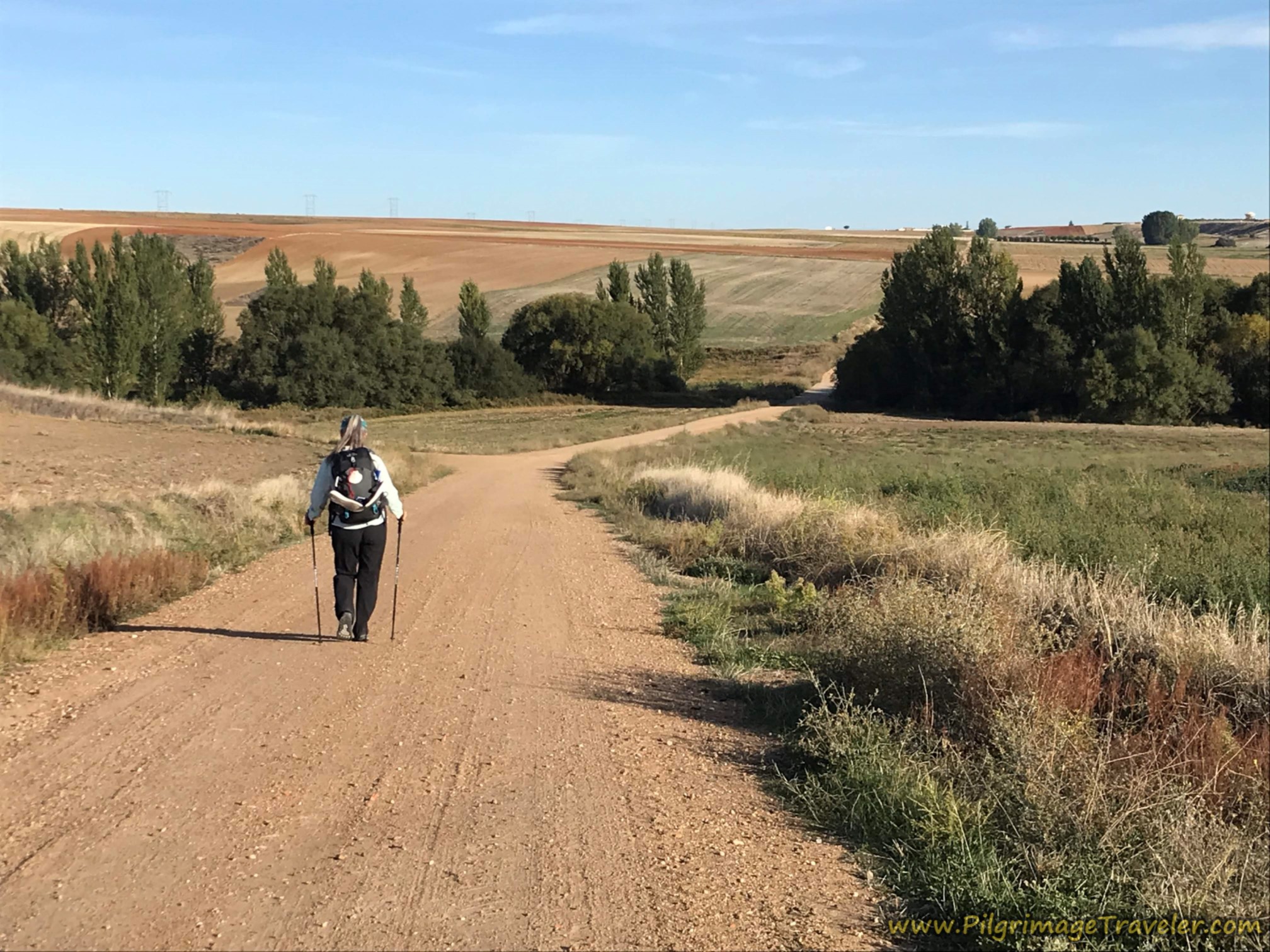
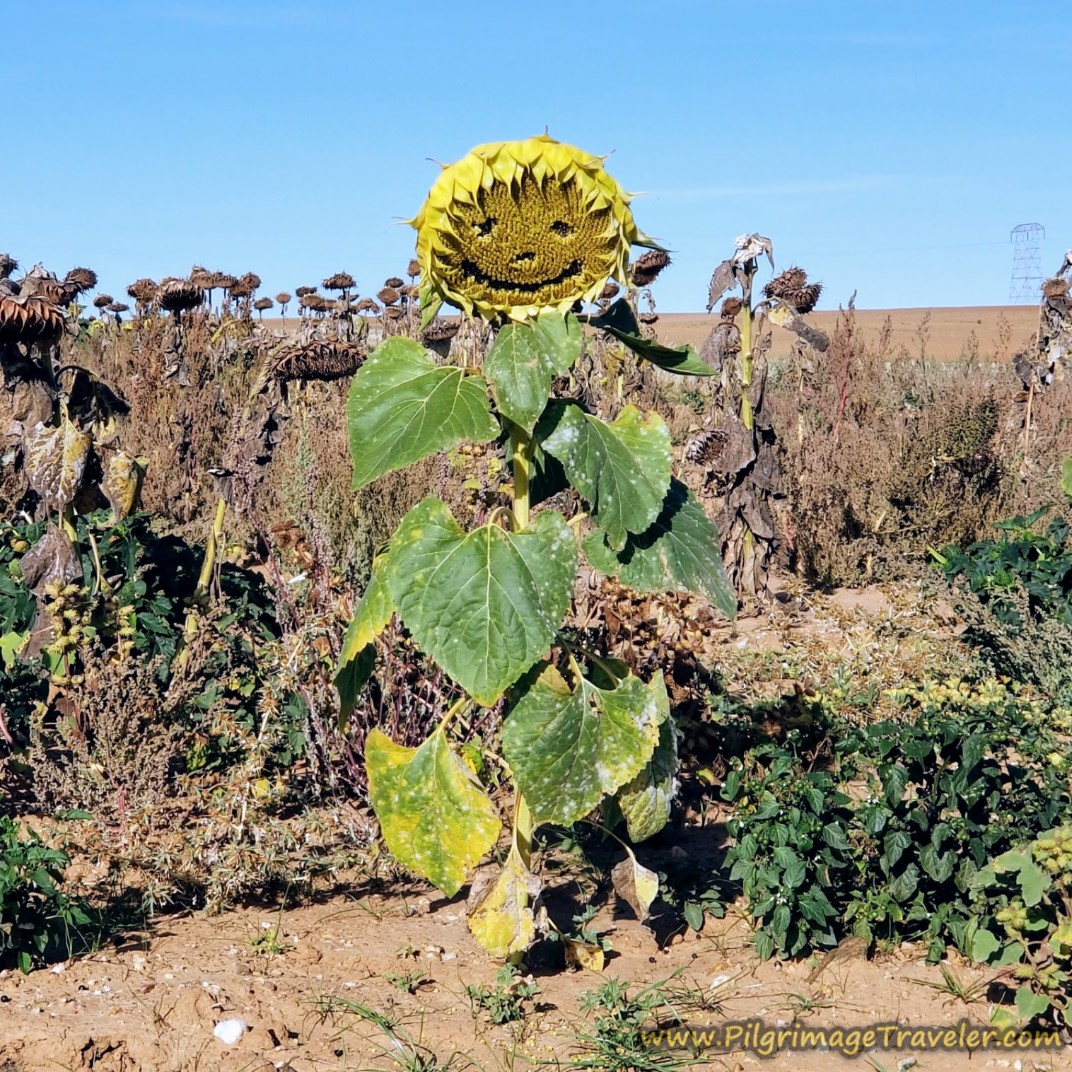
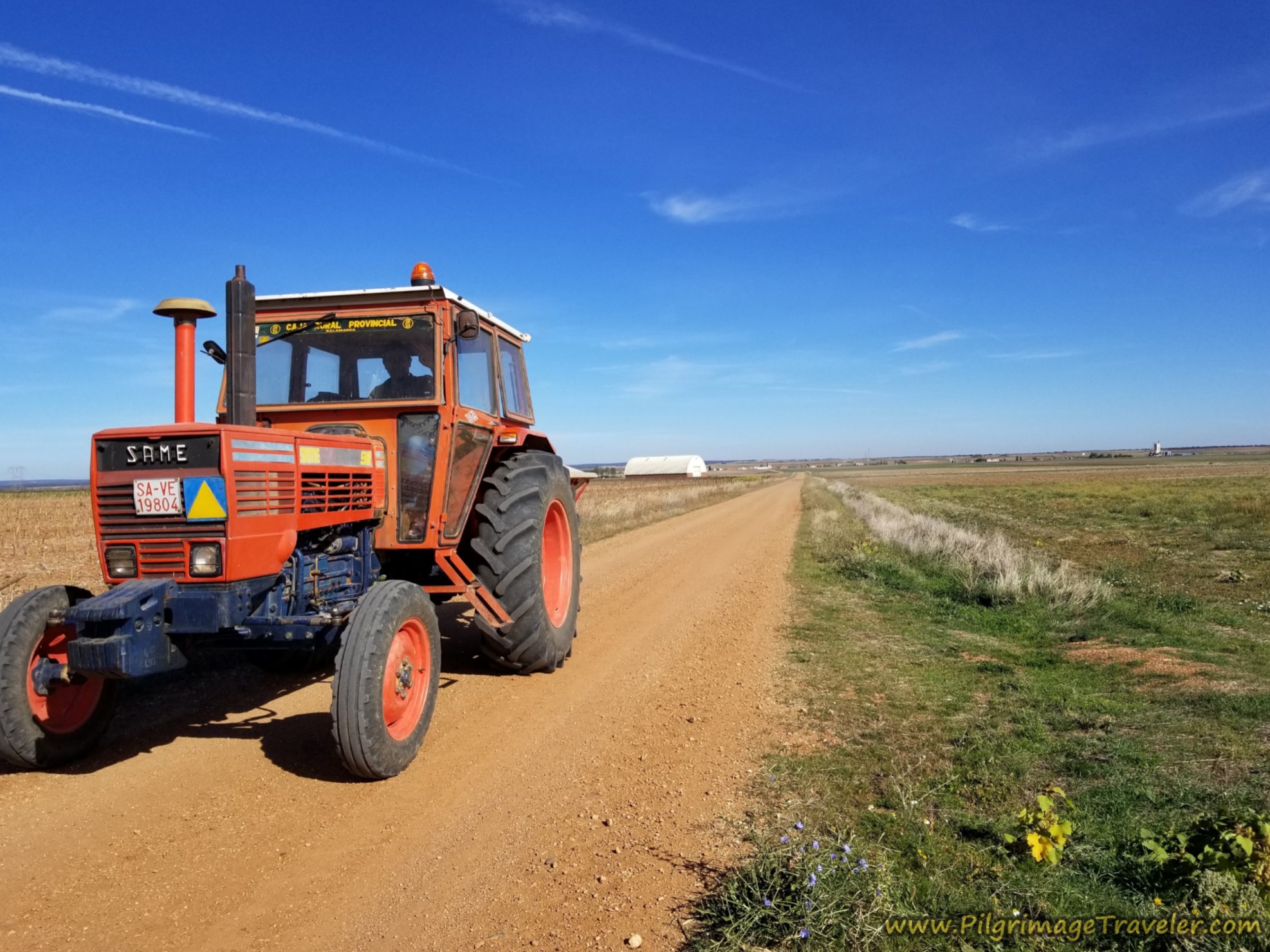
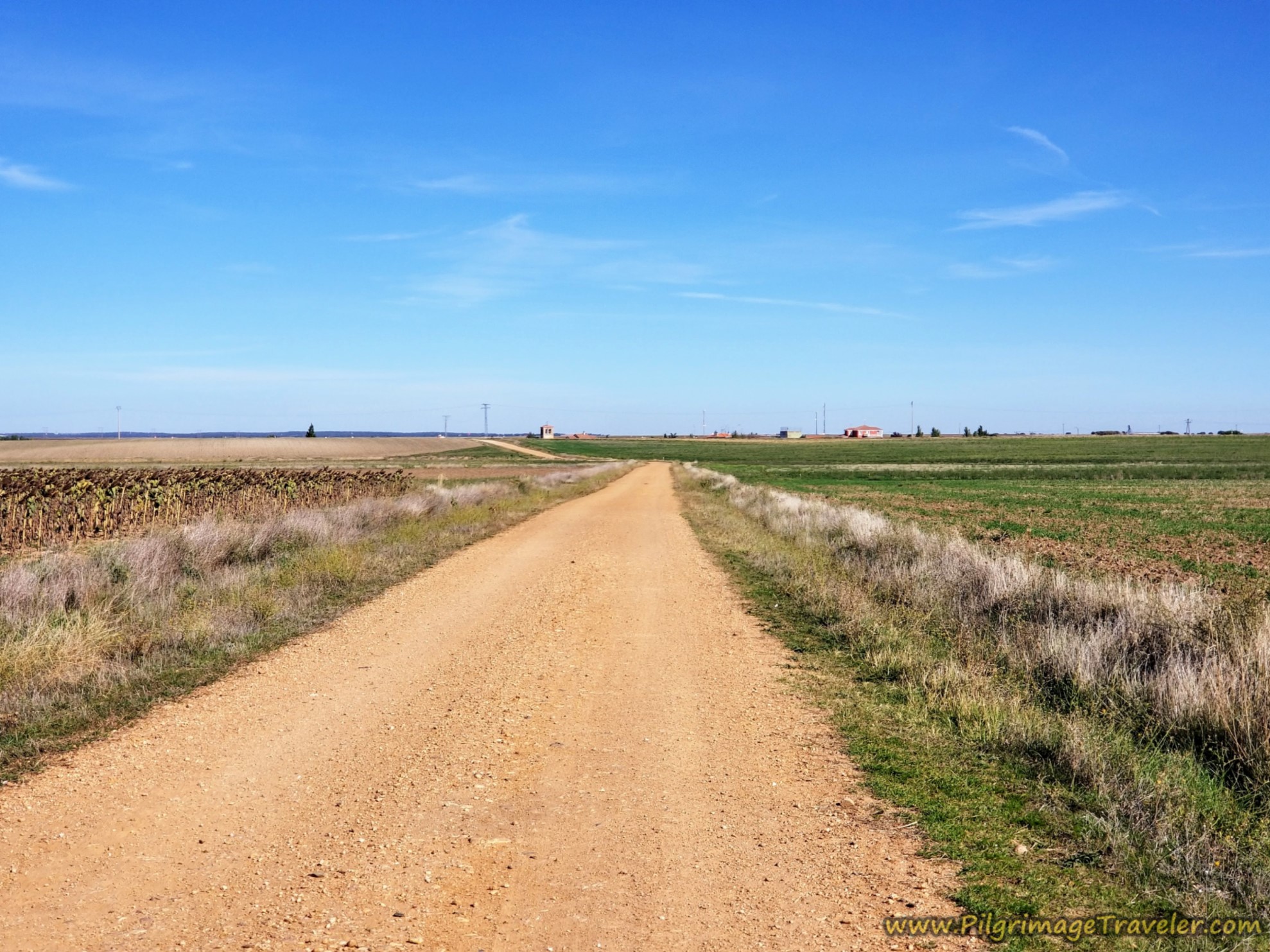
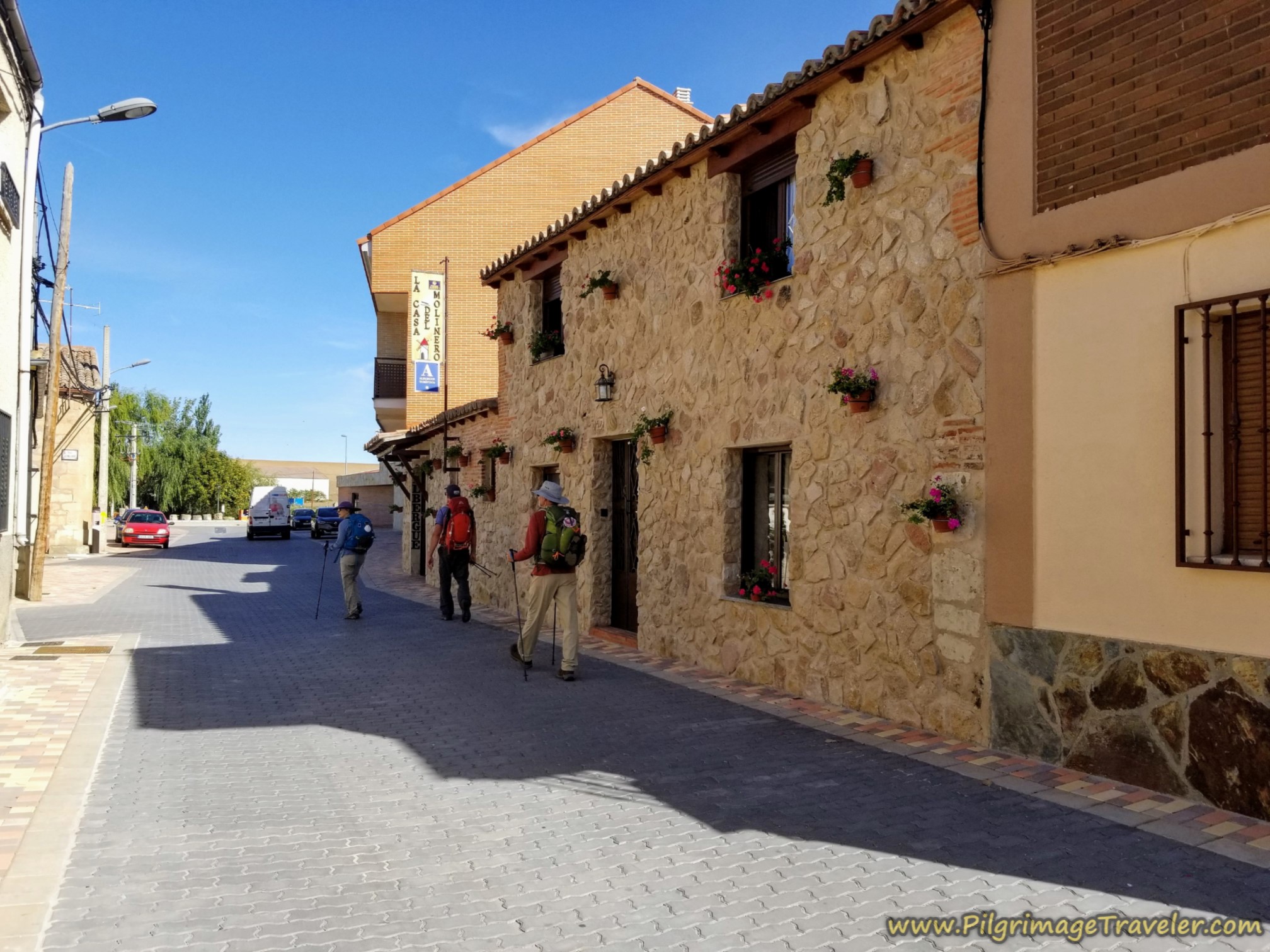
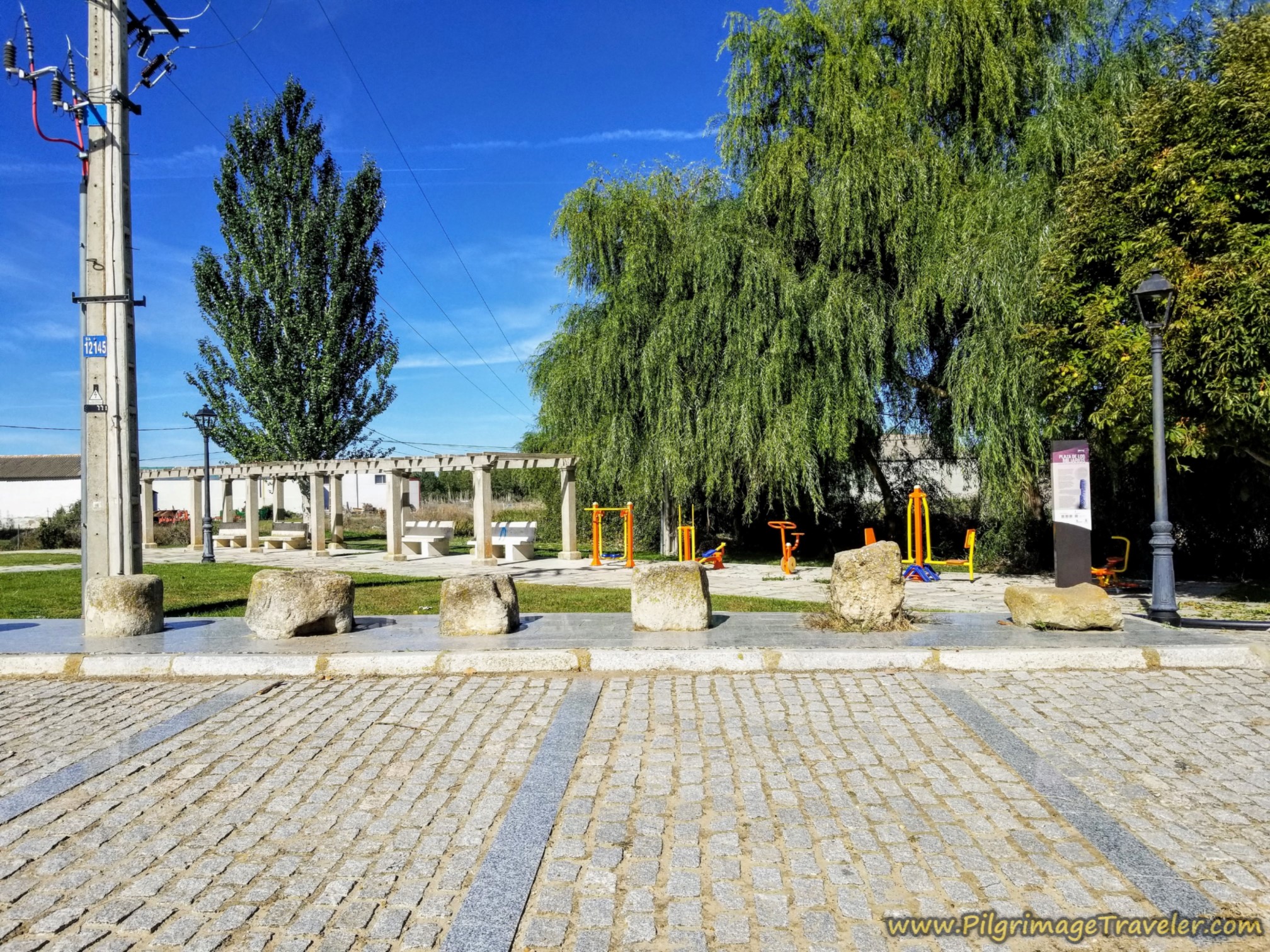
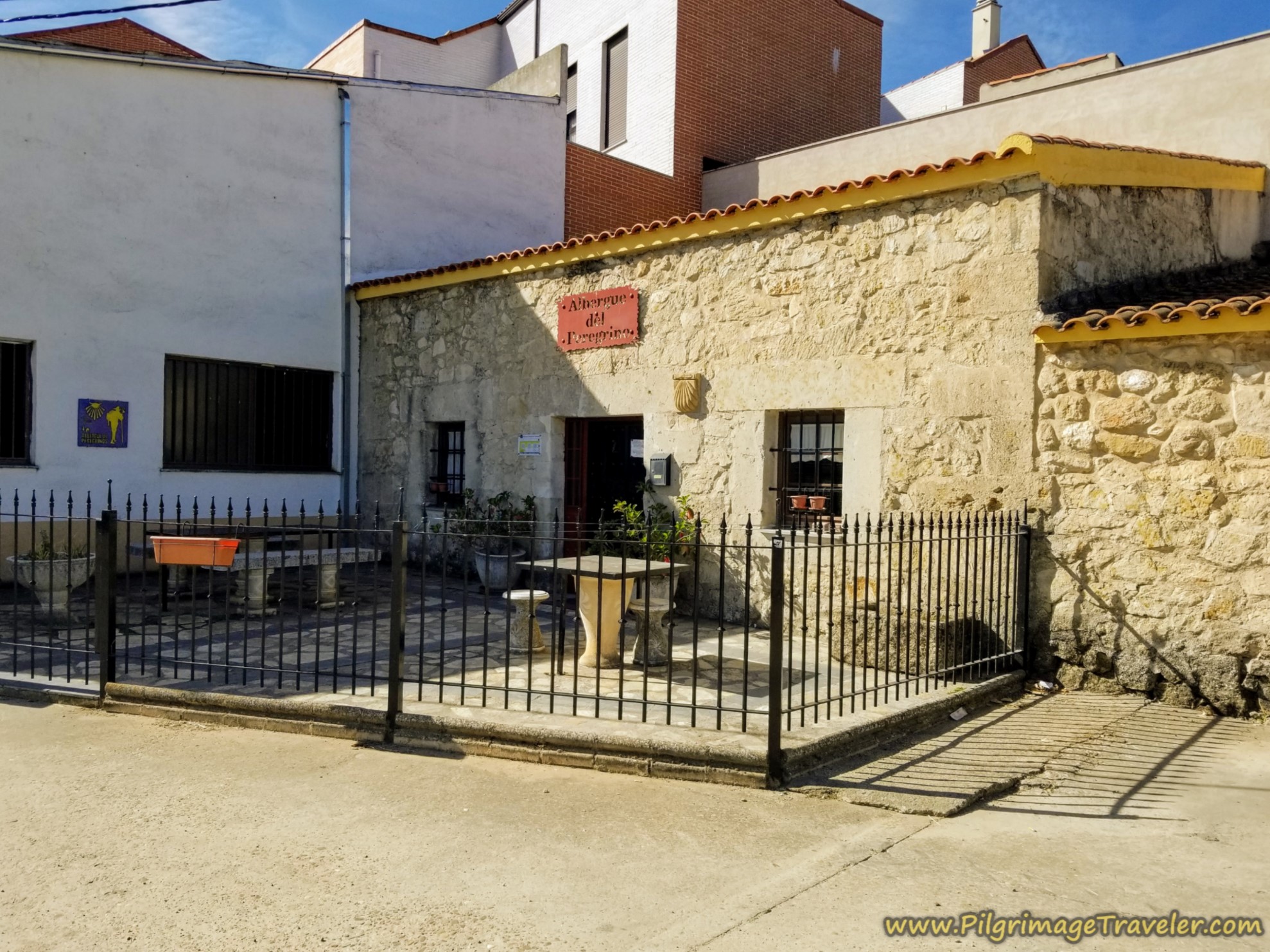
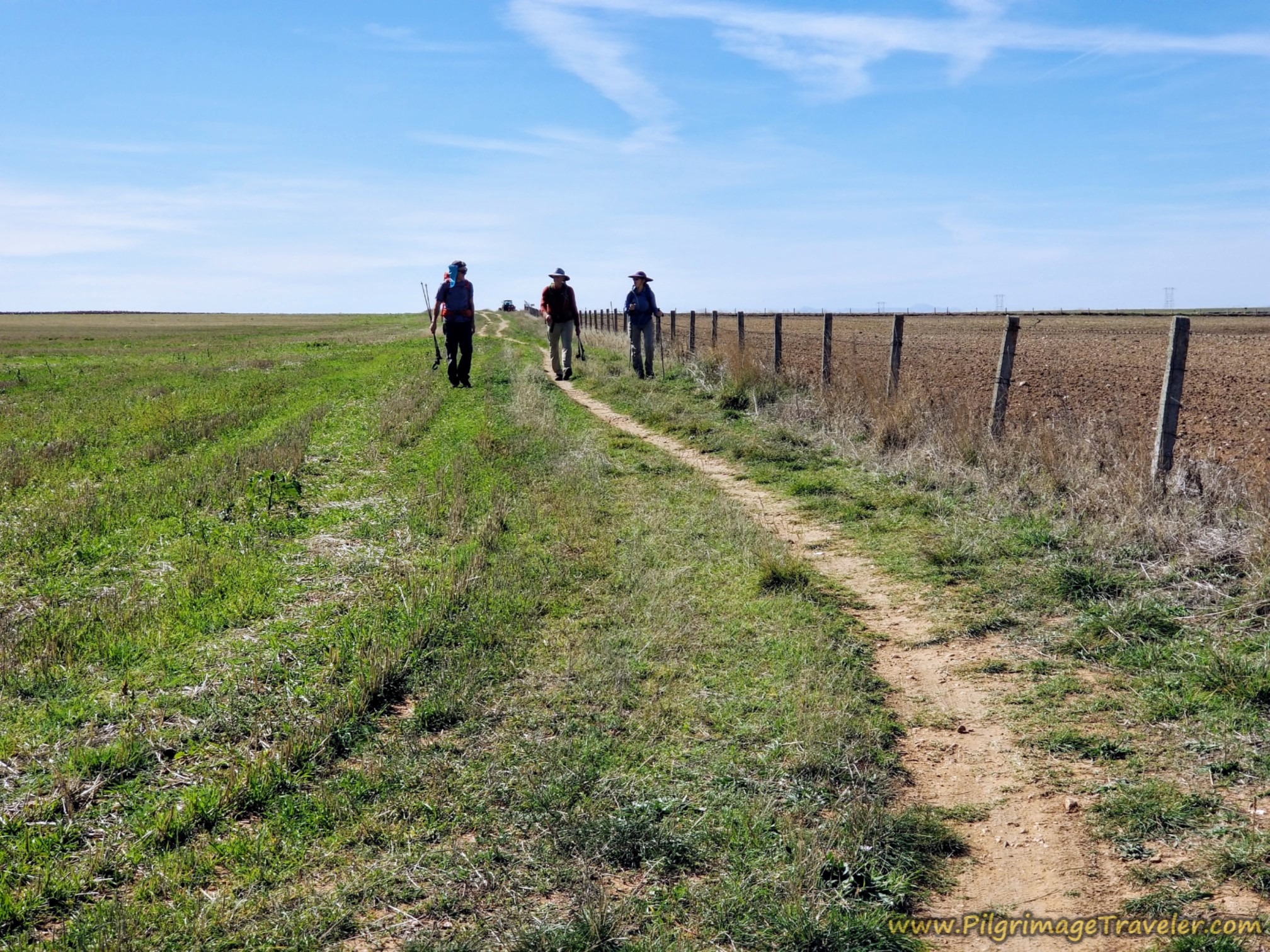
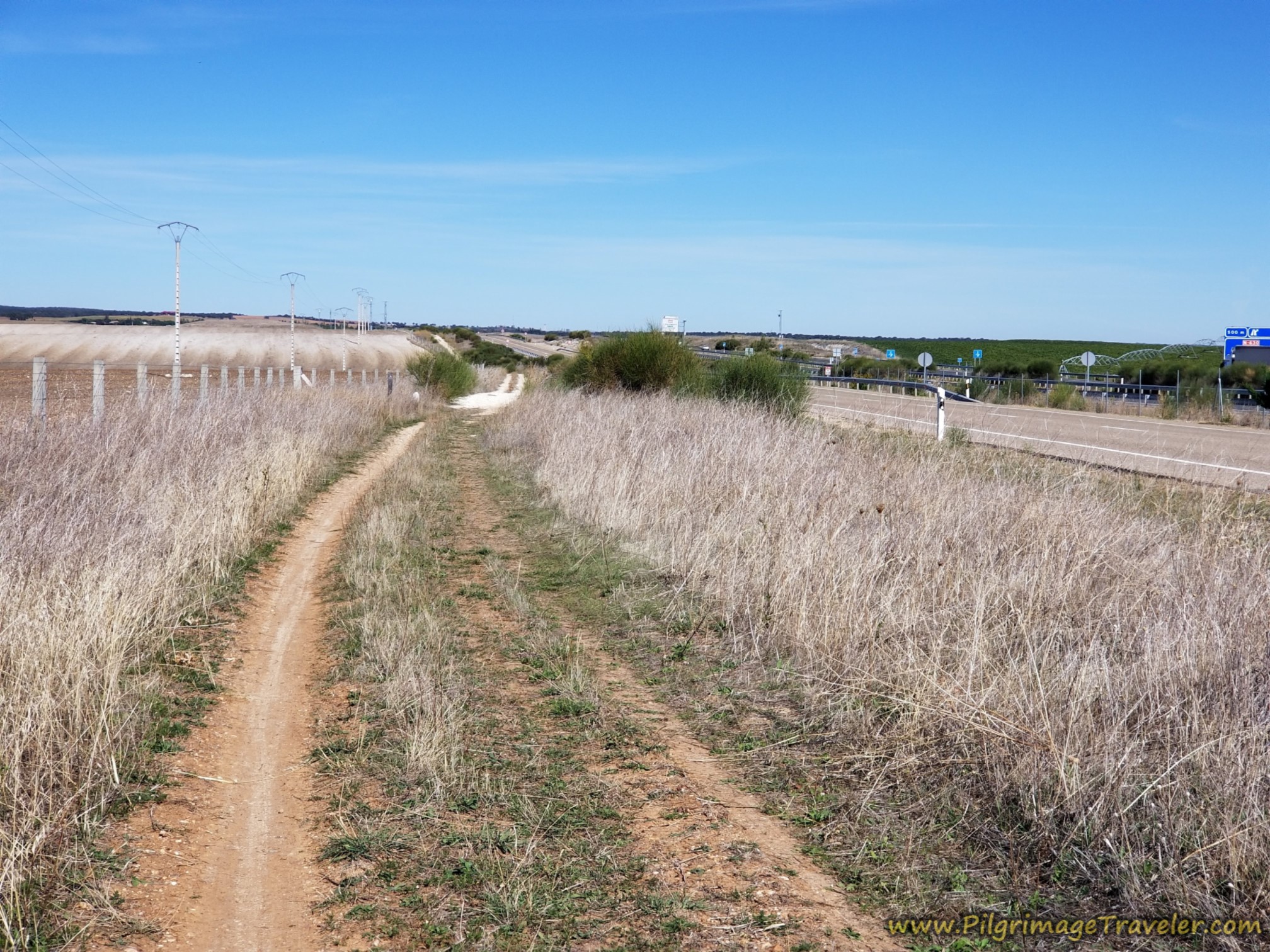
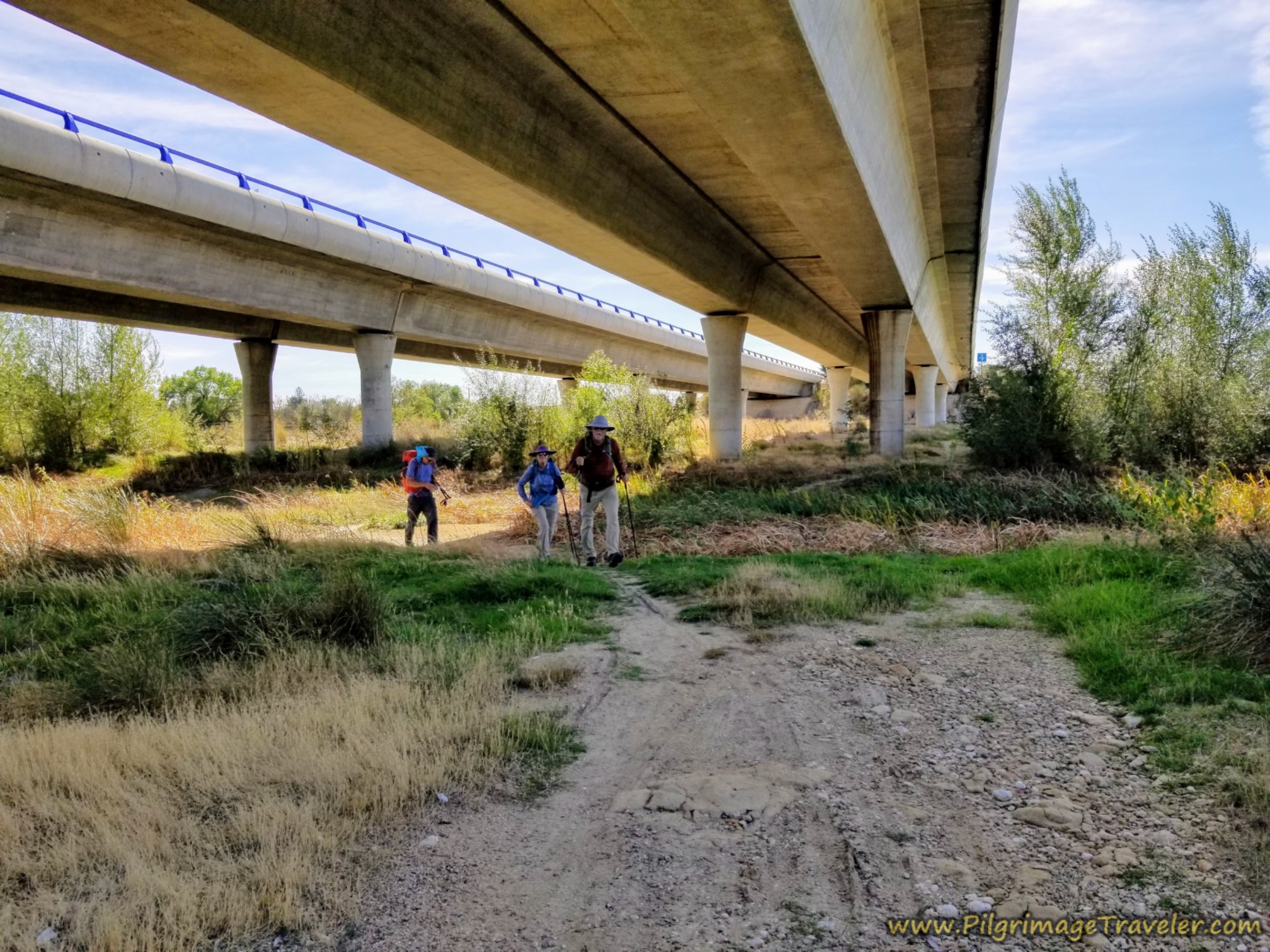
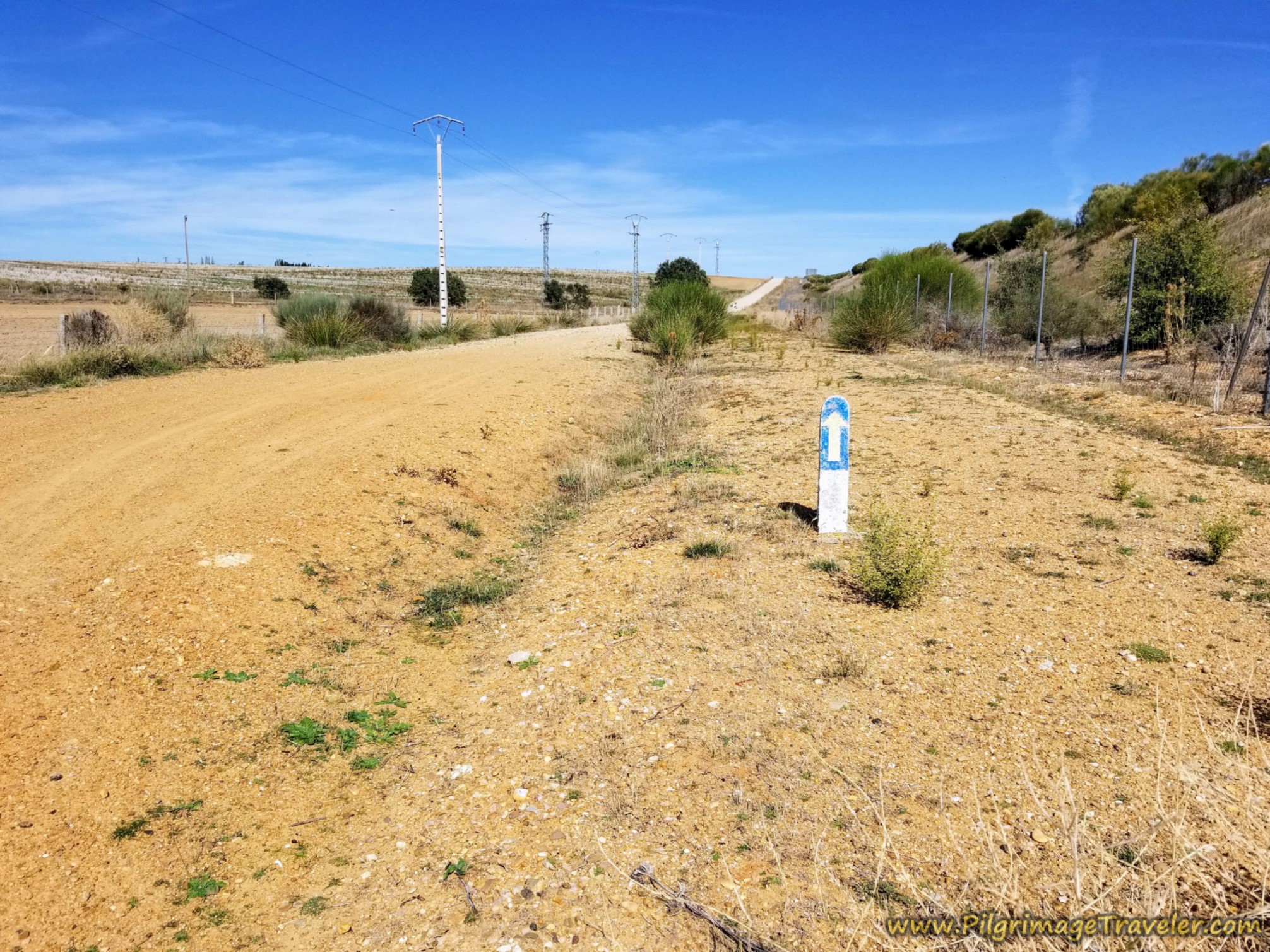
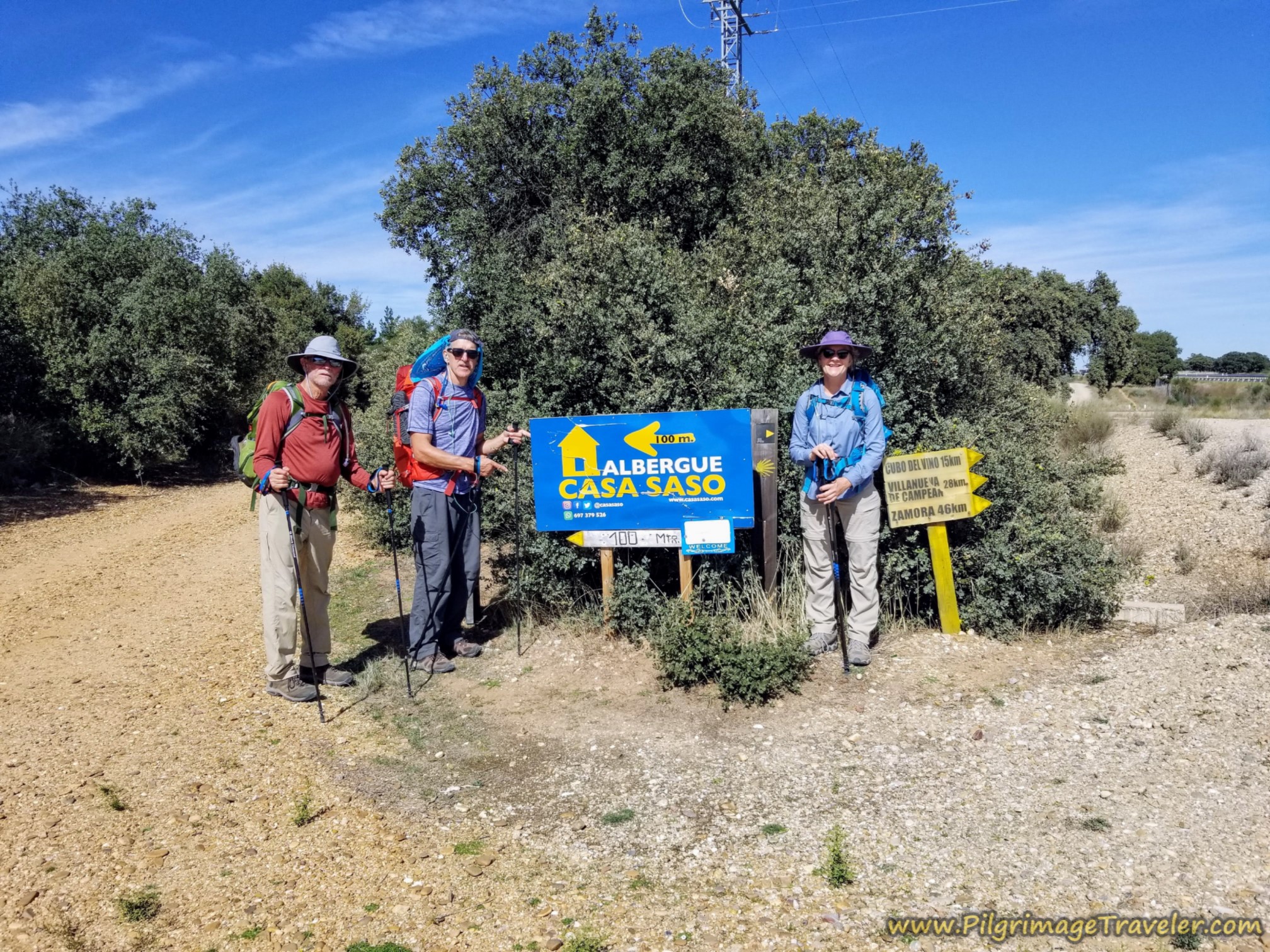
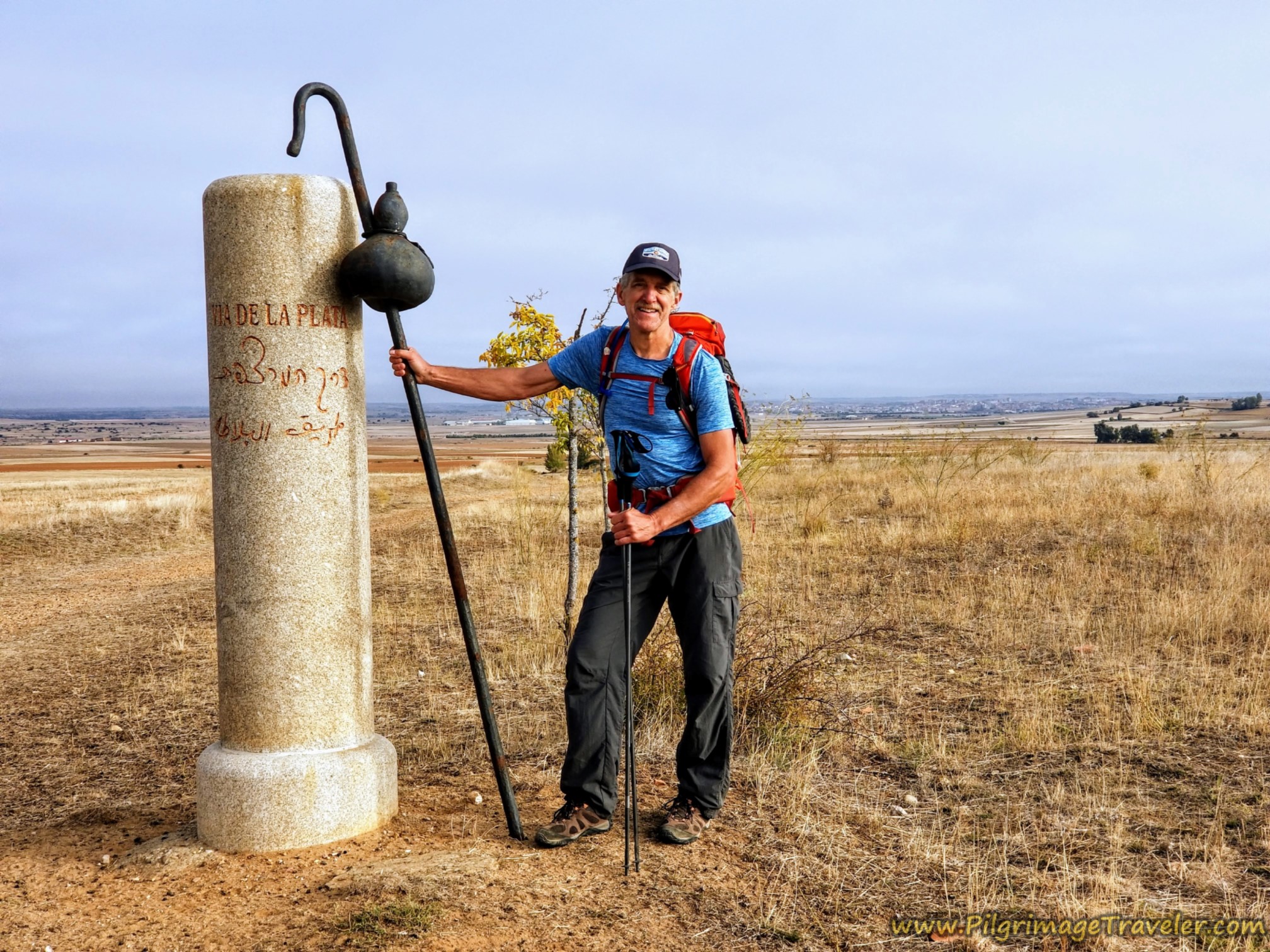
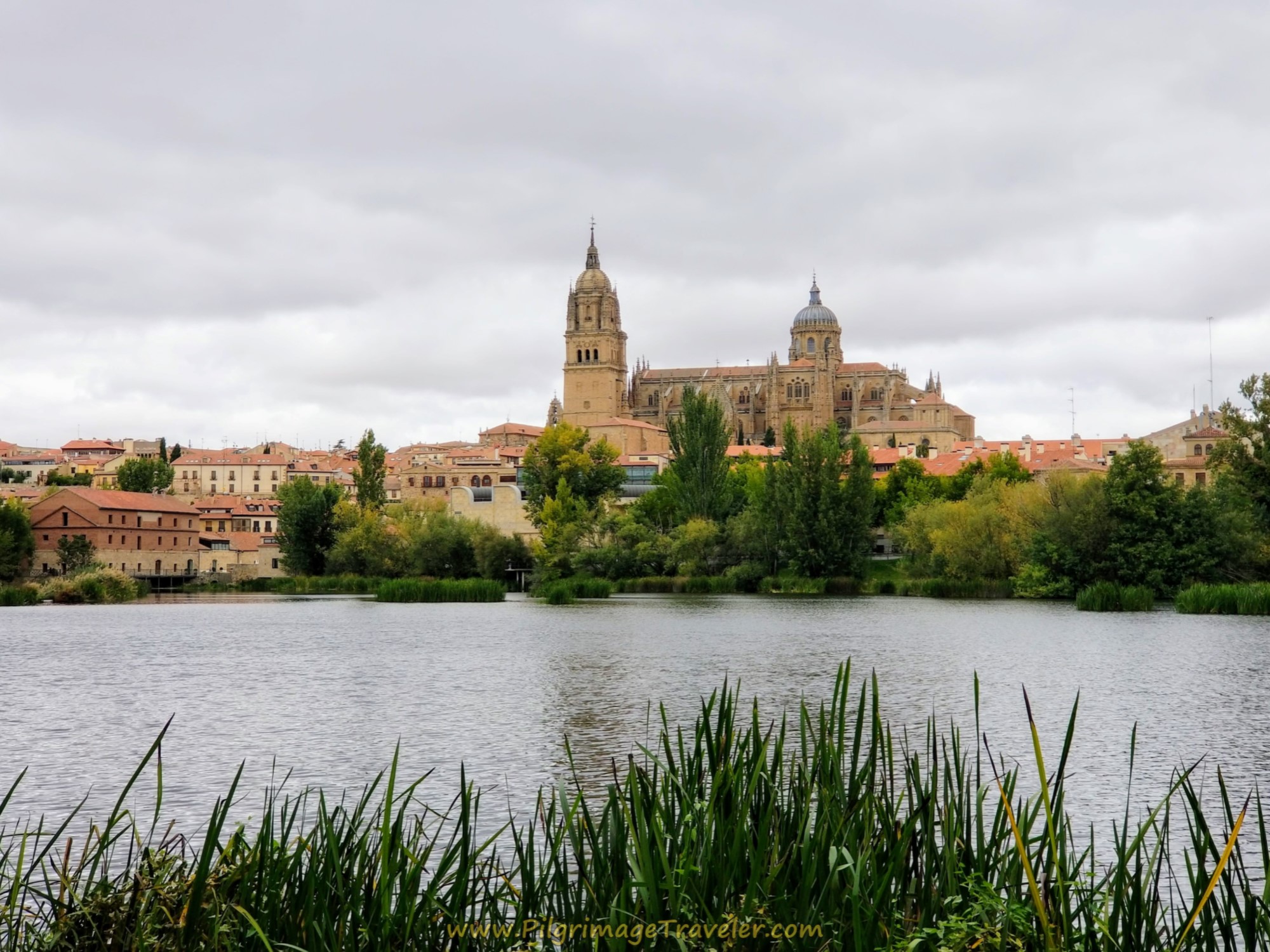
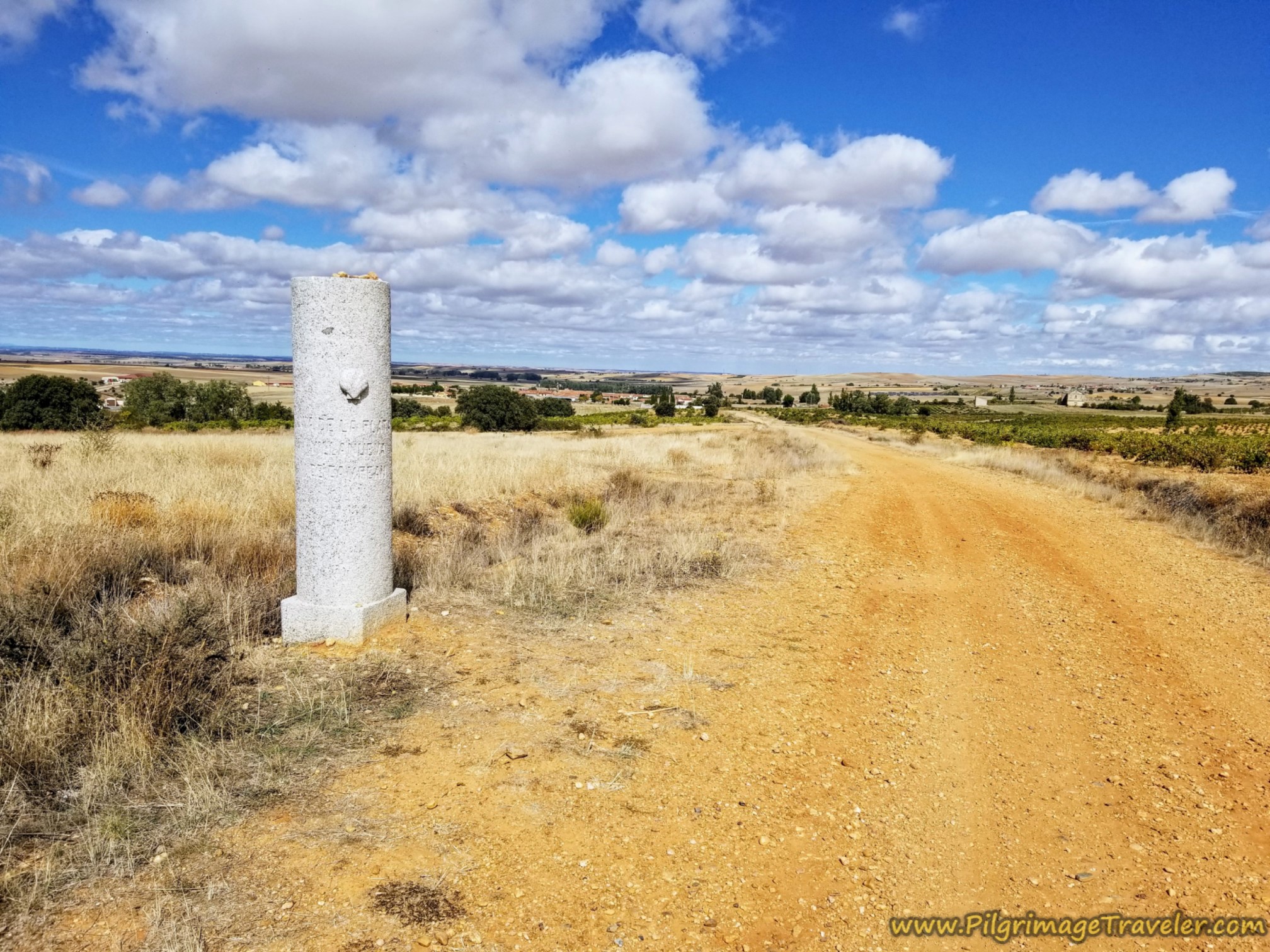
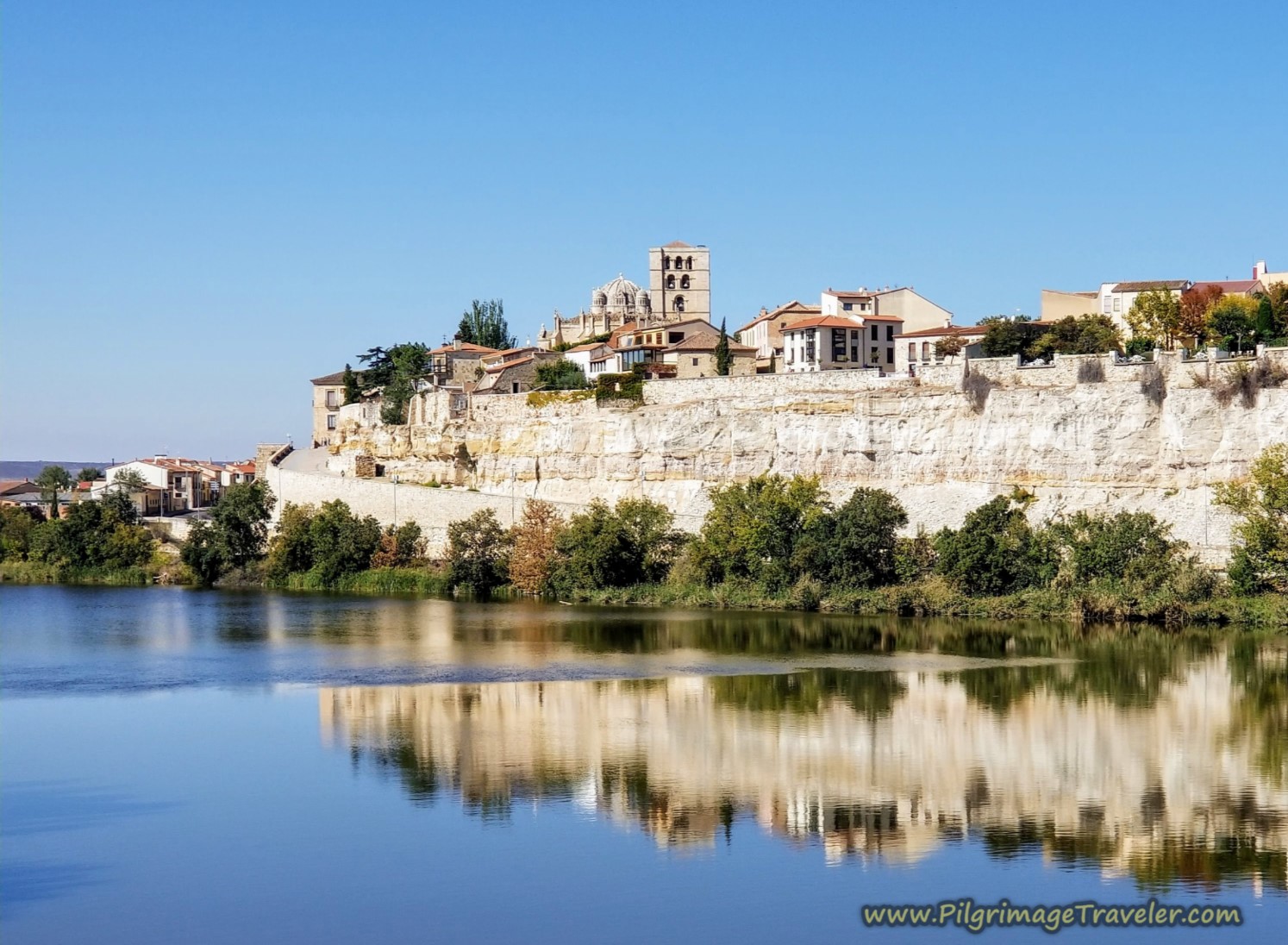
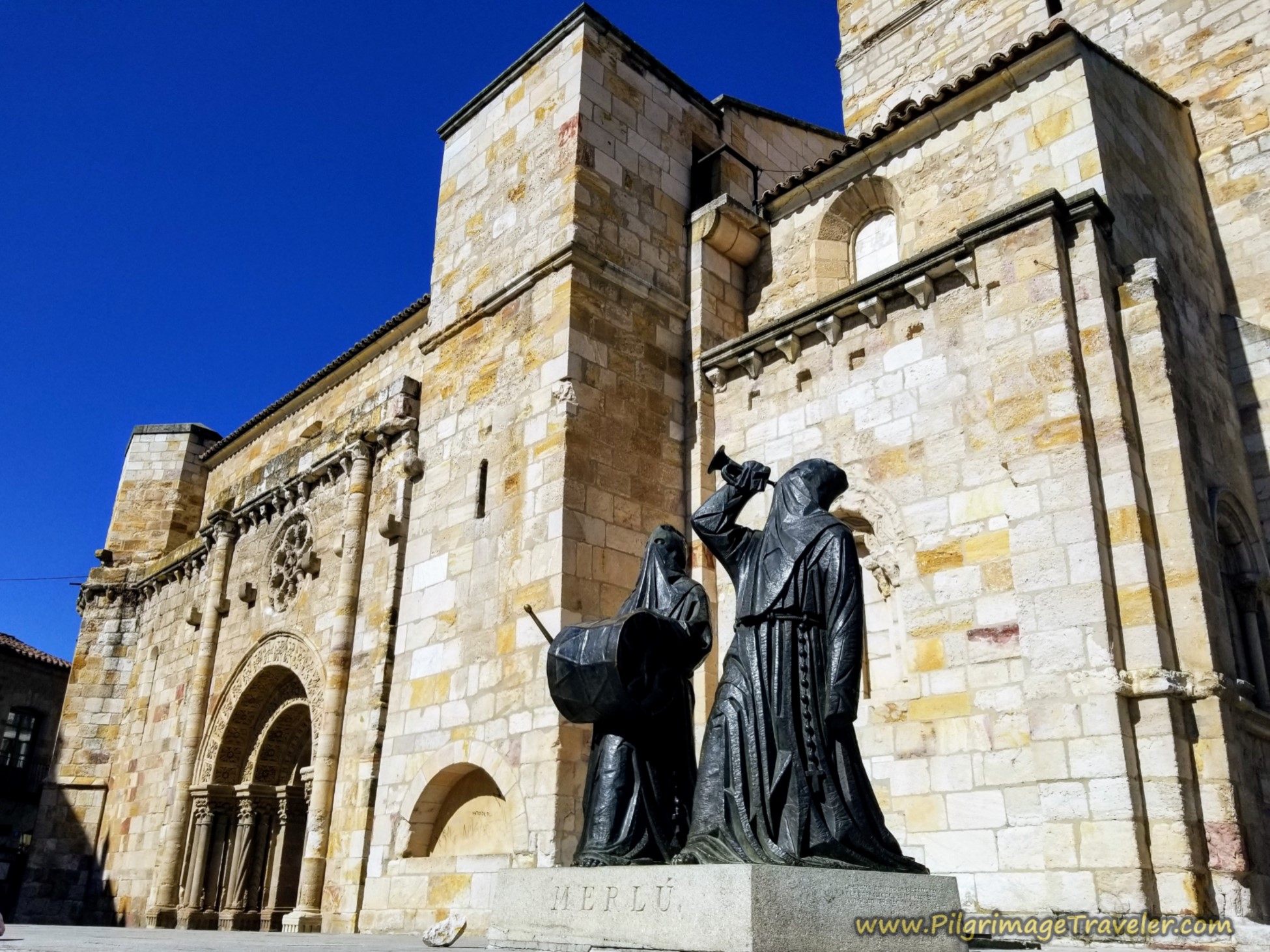
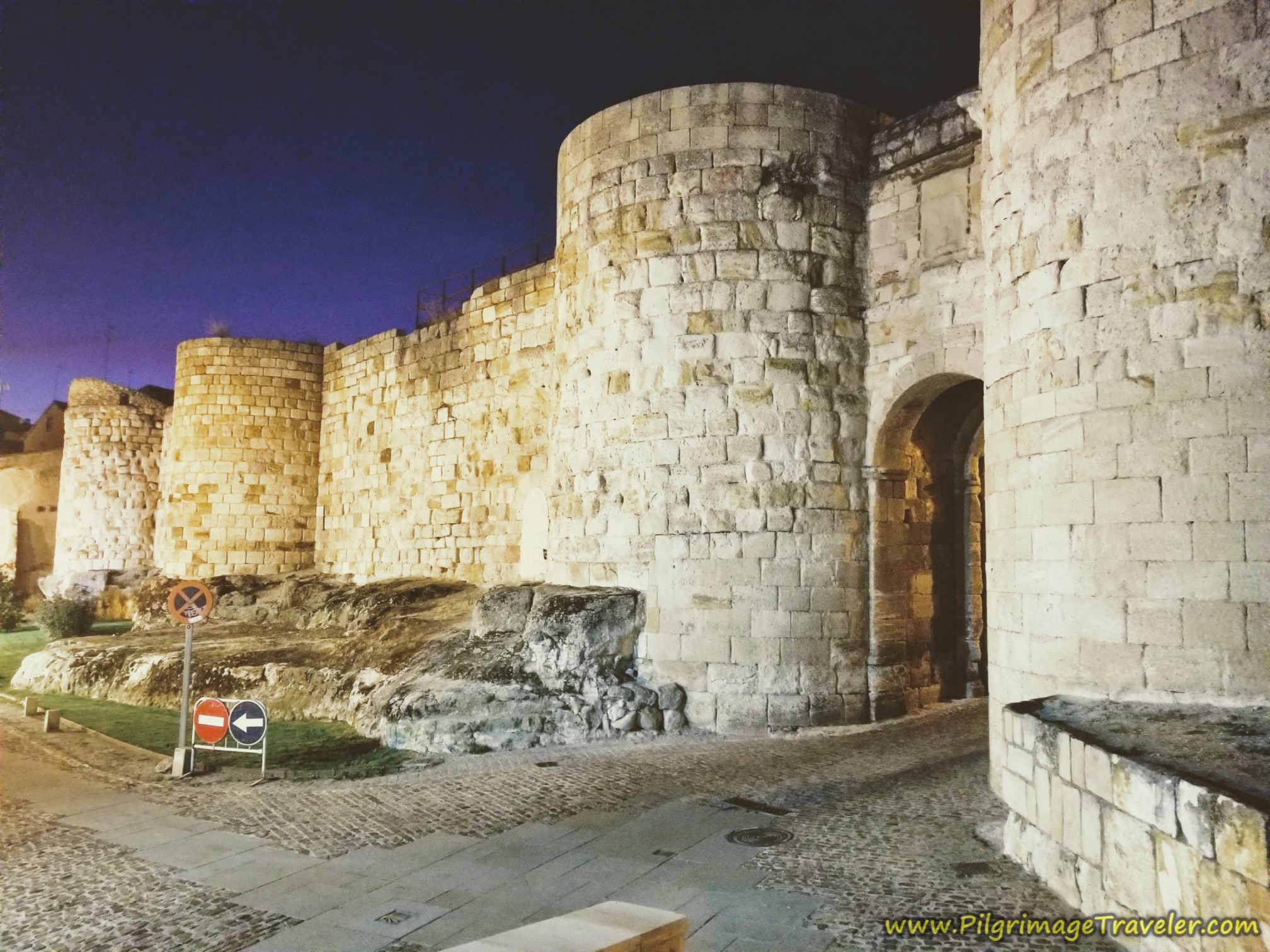
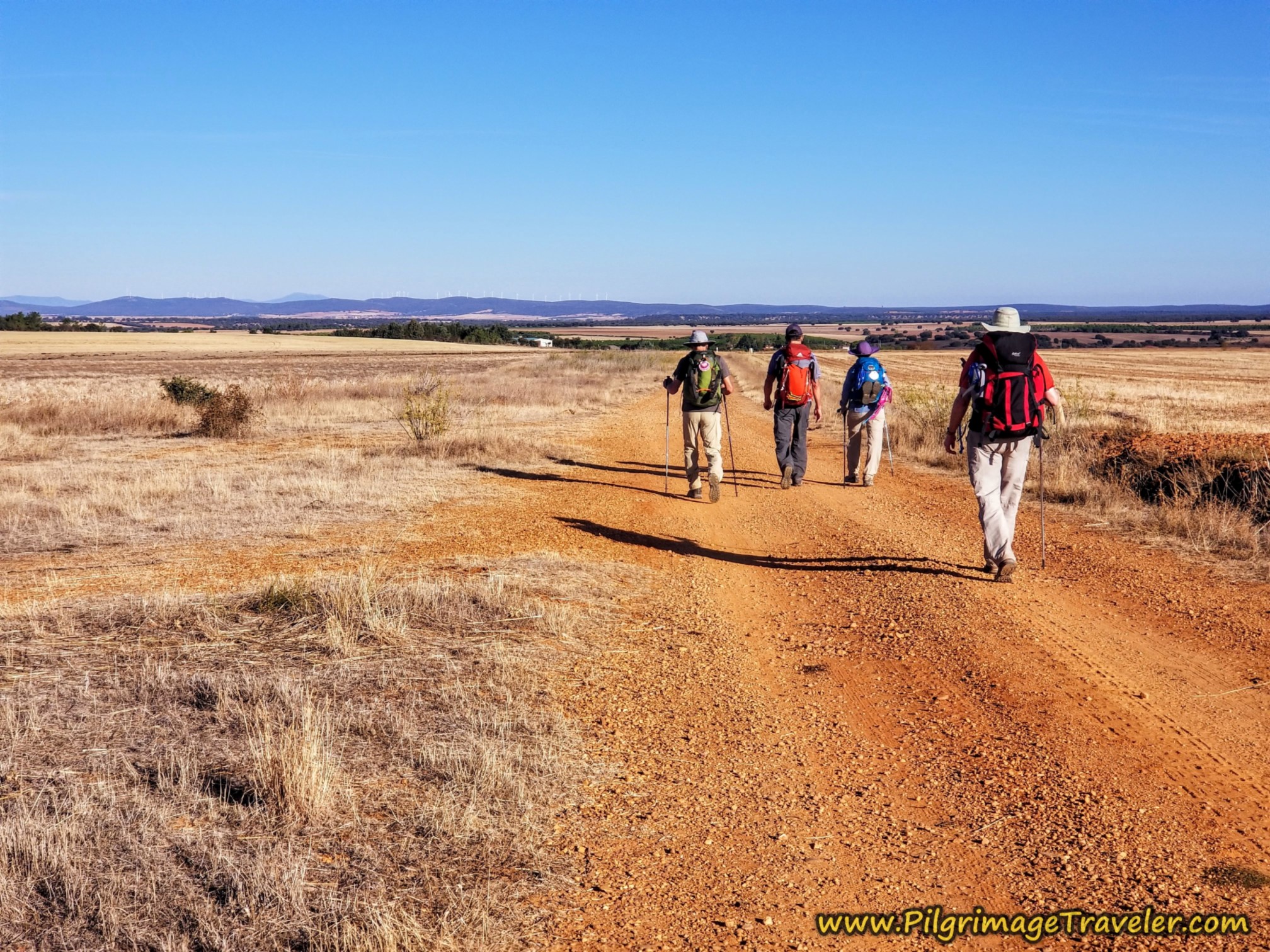
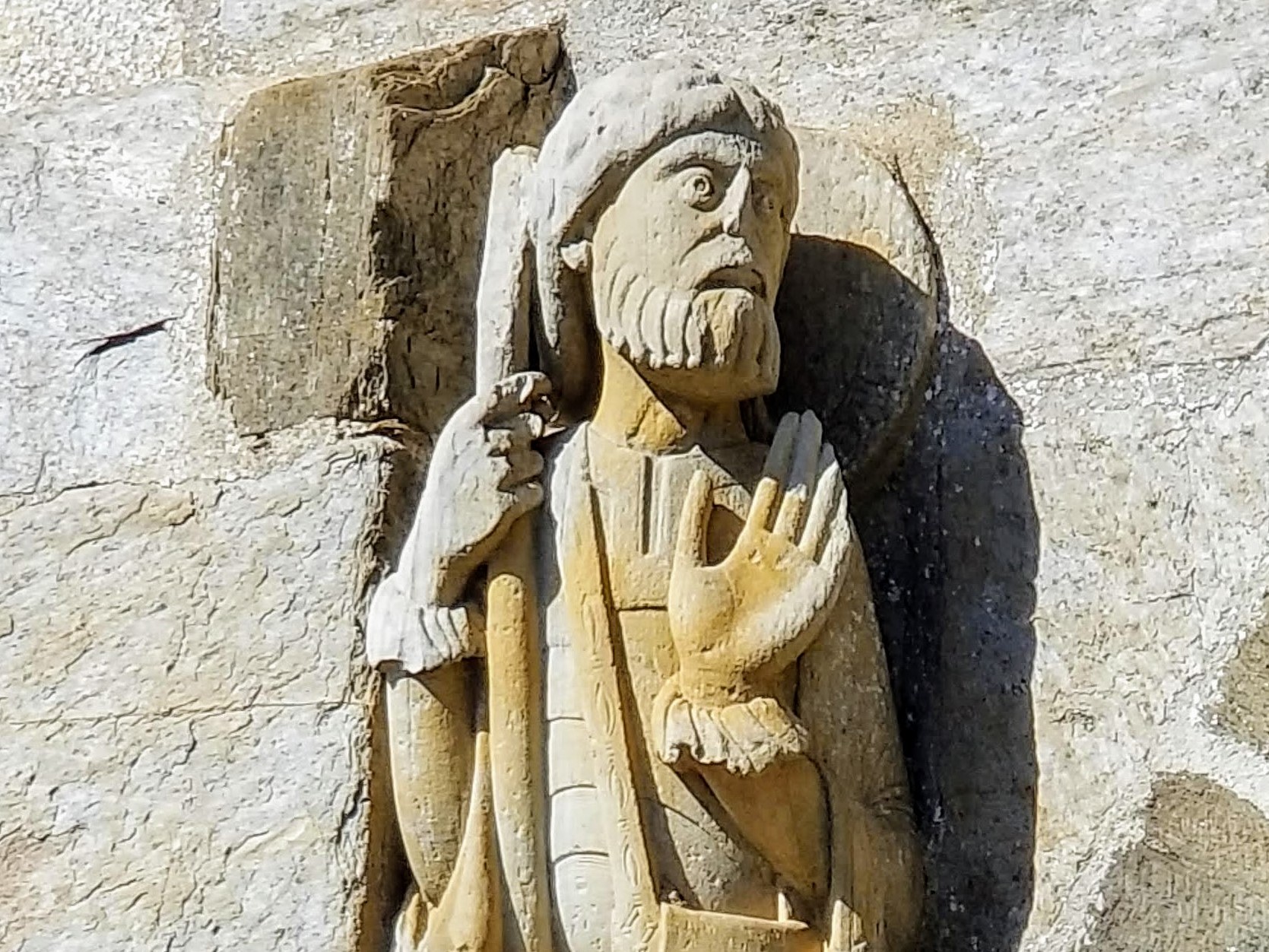
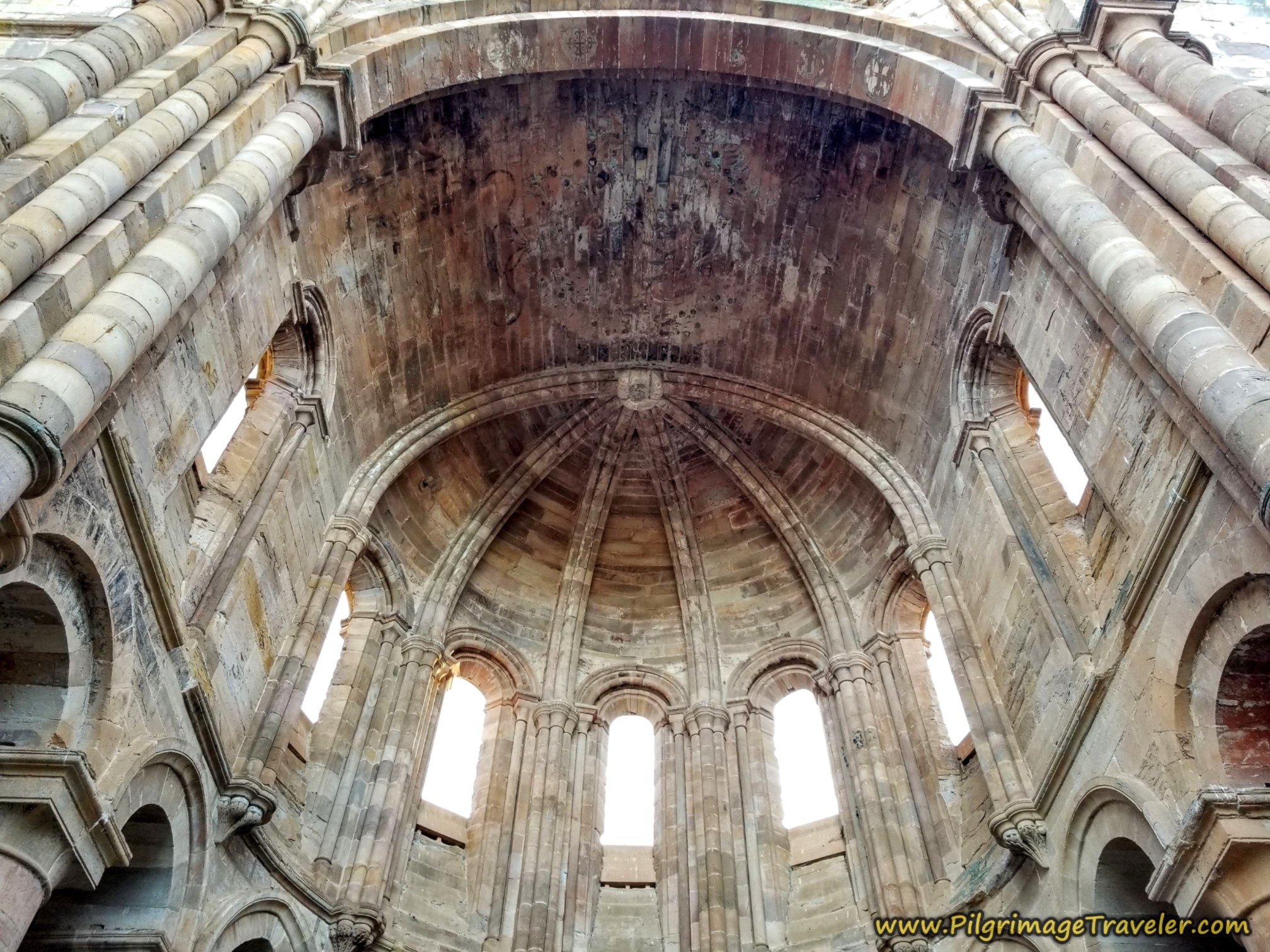
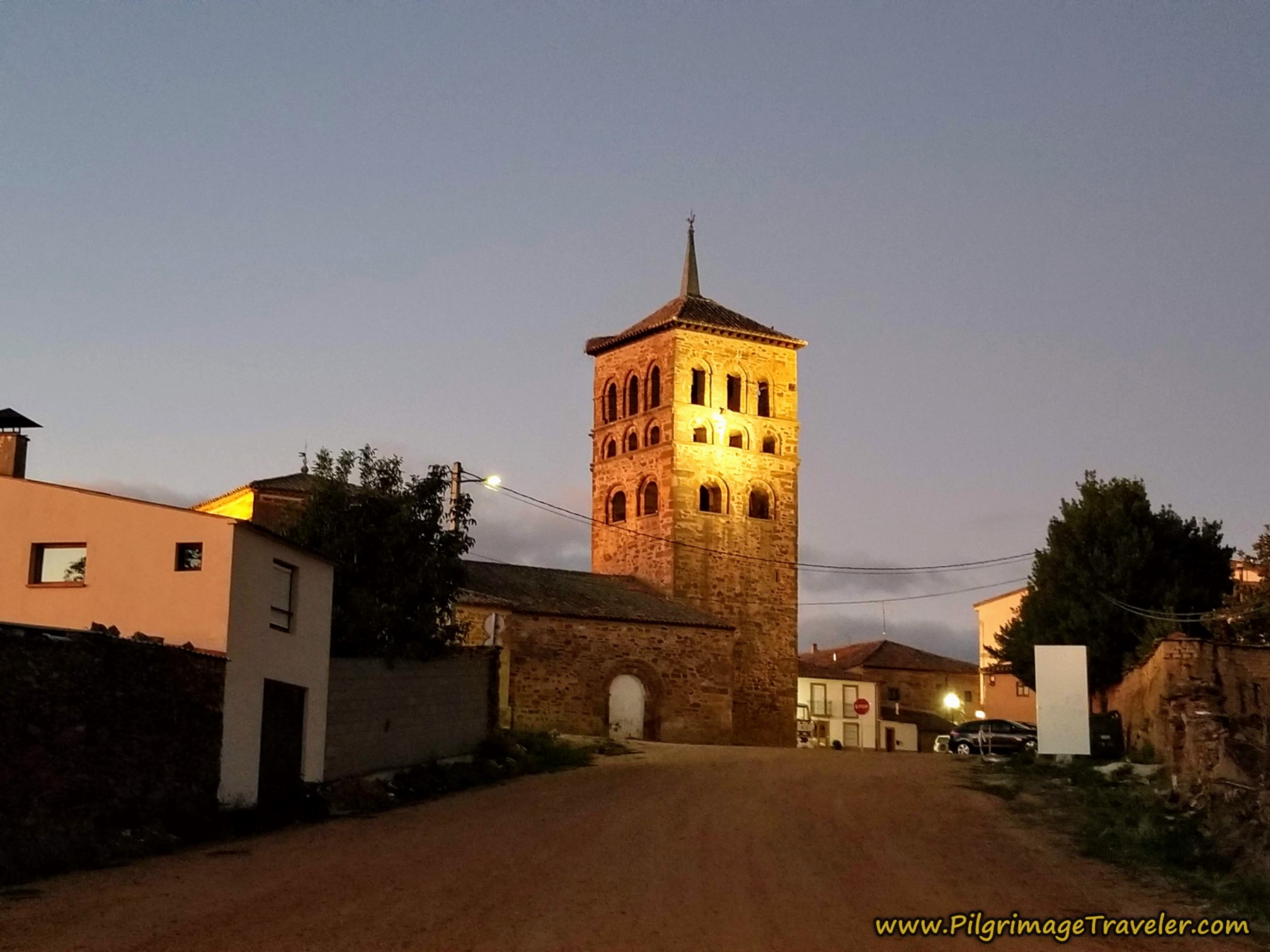
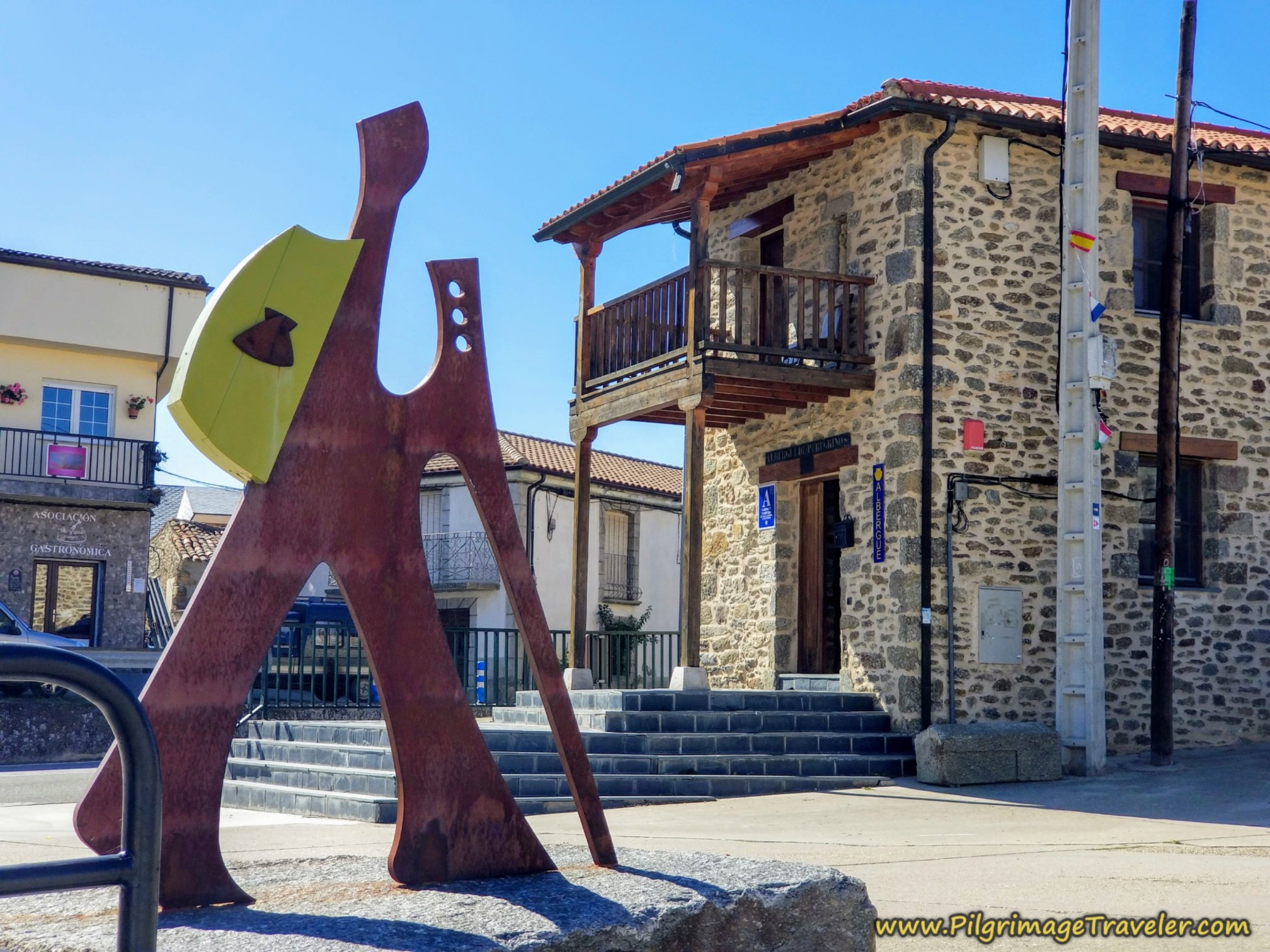
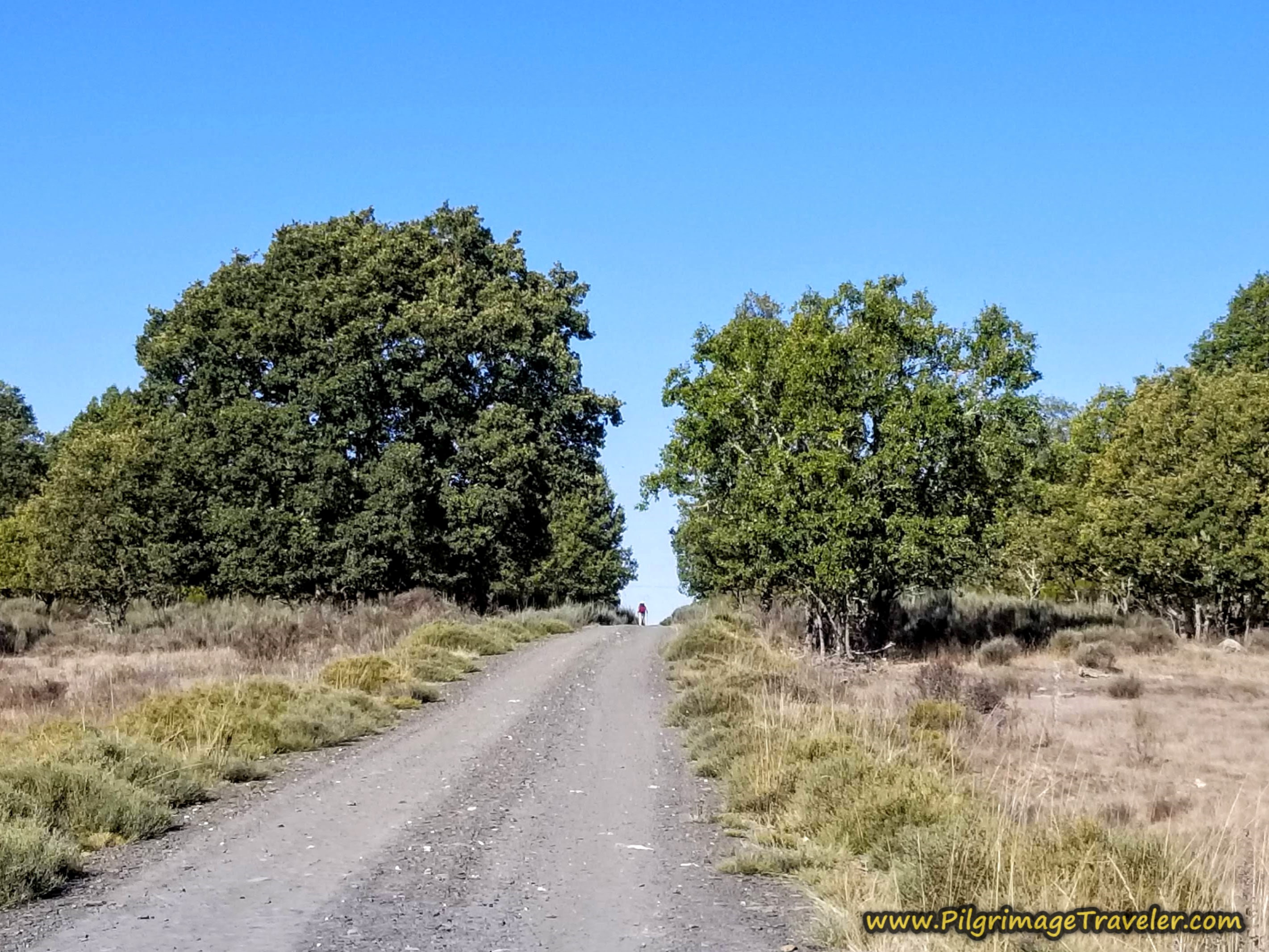
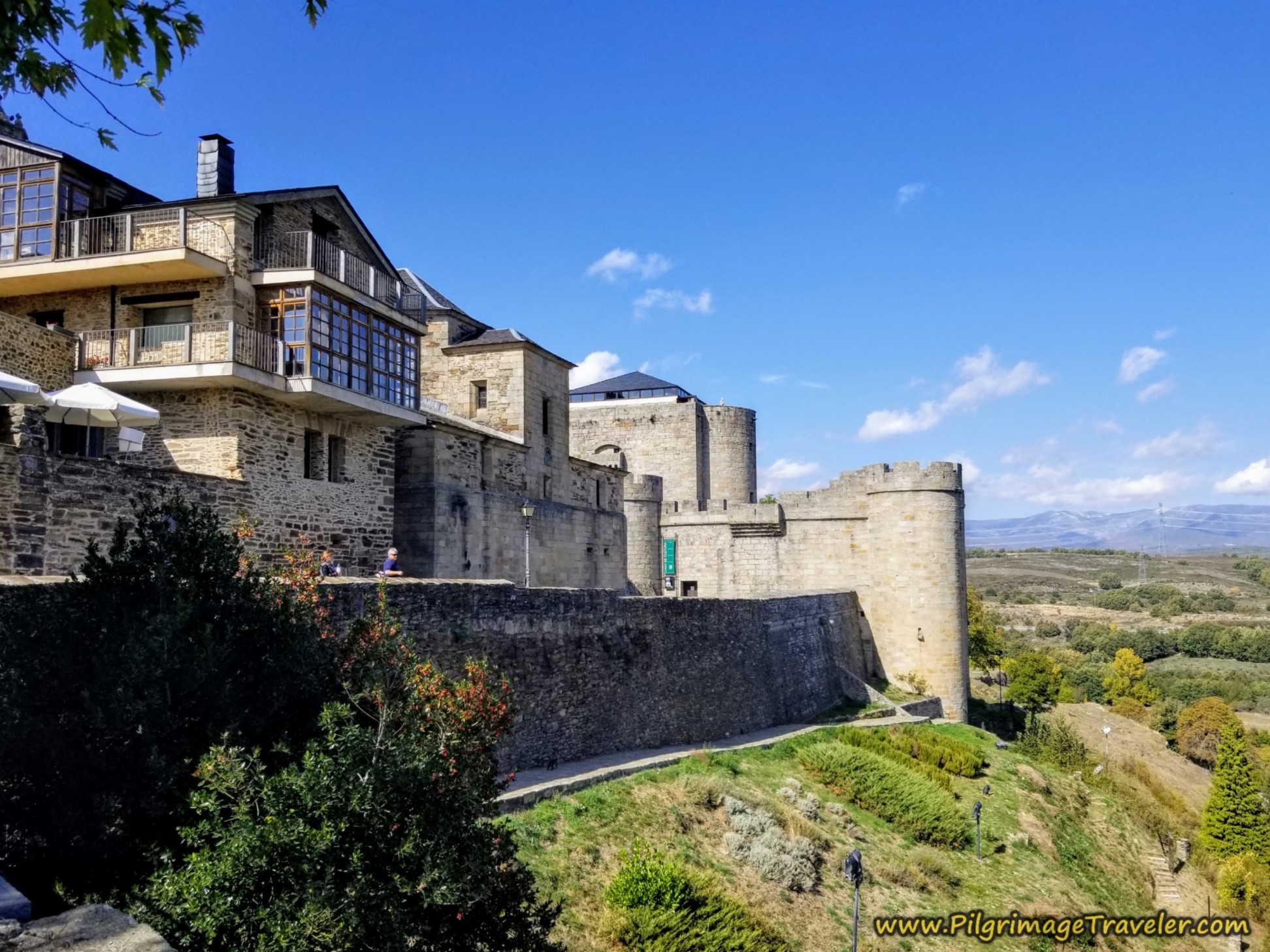
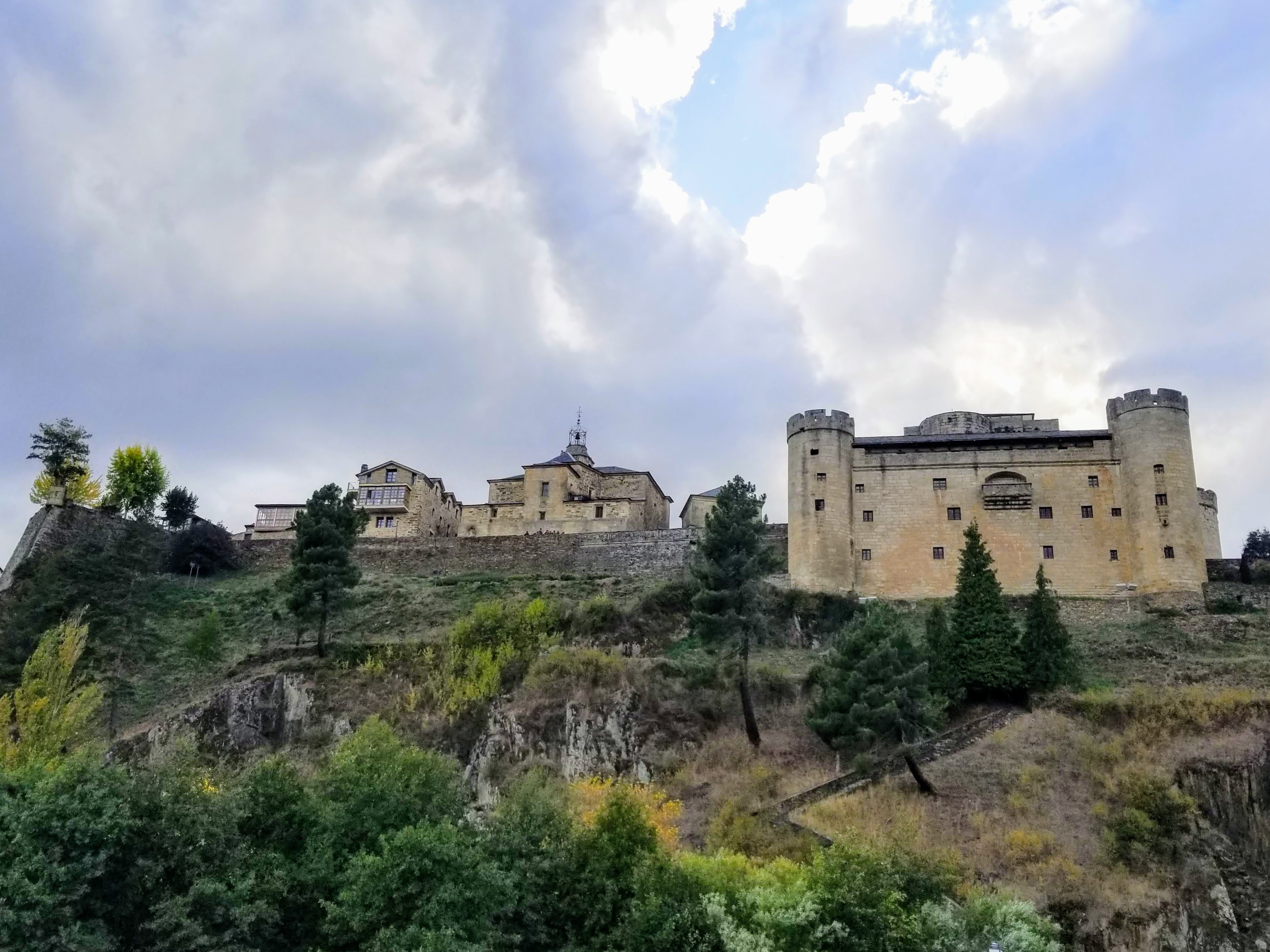
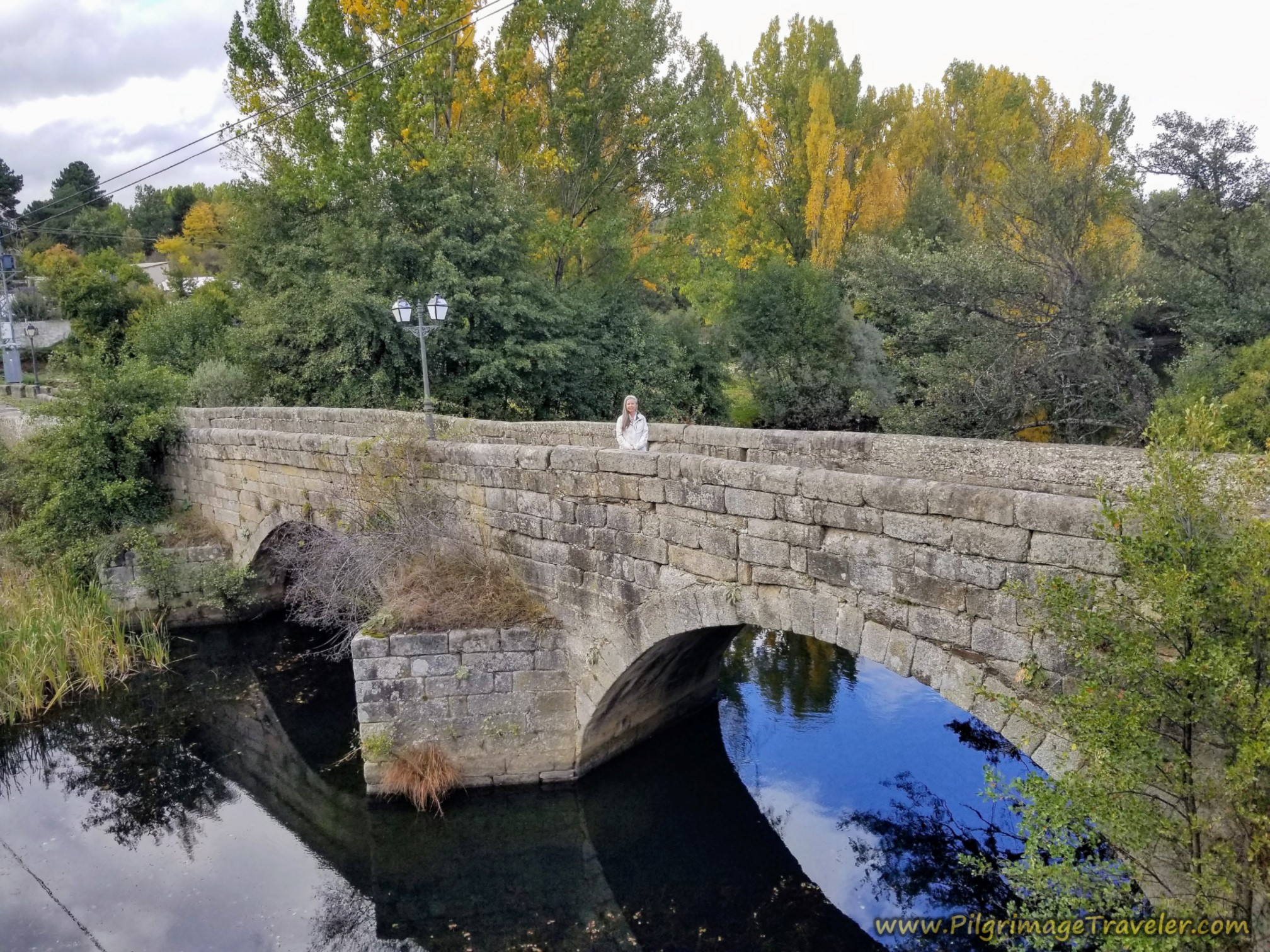
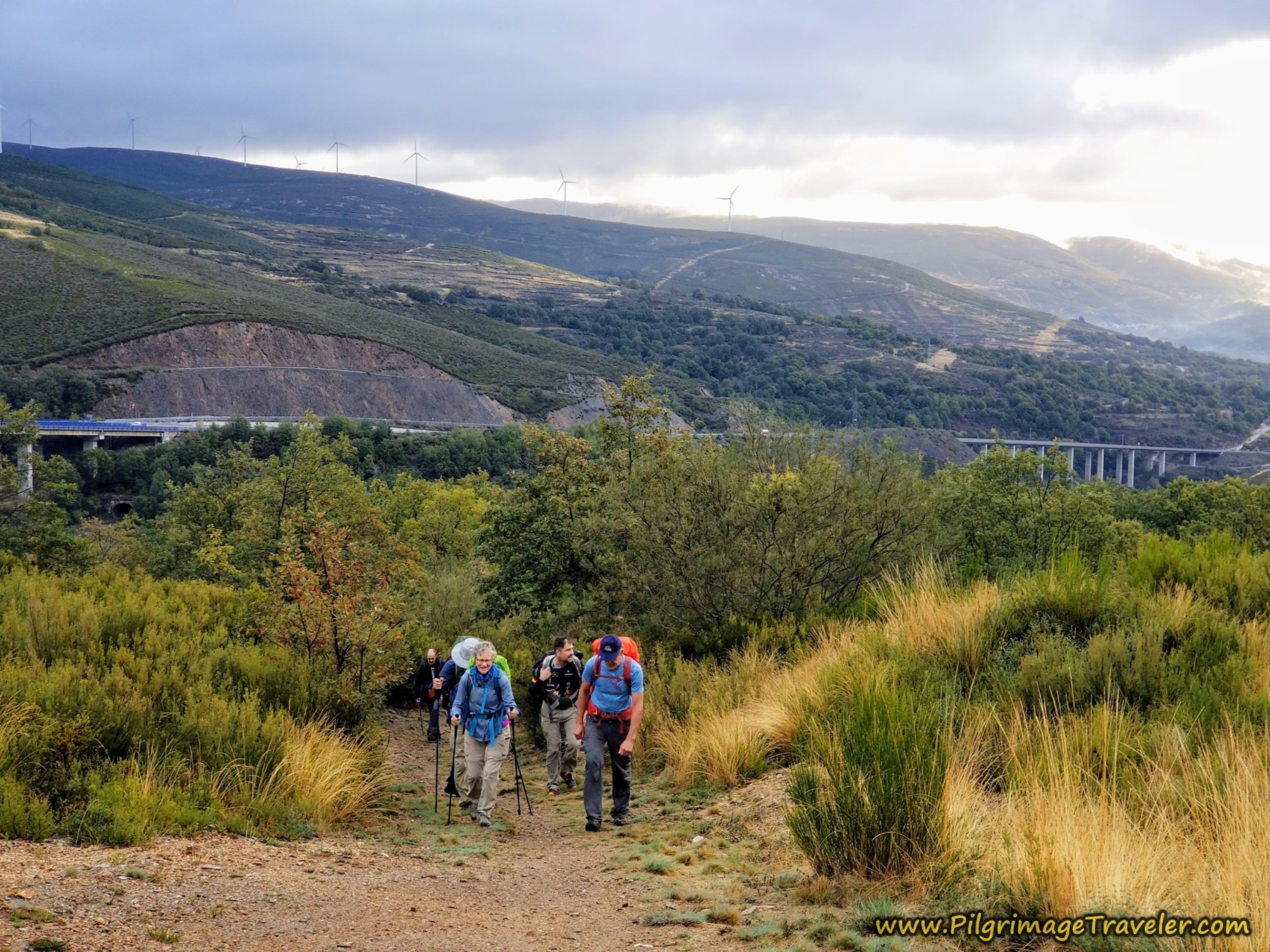
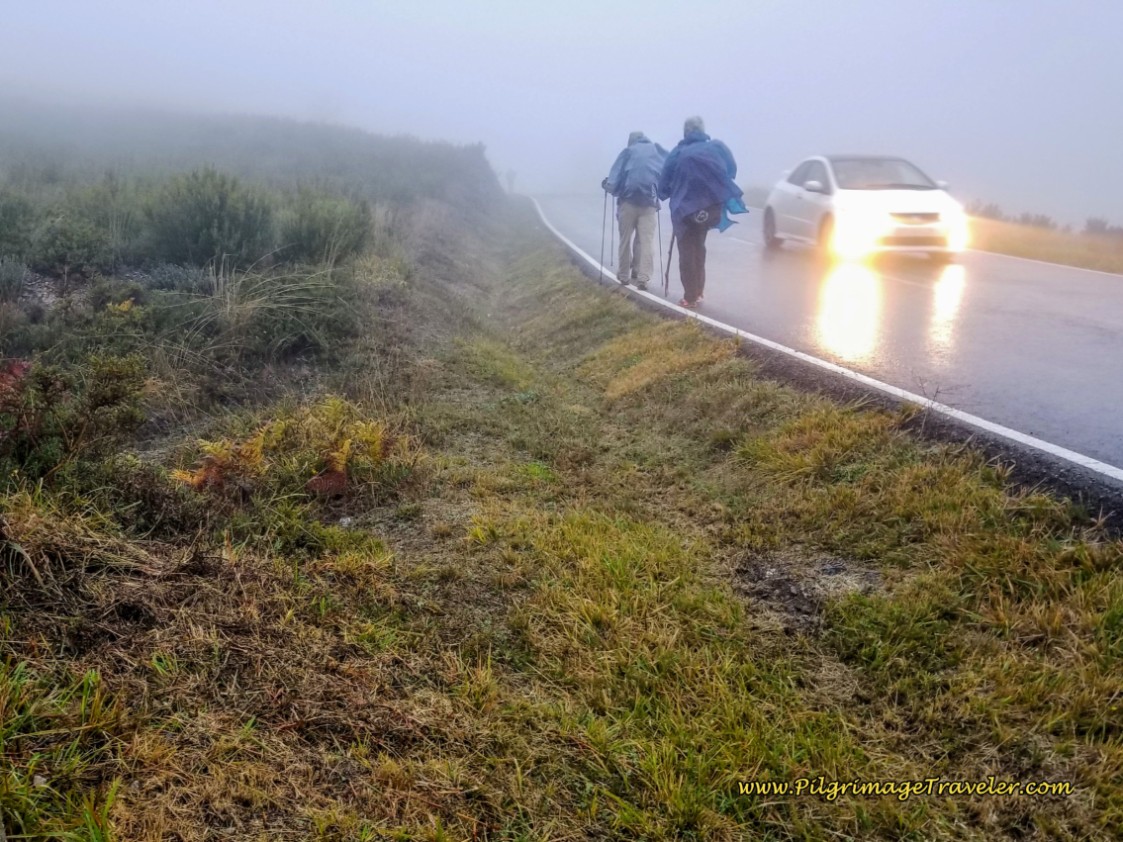
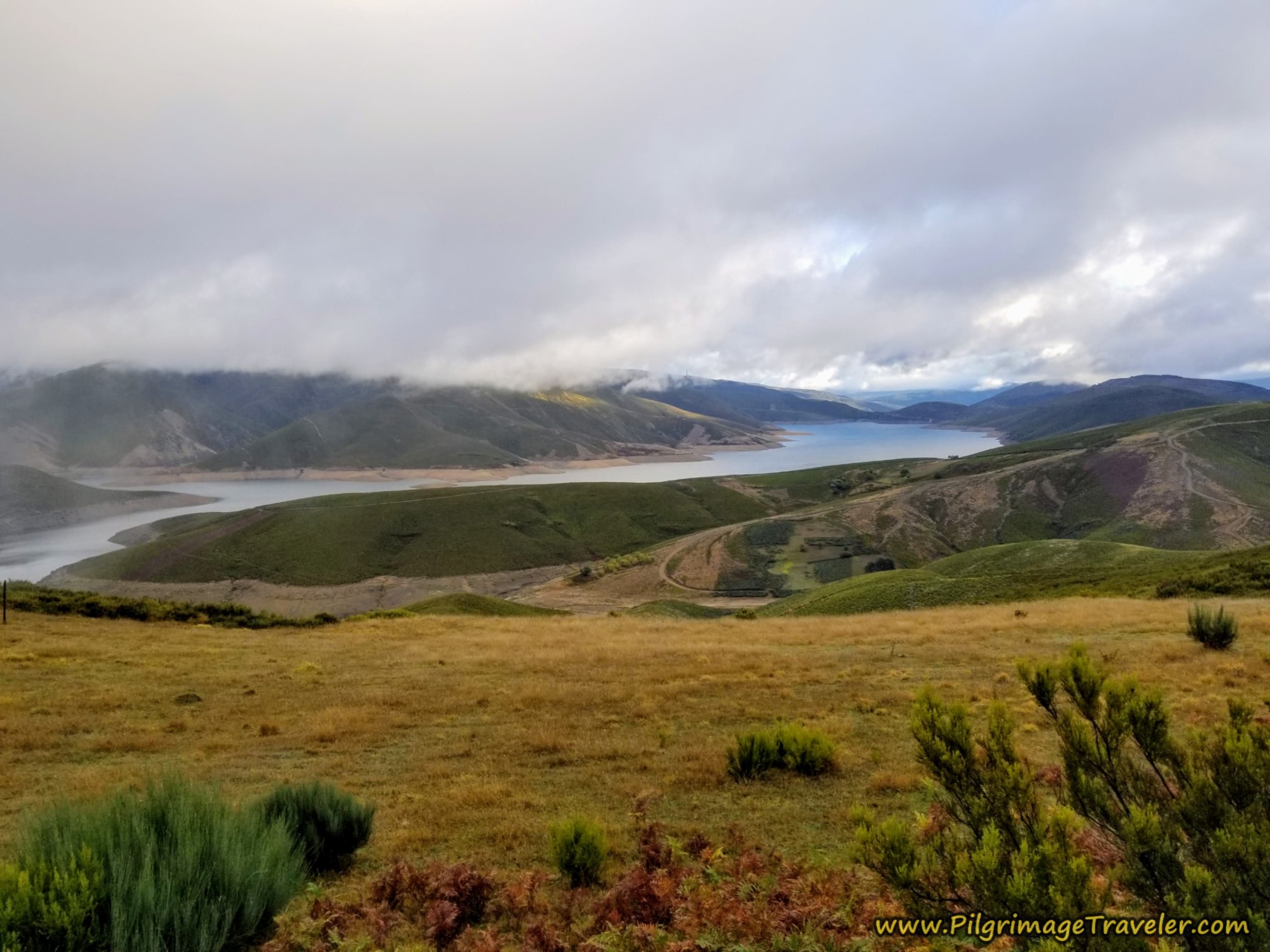
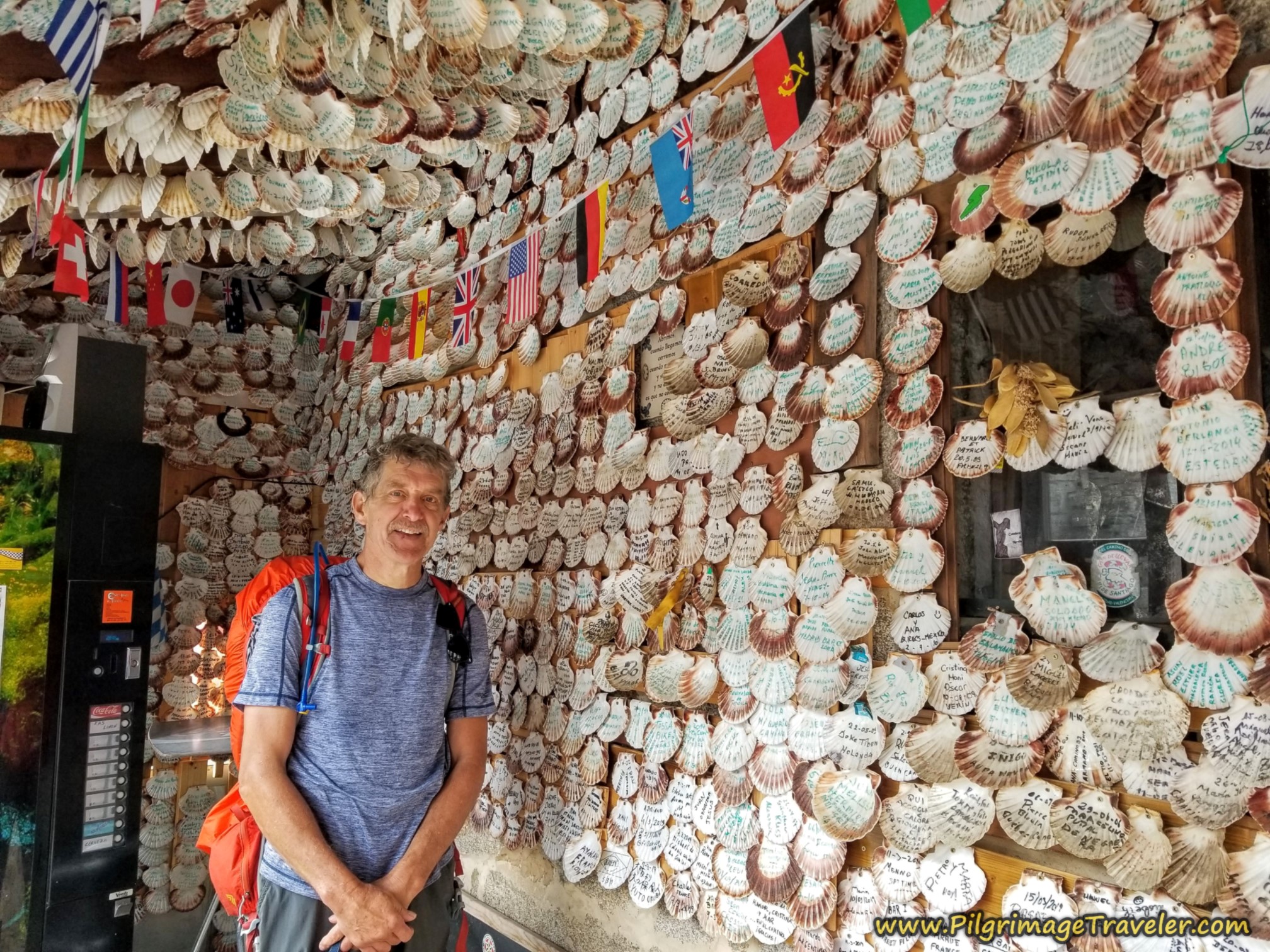
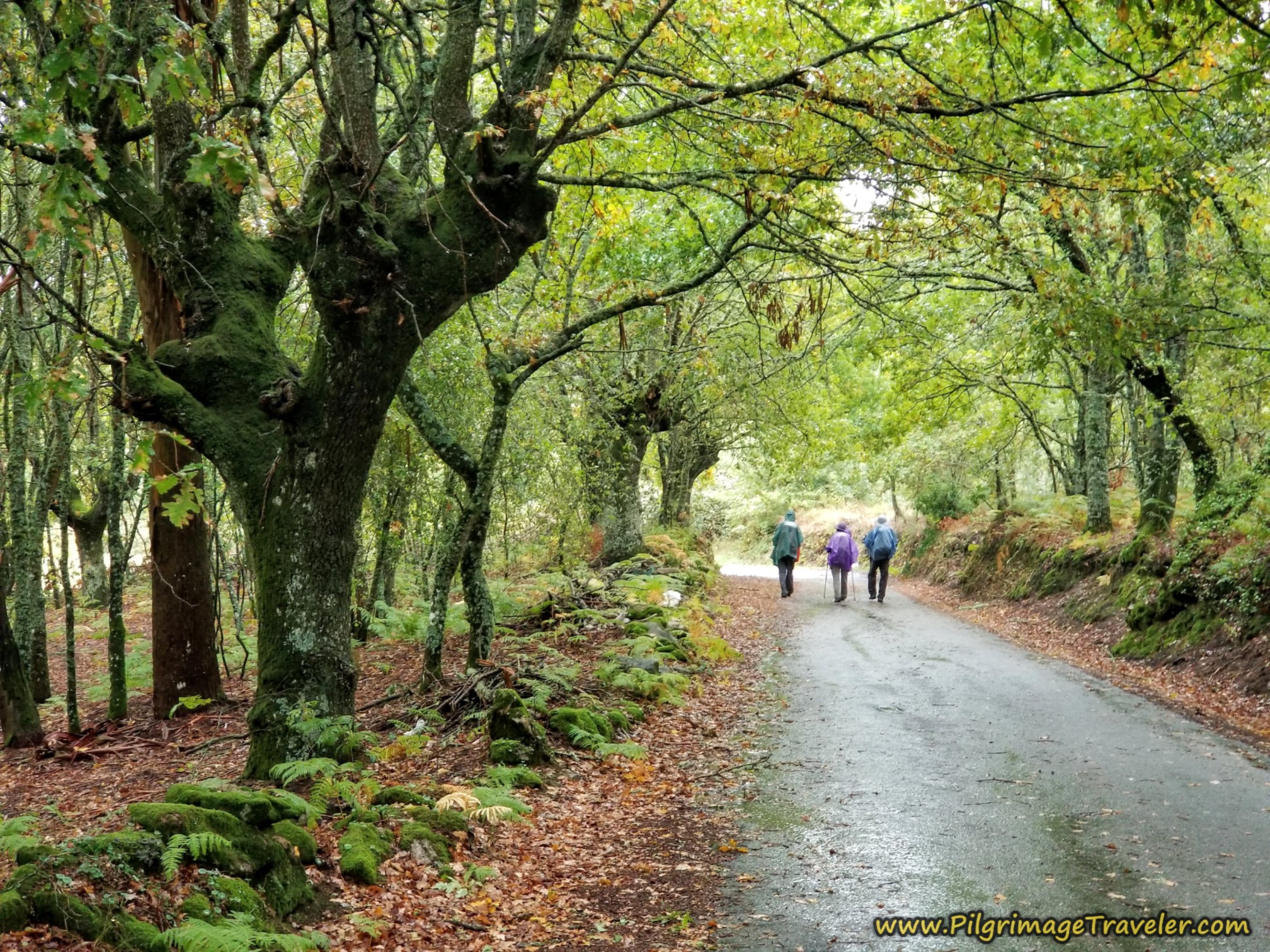
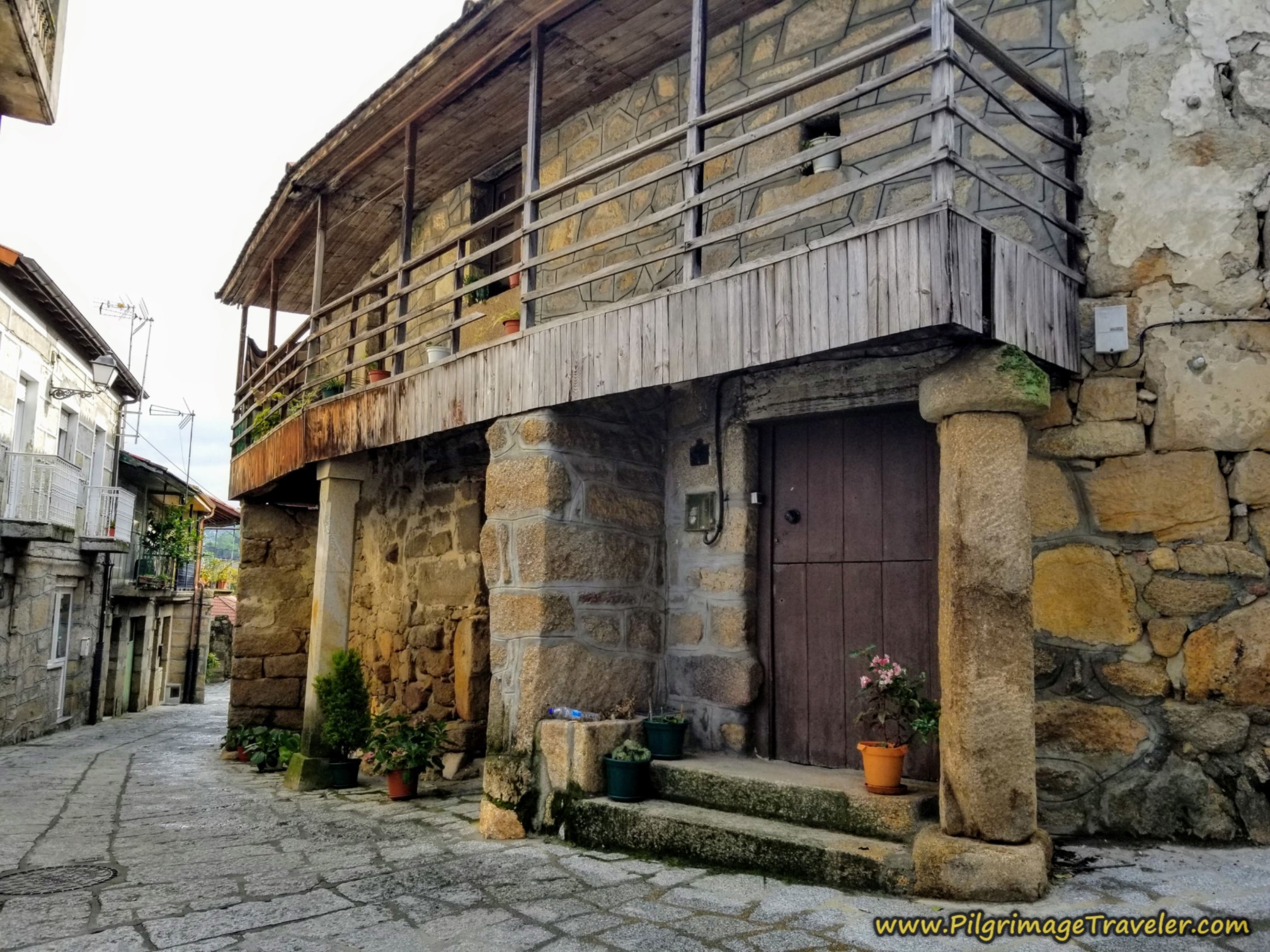
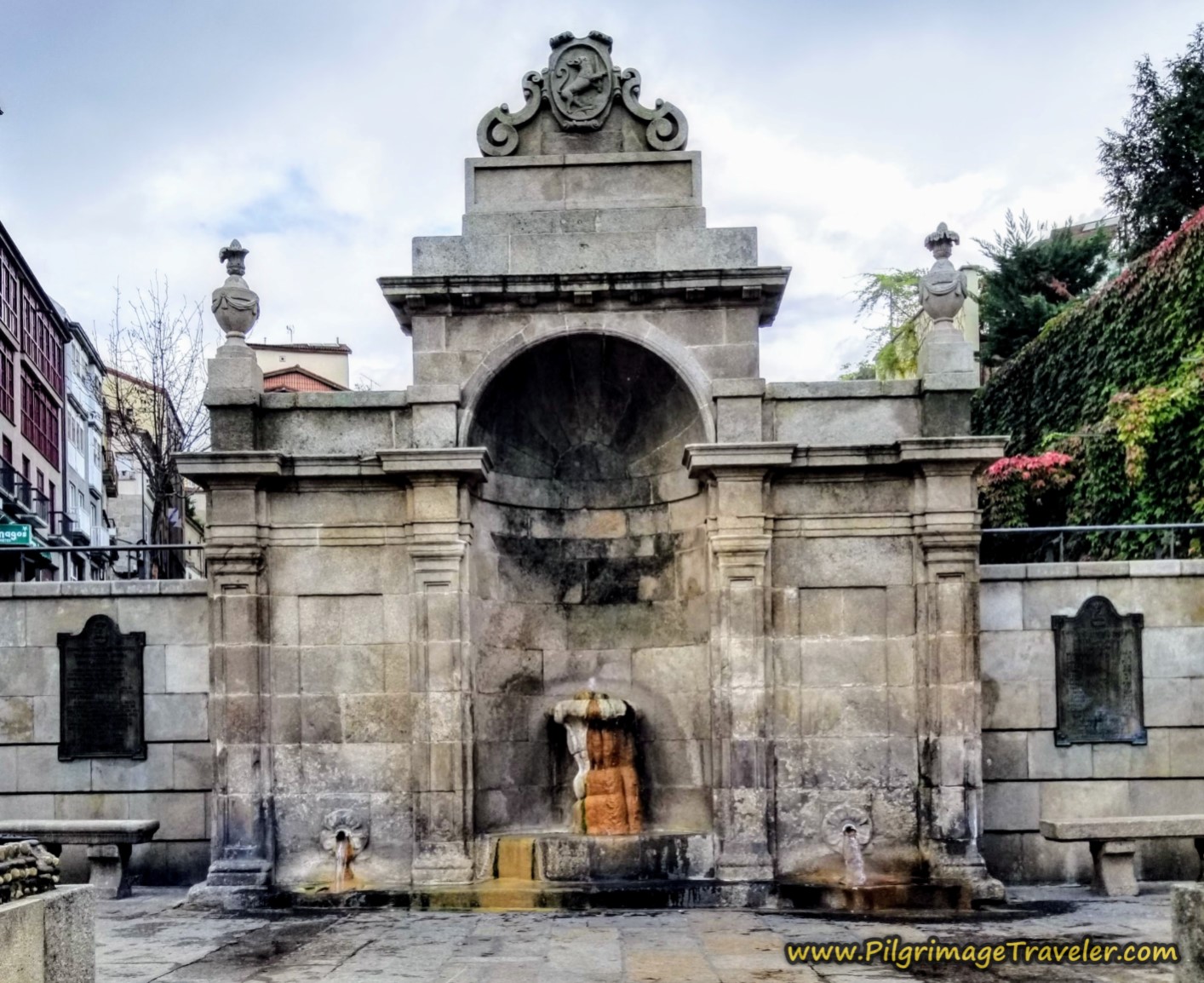
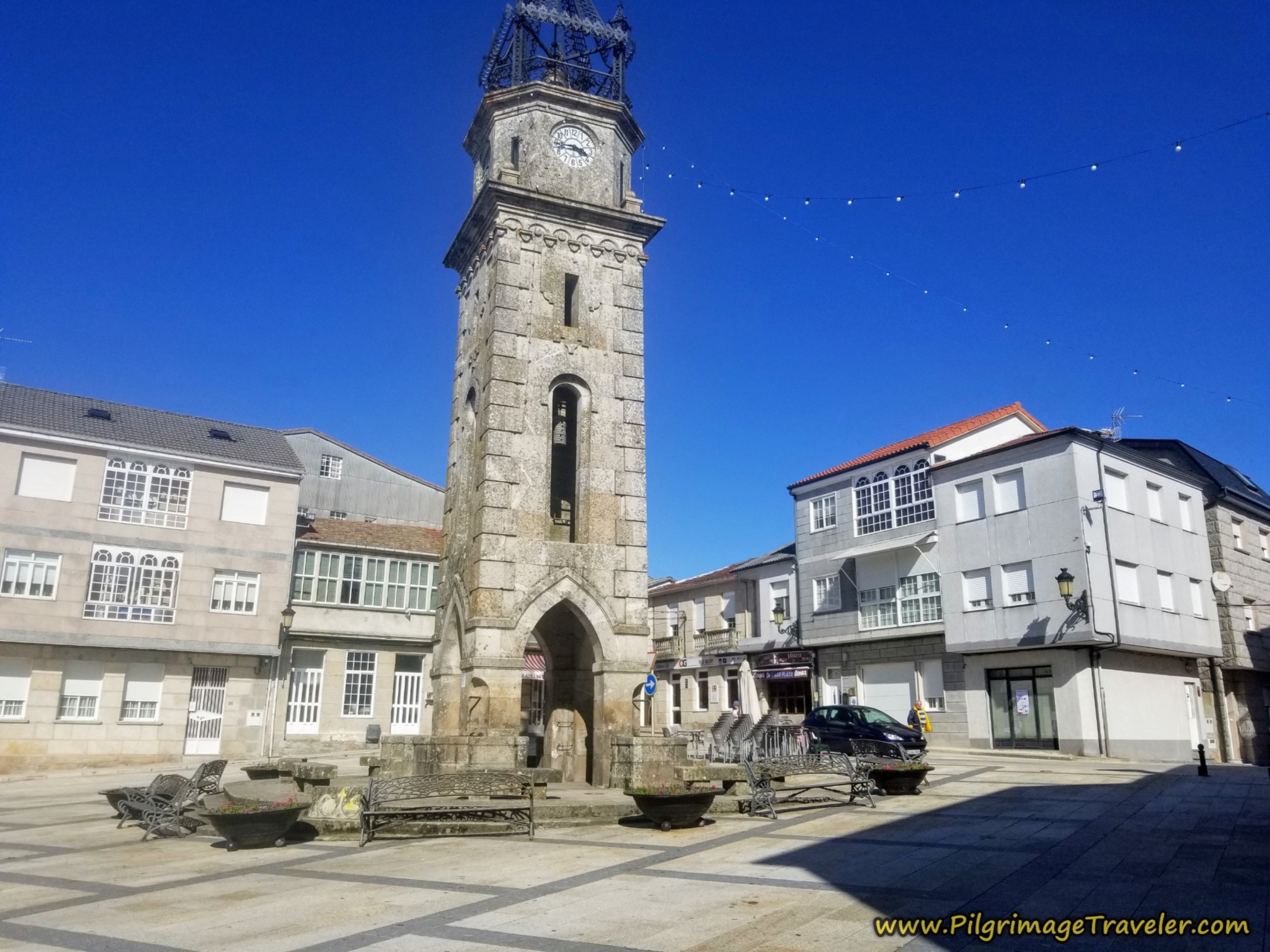
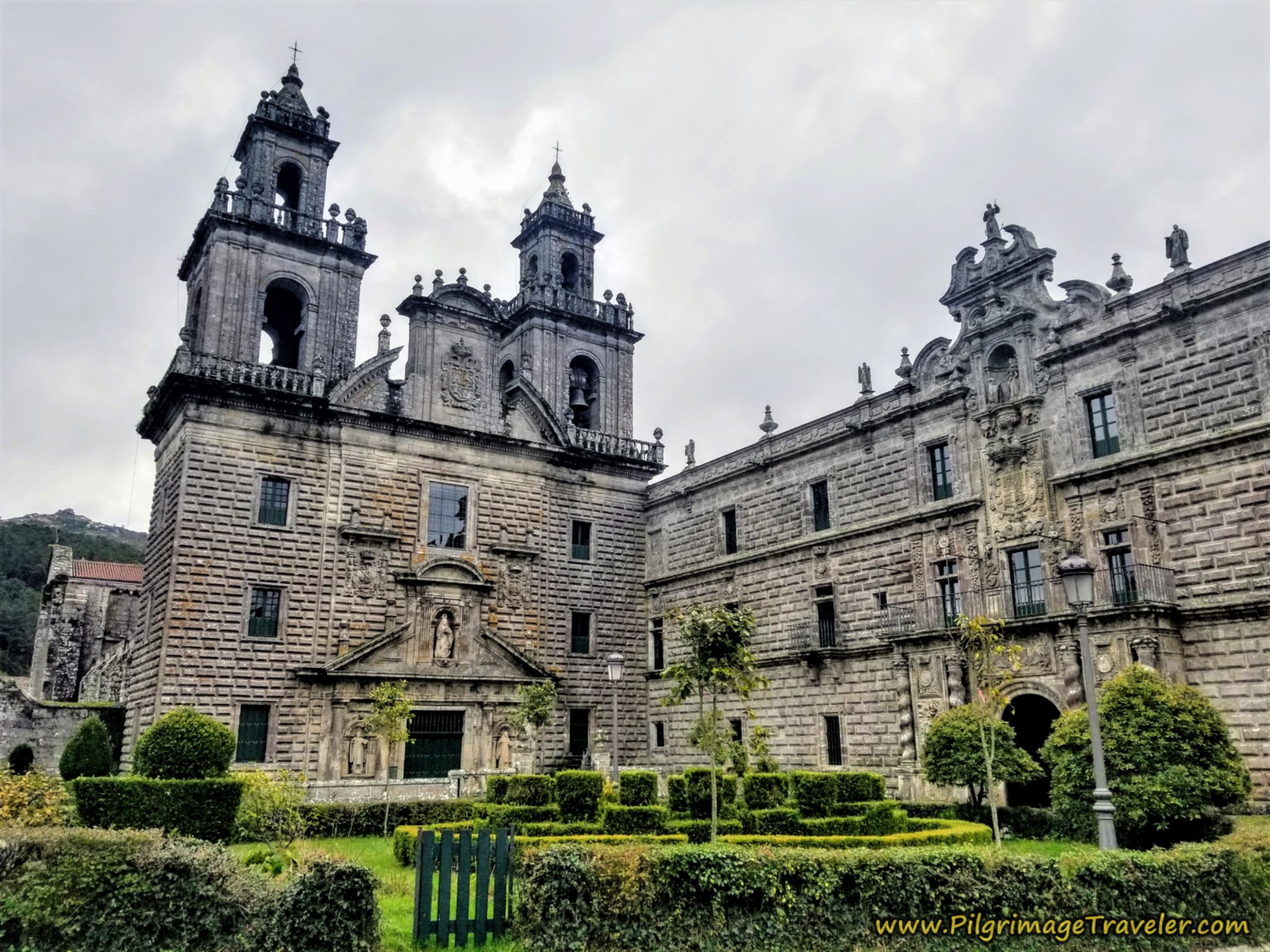
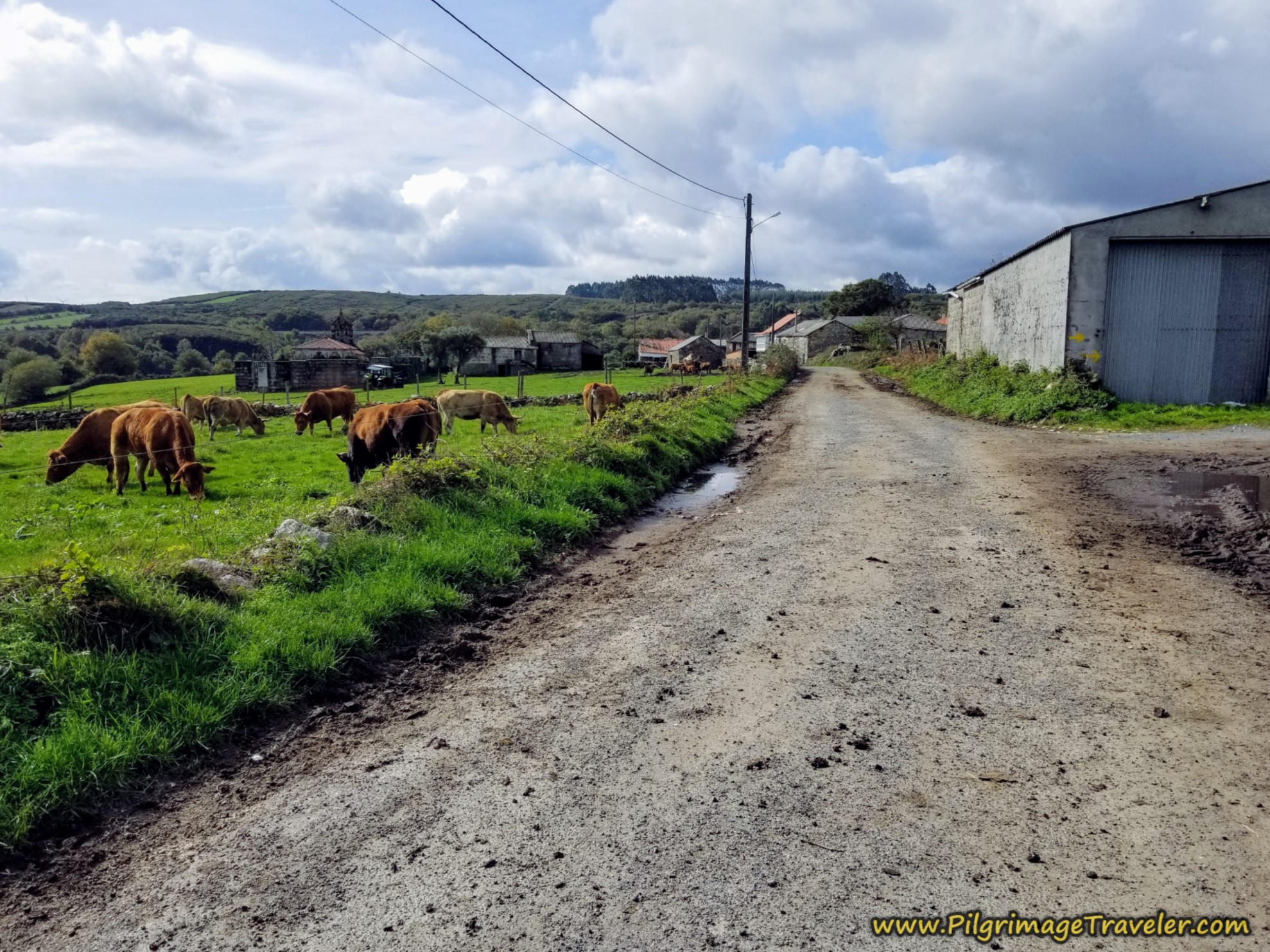
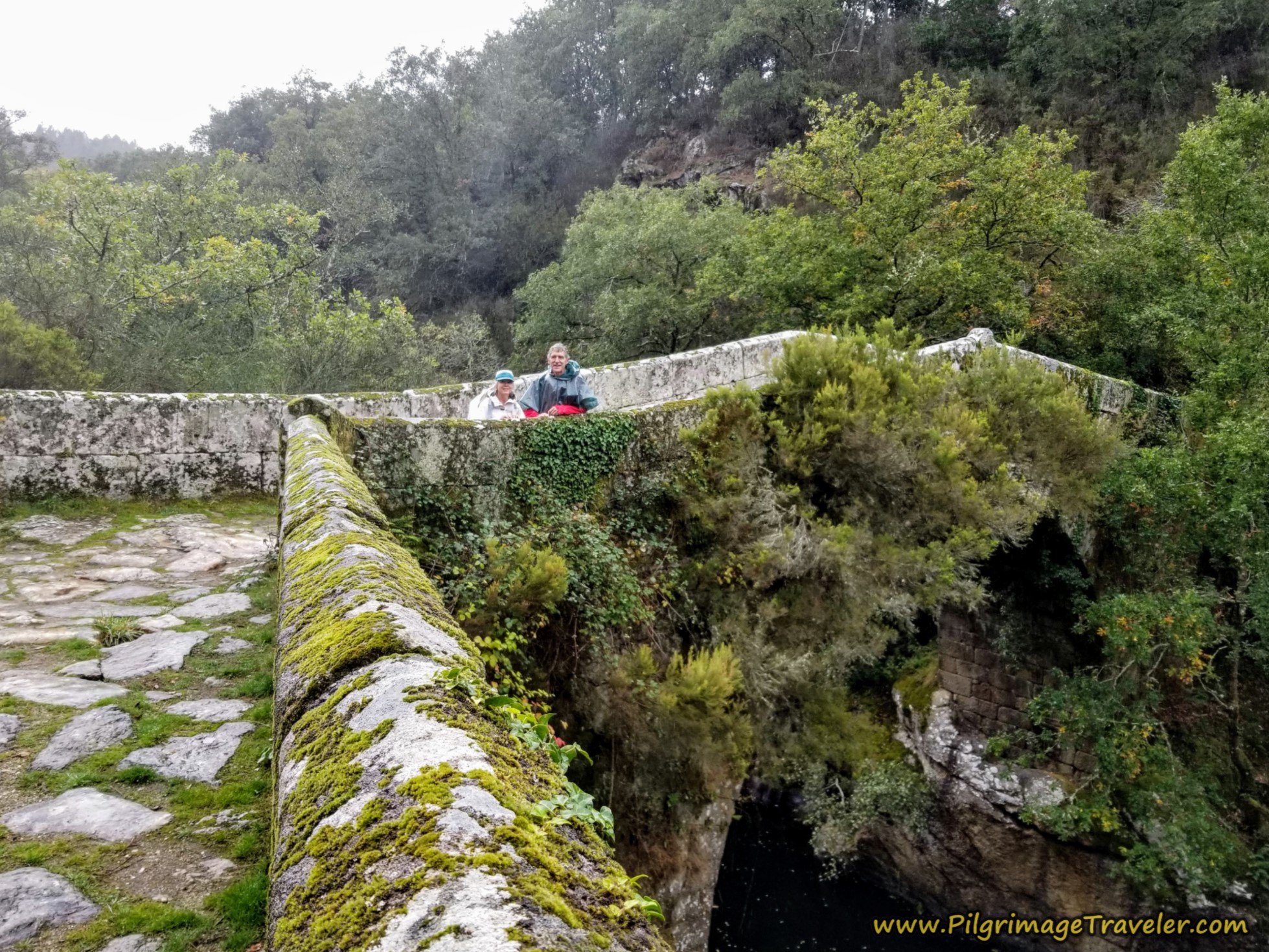
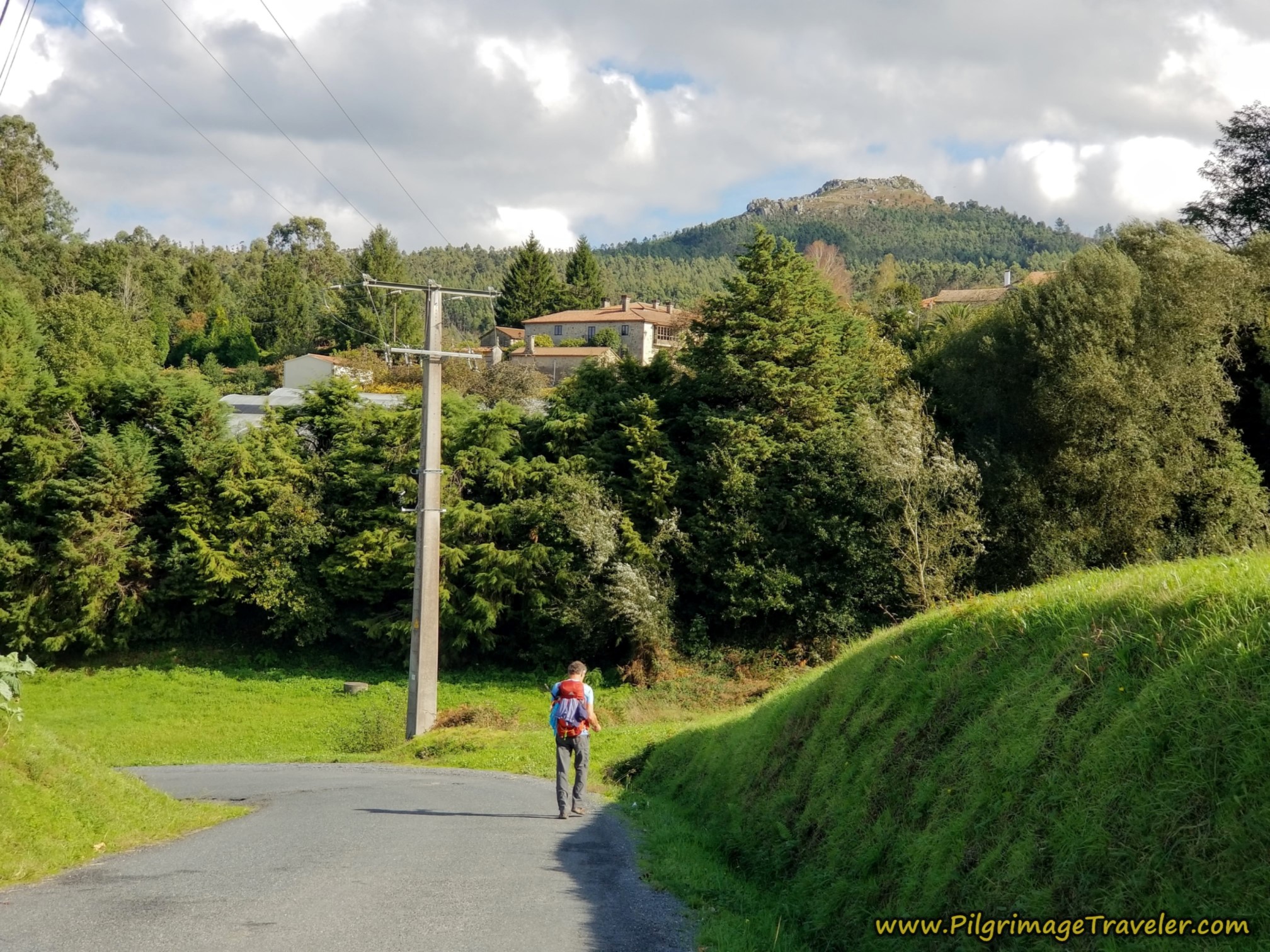
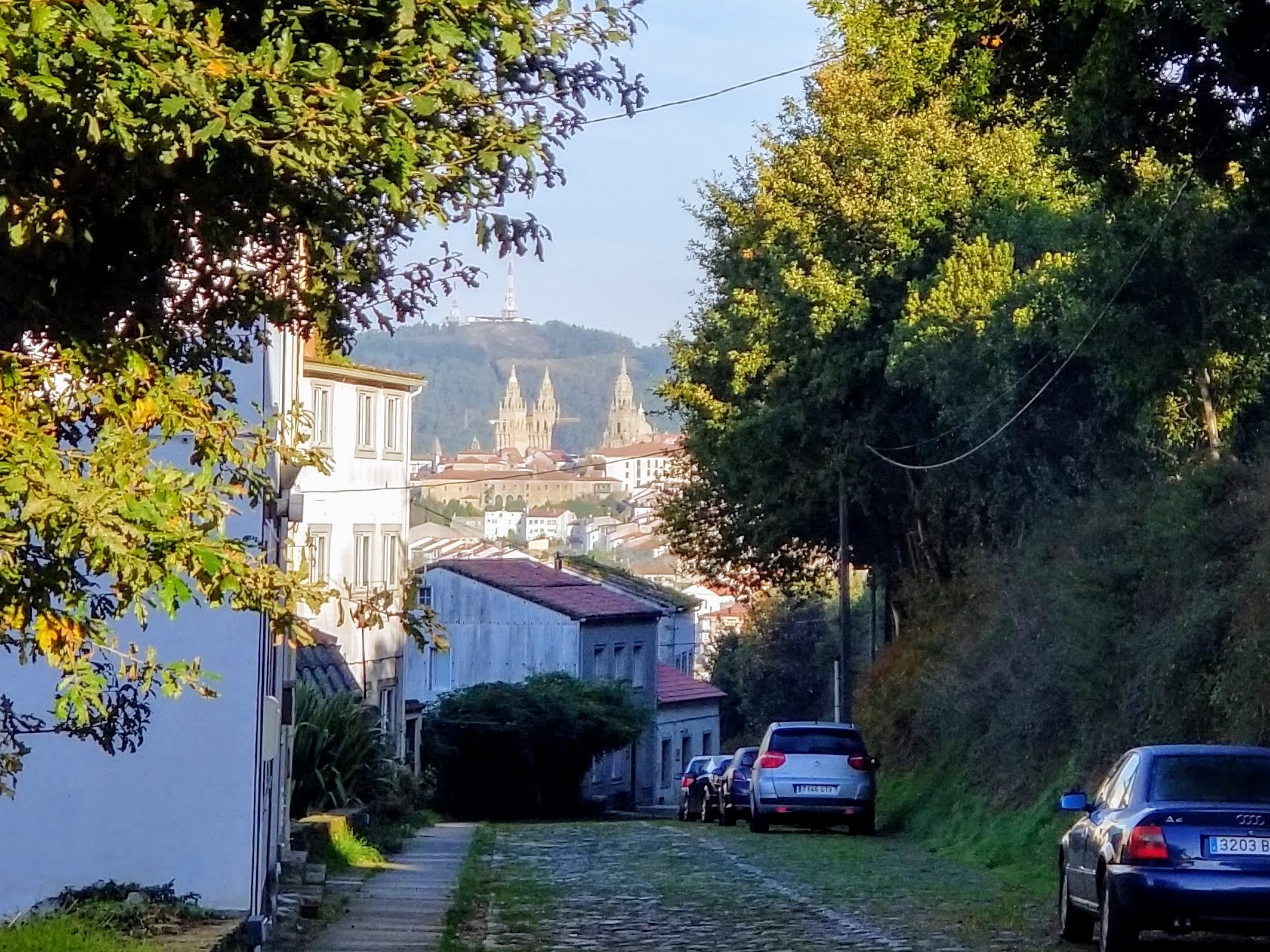














Your Opinion Matters! Comments
Have you had a similar experience, have some advice to give, or have something else you'd like to share? We would love to hear from you! Please leave us a comment in the box below.